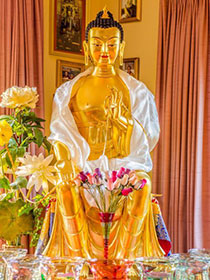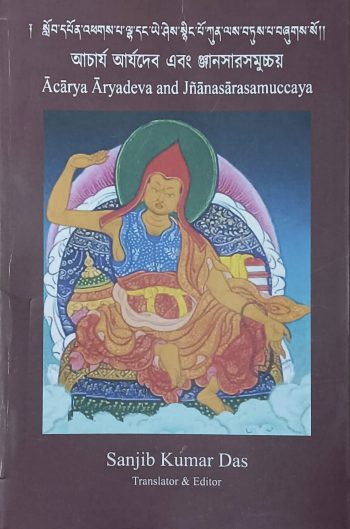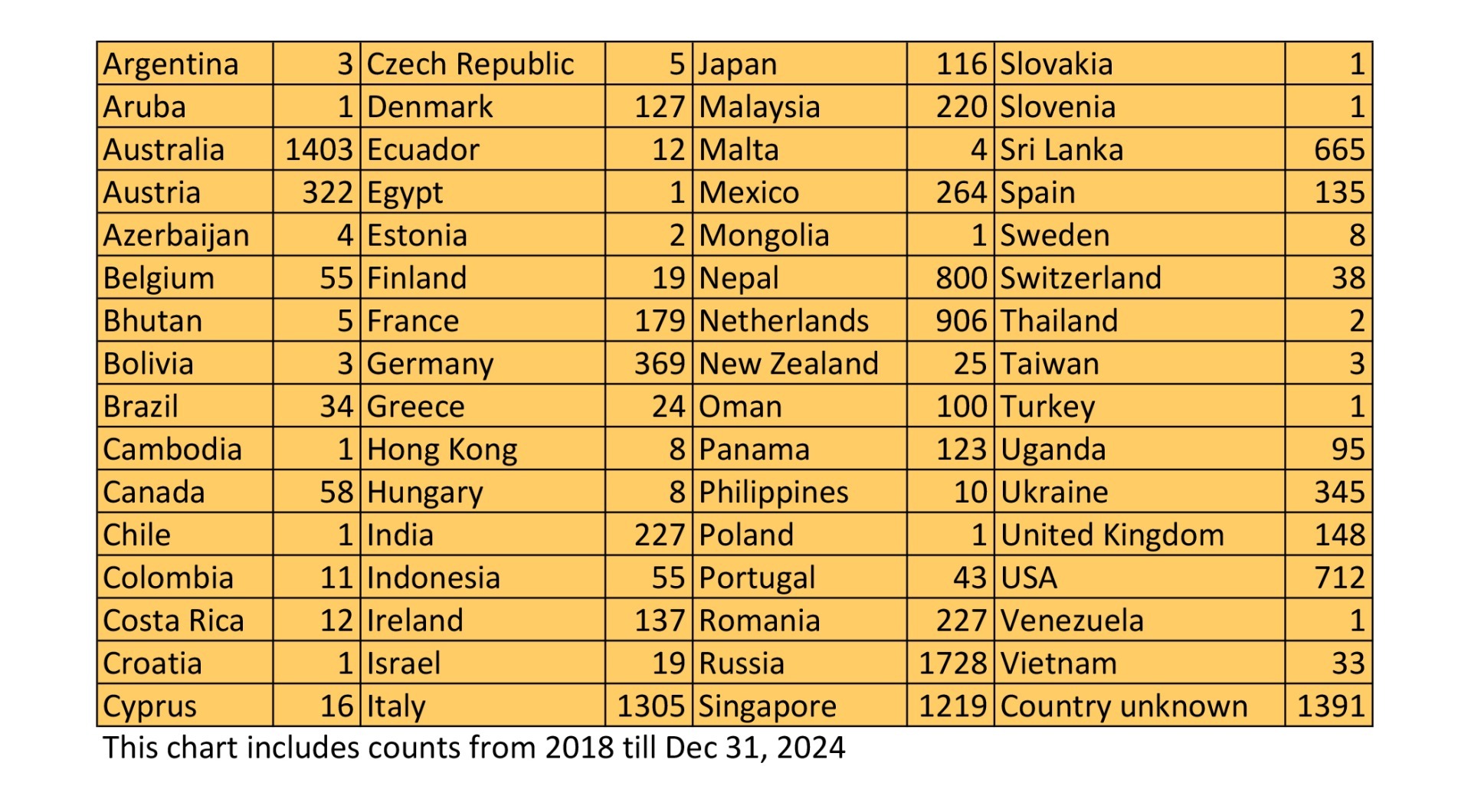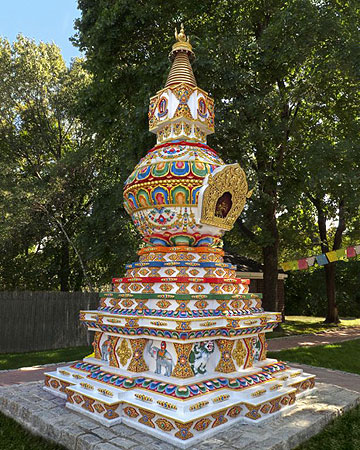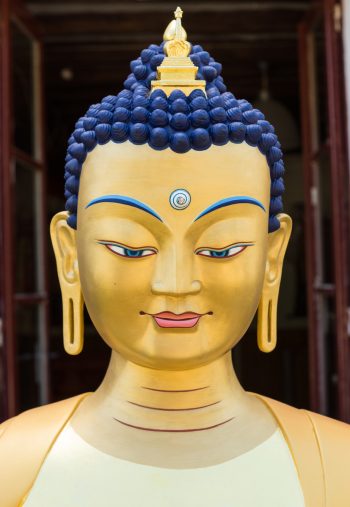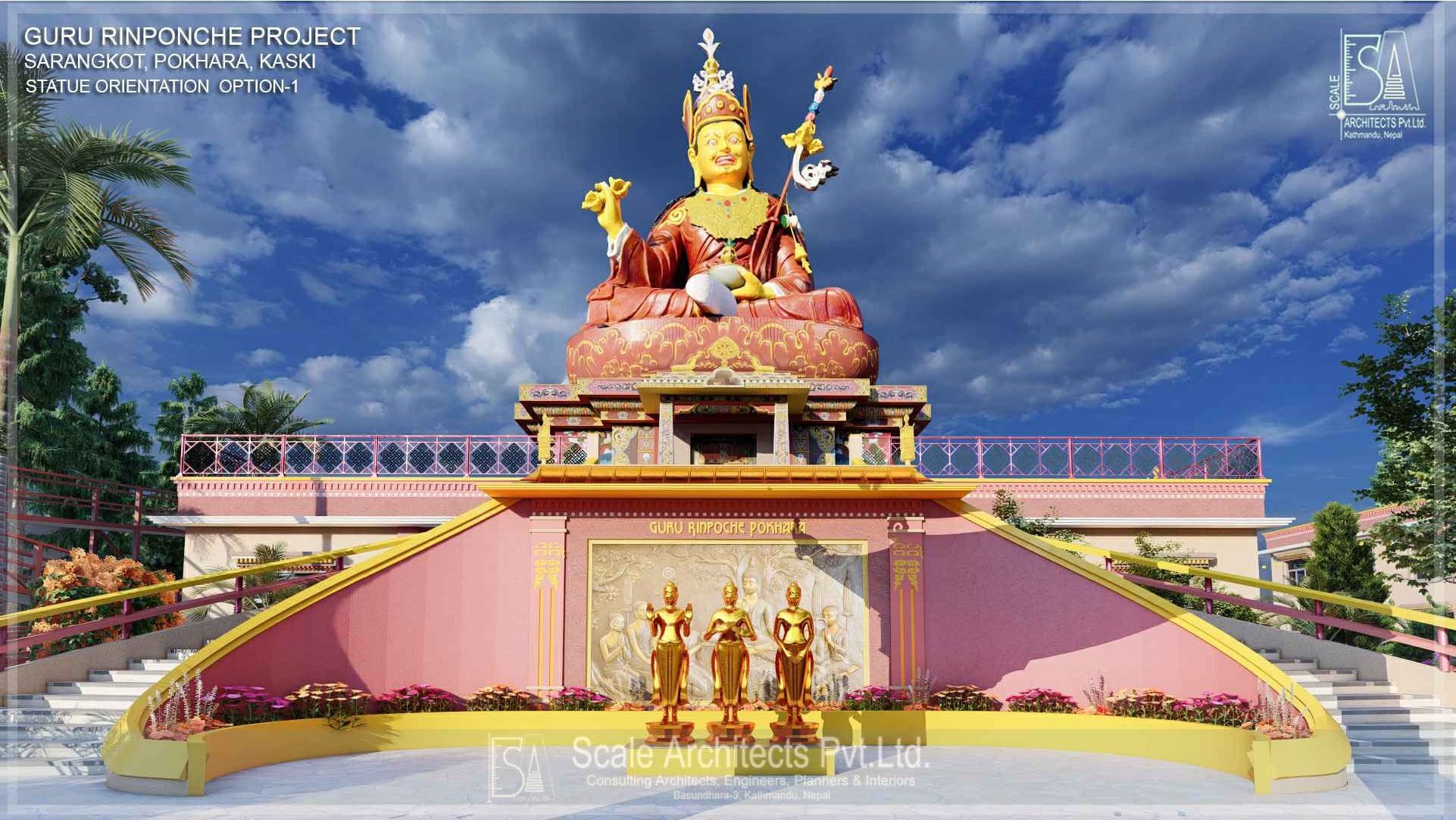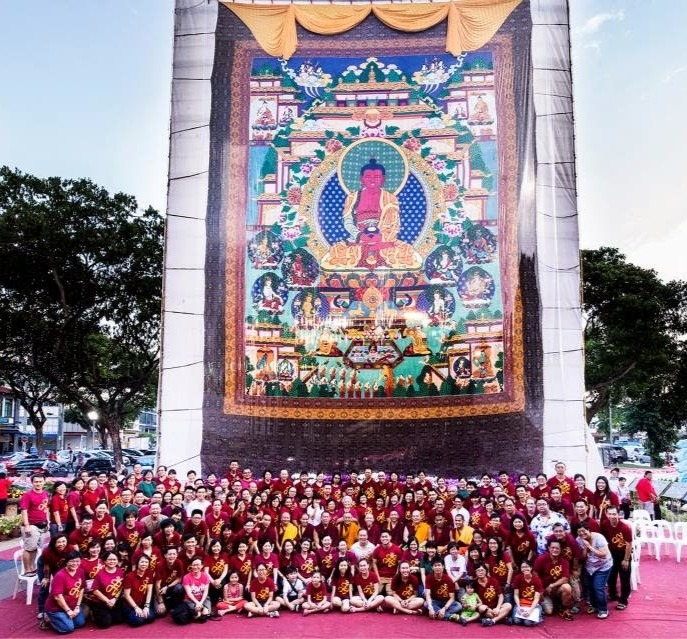- Home
- FPMT Homepage
Foundation for the Preservation of the Mahayana Tradition
The FPMT is an organization devoted to preserving and spreading Mahayana Buddhism worldwide by creating opportunities to listen, reflect, meditate, practice and actualize the unmistaken teachings of the Buddha and based on that experience spreading the Dharma to sentient beings. We provide integrated education through which people’s minds and hearts can be transformed into their highest potential for the benefit of others, inspired by an attitude of universal responsibility and service. We are committed to creating harmonious environments and helping all beings develop their full potential of infinite wisdom and compassion. Our organization is based on the Buddhist tradition of Lama Tsongkhapa of Tibet as taught to us by our founders Lama Thubten Yeshe and Lama Thubten Zopa Rinpoche.
- Willkommen
Die Stiftung zur Erhaltung der Mahayana Tradition (FPMT) ist eine Organisation, die sich weltweit für die Erhaltung und Verbreitung des Mahayana-Buddhismus einsetzt, indem sie Möglichkeiten schafft, den makellosen Lehren des Buddha zuzuhören, über sie zur reflektieren und zu meditieren und auf der Grundlage dieser Erfahrung das Dharma unter den Lebewesen zu verbreiten.
Wir bieten integrierte Schulungswege an, durch denen der Geist und das Herz der Menschen in ihr höchstes Potential verwandelt werden zum Wohl der anderen – inspiriert durch eine Haltung der universellen Verantwortung und dem Wunsch zu dienen. Wir haben uns verpflichtet, harmonische Umgebungen zu schaffen und allen Wesen zu helfen, ihr volles Potenzial unendlicher Weisheit und grenzenlosen Mitgefühls zu verwirklichen.
Unsere Organisation basiert auf der buddhistischen Tradition von Lama Tsongkhapa von Tibet, so wie sie uns von unseren Gründern Lama Thubten Yeshe und Lama Thubten Zopa Rinpoche gelehrt wird.
- Bienvenidos
La Fundación para la preservación de la tradición Mahayana (FPMT) es una organización que se dedica a preservar y difundir el budismo Mahayana en todo el mundo, creando oportunidades para escuchar, reflexionar, meditar, practicar y actualizar las enseñanzas inconfundibles de Buda y en base a esa experiencia difundir el Dharma a los seres.
Proporcionamos una educación integrada a través de la cual las mentes y los corazones de las personas se pueden transformar en su mayor potencial para el beneficio de los demás, inspirados por una actitud de responsabilidad y servicio universales. Estamos comprometidos a crear ambientes armoniosos y ayudar a todos los seres a desarrollar todo su potencial de infinita sabiduría y compasión.
Nuestra organización se basa en la tradición budista de Lama Tsongkhapa del Tíbet como nos lo enseñaron nuestros fundadores Lama Thubten Yeshe y Lama Zopa Rinpoche.
A continuación puede ver una lista de los centros y sus páginas web en su lengua preferida.
- Bienvenue
L’organisation de la FPMT a pour vocation la préservation et la diffusion du bouddhisme du mahayana dans le monde entier. Elle offre l’opportunité d’écouter, de réfléchir, de méditer, de pratiquer et de réaliser les enseignements excellents du Bouddha, pour ensuite transmettre le Dharma à tous les êtres. Nous proposons une formation intégrée grâce à laquelle le cœur et l’esprit de chacun peuvent accomplir leur potentiel le plus élevé pour le bien d’autrui, inspirés par le sens du service et une responsabilité universelle. Nous nous engageons à créer un environnement harmonieux et à aider tous les êtres à épanouir leur potentiel illimité de compassion et de sagesse. Notre organisation s’appuie sur la tradition guéloukpa de Lama Tsongkhapa du Tibet, telle qu’elle a été enseignée par nos fondateurs Lama Thoubtèn Yéshé et Lama Zopa Rinpoché.
Visitez le site de notre Editions Mahayana pour les traductions, conseils et nouvelles du Bureau international en français.
Voici une liste de centres et de leurs sites dans votre langue préférée
- Benvenuto
L’FPMT è un organizzazione il cui scopo è preservare e diffondere il Buddhismo Mahayana nel mondo, creando occasioni di ascolto, riflessione, meditazione e pratica dei perfetti insegnamenti del Buddha, al fine di attualizzare e diffondere il Dharma fra tutti gli esseri senzienti.
Offriamo un’educazione integrata, che può trasformare la mente e i cuori delle persone nel loro massimo potenziale, per il beneficio di tutti gli esseri, ispirati da un’attitudine di responsabilità universale e di servizio.
Il nostro obiettivo è quello di creare contesti armoniosi e aiutare tutti gli esseri a sviluppare in modo completo le proprie potenzialità di infinita saggezza e compassione.
La nostra organizzazione si basa sulla tradizione buddhista di Lama Tsongkhapa del Tibet, così come ci è stata insegnata dai nostri fondatori Lama Thubten Yeshe e Lama Zopa Rinpoche.
Di seguito potete trovare un elenco dei centri e dei loro siti nella lingua da voi prescelta.
- 欢迎 / 歡迎
简体中文
“护持大乘法脉基金会”( 英文简称:FPMT。全名:Foundation for the Preservation of the Mahayana Tradition) 是一个致力于护持和弘扬大乘佛法的国际佛教组织。我们提供听闻,思维,禅修,修行和实证佛陀无误教法的机会,以便让一切众生都能够享受佛法的指引和滋润。
我们全力创造和谐融洽的环境, 为人们提供解行并重的完整佛法教育,以便启发内在的环宇悲心及责任心,并开发内心所蕴藏的巨大潜能 — 无限的智慧与悲心 — 以便利益和服务一切有情。
FPMT的创办人是图腾耶喜喇嘛和喇嘛梭巴仁波切。我们所修习的是由两位上师所教导的,西藏喀巴大师的佛法传承。
繁體中文
護持大乘法脈基金會”( 英文簡稱:FPMT。全名:Found
ation for the Preservation of the Mahayana Tradition ) 是一個致力於護持和弘揚大乘佛法的國際佛教組織。我們提供聽聞, 思維,禪修,修行和實證佛陀無誤教法的機會,以便讓一切眾生都能 夠享受佛法的指引和滋潤。 我們全力創造和諧融洽的環境,
為人們提供解行並重的完整佛法教育,以便啟發內在的環宇悲心及責 任心,並開發內心所蘊藏的巨大潛能 — 無限的智慧與悲心 – – 以便利益和服務一切有情。 FPMT的創辦人是圖騰耶喜喇嘛和喇嘛梭巴仁波切。
我們所修習的是由兩位上師所教導的,西藏喀巴大師的佛法傳承。 察看道场信息:
- FPMT Homepage
- News/Media
-
- Study & Practice
-
-
- About FPMT Education Services
- Latest News
- Programs
- New to Buddhism?
- Buddhist Mind Science: Activating Your Potential
- Heart Advice for Death and Dying
- Discovering Buddhism
- Living in the Path
- Exploring Buddhism
- FPMT Basic Program
- FPMT Masters Program
- FPMT In-Depth Meditation Training
- Maitripa College
- Lotsawa Rinchen Zangpo Translator Program
- Universal Education for Compassion & Wisdom
- Online Learning Center
-
- Prayers & Practice Materials
- Overview of Prayers & Practices
- Full Catalogue of Prayers & Practice Materials
- Explore Popular Topics
- Benefiting Animals
- Chenrezig Resources
- Death & Dying Resources
- Lama Chopa (Guru Puja)
- Lama Zopa Rinpoche: Compendium of Precious Instructions
- Lama Zopa Rinpoche: Life Practice Advice
- Lama Zopa Rinpoche Practice Series
- Lamrim Resources
- Mantras
- Prayer Book Updates
- Purification Practices
- Sutras
- Thought Transformation (Lojong)
- Audio Materials
- Dharma Dates - Tibetan Calendar
- Translation Services
- Publishing Services
- Ways to Offer Support
- Prayers & Practice Materials
-
- Teachings and Advice
- Find Teachings and Advice
- Lama Zopa Rinpoche Advice Page
- Lama Zopa Rinpoche: Compendium of Precious Instructions
- Lama Zopa Rinpoche Video Teachings
- ༧སྐྱབས་རྗེ་བཟོད་པ་རིན་པོ་ཆེ་མཆོག་ནས་སྩལ་བའི་བཀའ་སློབ་བརྙན་འཕྲིན།
- Podcasts
- Lama Yeshe Wisdom Archive
- Buddhism FAQ
- Dharma for Young People
- Resources on Holy Objects
- Teachings and Advice
-
-
*If a menu item has a submenu clicking once will expand the menu clicking twice will open the page.
-
-
- Centers
-
- Teachers
-
- Projects
-
-
-
-
*If a menu item has a submenu clicking once will expand the menu clicking twice will open the page.
-
-
- FPMT
-
-
-
-
-
Many times we mix our compassion with attachment. We begin with compassion, but after some time, attachment mixes in and then it becomes an attachment trip.
Lama Thubten Yeshe
-
-
-
- Shop
-
-
-
The Foundation Store is FPMT’s online shop and features a vast selection of Buddhist study and practice materials written or recommended by our lineage gurus. These items include homestudy programs, prayers and practices in PDF or eBook format, materials for children, and other resources to support practitioners.
Items displayed in the shop are made available for Dharma practice and educational purposes, and never for the purpose of profiting from their sale. Please read FPMT Foundation Store Policy Regarding Dharma Items for more information.
-
-
Projects
16
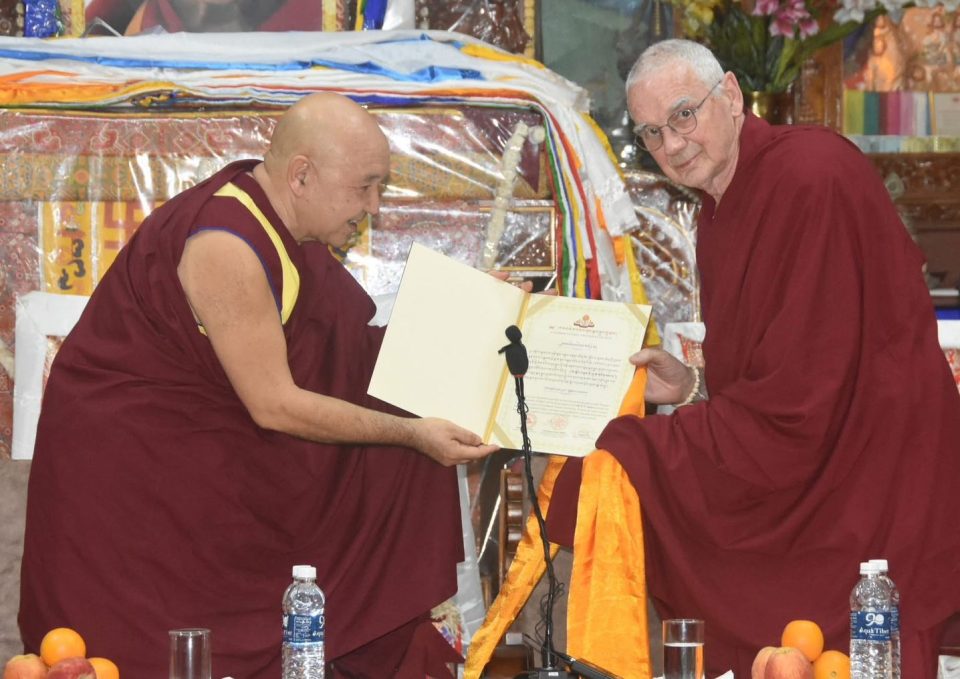
Ven. Roger Kunsang receiving a certificate of thanks from Khen Rinpoche Geshe Ngawang Sangye, on behalf of Lama Zopa Rinpoche and the FPMT organization for the offerings made towards the Gyudmed Monastery Food Fund. (close up of certificate can be seen below).
Supporting monks and nuns is one of the highest priorities for the FPMT organization, because the preservation of the Buddhadharma is dependent on the existence of Sangha. The Supporting Ordained Sangha Fund (SOSF) was created to uphold this commitment by offering practical and compassionate assistance to ordained individuals and communities around the world.
The scope of the SOSF is broad and inclusive – it provides support for food, accommodation, health care, education, and practice to monasteries, nunneries, and individual Sangha members across many traditions and regions. The fund is not limited to any one institution, allowing it to respond flexibly and generously to the needs of the global Sangha.
In 2025, we were honored to have offered a total of US$932,361 in grants, helping ensure that monks and nuns can live, study, and practice with dignity and stability. Two of these grants fulfilled long-standing commitments made by Lama Zopa Rinpoche, allowing us to bring two of Rinpoche’s heartfelt wishes to completion in 2025. Please join us in rejoicing in these offerings to the Sangha and we invite you to take a closer look at the various ways we have been able to offer this collective support.
Gyudmed Food Fund | Ribur Rinpoche Tenzin Pasang | Tashi Chime Gatsal Gumba | Jamyang Buddhist Centre | International Mahayana Institute | Nalanda Monastery | Thame Dechen Chokhorling Monastery | Zigar Thupten Shedrupling Institute | Shalu Monastery | Osel Labrang at Sera Jey | Idgaa Choizinling Monastery | Geshe Support | Thank you!
Founded in 1433 by Jetsun Sherab Sengye, a direct disciple of Lama Tsongkhapa, Gyudmed Tantric University is one of the most important centers for Tantric studies in the Gelugpa tradition of Tibetan Buddhism. Lama Tsongkhapa personally appointed Jetsun Sherab Sengye as His spiritual successor in Tantra, entrusting him with the preservation and transmission of the Tantric lineage.
Inspired by ancient Indian universities like Nalanda, Gyudmed was established to complement the Sutra-focused institutions of Sera, Drepung, and Ganden Monasteries. It became a hub for Tantra philosophy, mandala construction, ritual arts, and intact lineage transmission, including teachings on Guhyasamaja and other deities.
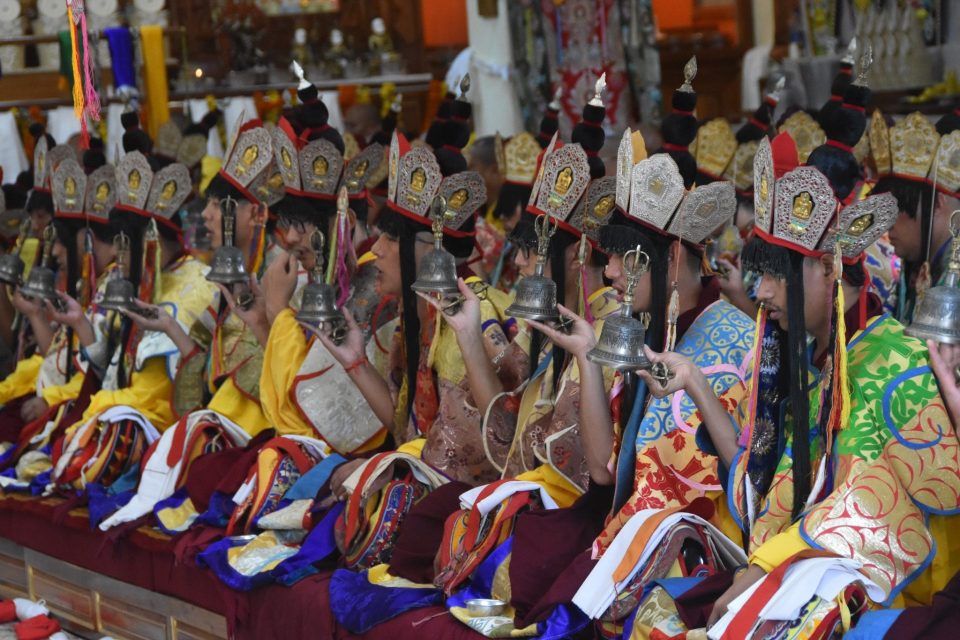
Gyudmed monks engaged in puja.
Following the 1959 Tibetan uprising, 150 monks from Gyudmed fled to India and temporarily settled in Dalhousie. In 1972, with support from His Holiness the 14th Dalai Lama and the Government of Karnataka, the monastery was permanently relocated to Gurupura, South India. Today, it houses over 600 monks and continues to uphold its rich Tantric traditions.
Gyudmed offers a 15-year curriculum combining Sutra and Tantra studies. Monks engage in daily memorization, chanting, and evening debates. Upon completion, monks earn the Geshe Ngarampa degree, recognized by the Central Tibetan Administration (CTA). Each year, Geshes from major monasteries undertake a one-year Tantra course at Gyudmed, culminating in examinations witnessed by abbots of the six great monasteries.
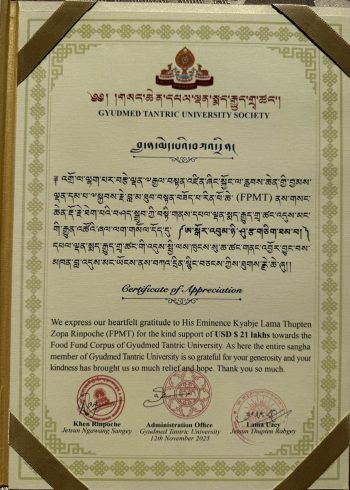
Certificate of thanks offered to Ven. Roger Kunsang from Gyudmed Monastery.
Unfortunately, Gyudmed Monastery has no stable source of income, particularly to meet the daily food needs of its monks. Recognizing this urgent need, the monastery requested Lama Zopa Rinpoche and the FPMT to establish a long-term solution. Rinpoche immediately accepted, and the Gyudmed Food Fund was created in 2021 to provide reliable, lasting support.
In 2025, we were able to fulfill Rinpoche’s commitment and four installments totaling US$681,942 were offered toward the Gyudmed Food Fund. Most of this money raised in 2025 was from specific private donations, thus we were able to also preserve the existing funds in SOSF. With this contribution, we have now completed the US$2.1 million endowment, which will ensure that all Gyudmed Tantric University’s food expenses are covered sustainably from the interest. Please rejoice in this incredible offering and achievement, in fulfilling one of Rinpoche’s heart requests and in the long term sustainability that we as an organization are offering to the Sangha of Gyudmed. In November 2025, Ven. Roger Kunsang went to Gyudmed to make the final offering in person, on behalf of FPMT and Lama Zopa Rinpoche.
On behalf of the current Ribur Rinpoche Tenzin Pasang, a request was made for financial support to complete renovations at his Labrang (residence) at Sera Mey Monastery, India. The residence was originally built by the previous Ribur Rinpoche, a highly realized master and guru of Kyabje Lama Zopa Rinpoche, to serve as a place for study and practice for his future incarnation.
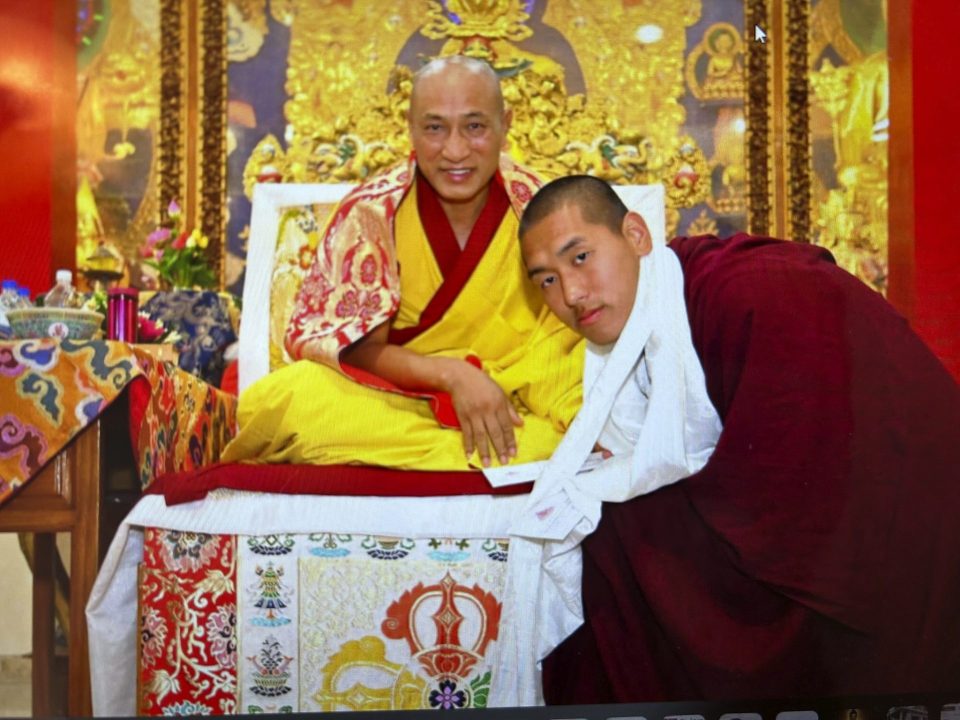
Ribur Rinpoche Tenzin Pasang with the current Abbot of Sera Mey Monastery Khen Rinpoche Neten Rinpoche.
In 2025, the SOSF offered a grant toward this project, honoring the lineage and ensuring the continuity of Dharma activities.
Nestled in the serene hills of Bigu, Northeastern Nepal, Tashi Chime Gatsal Gumba is a small Drikung Kagyu nunnery with a profound spiritual connection to Lama Zopa Rinpoche, who once described it as “being in the lap of Mother Tara.” Rinpoche personally initiated a beautiful arrangement over 14 years ago: for the nunnery to offer 100 million mani retreats once or twice a year, dedicating the merit to benefit the entire FPMT organization.
To date, the nuns have completed an astonishing 26 retreats, totaling 2.6 billion recitations of OM MANI PADME HUM – a testament to their unwavering dedication and compassion.

Tashi Chime Gatsal Gumba nuns.
In 2025, the SOSF contributed US$31,166.23 to support the nunnery’s ongoing activities. This funding has been vital in sustaining both spiritual and educational efforts, including:
- 150 million mani retreats, with offerings to the Sangha upon completion.
- Medical care for the nuns, ensuring their well-being during intensive practice periods.
- Salaries for six teachers, allowing younger nuns to receive a secular education within the nunnery itself – eliminating the need for long, difficult walks to distant schools.
The nunnery’s expense report and receipt documents reflect careful stewardship of the funds, covering essentials such as fresh milk, firewood, gas, transportation, and medical costs. The nuns have expressed heartfelt gratitude to all benefactors and continue to dedicate their prayers for the long life of His Holiness the Dalai Lama, the swift return of Kyabje Lama Zopa Rinpoche, and the flourishing of the Buddhadharma.
For nearly 50 years, Jamyang Buddhist Centre in London has been a place of Tibetan Buddhist practice, education, and community life. Housed in the historic Old Lambeth Magistrates’ Court, the Centre has transformed a once-defensive civic building into a vibrant spiritual home rooted in compassion, inclusivity, and sustainability.

Rendering of a monastic bedroom at Jamyang Centre.
In 2025, the SOSF offered a grant of US$30,750 to support the Sanctuary Project, a visionary initiative to modernize and preserve this Grade II-listed building while expanding its role as a hub for learning, wellbeing, and social outreach. The project will provide expanded accommodation for monastics, teachers, and volunteers, alongside new accessible facilities including a lift, ramps, and inclusive design features. Environmental upgrades such as air source heat pumps, solar panels, and sustainable building materials will ensure that the Centre embodies ecological responsibility, while careful restoration will preserve its heritage character.
The Sanctuary Project also envisions revitalized gardens, with the north side becoming a contemplative space and the south courtyard opening as a community area with edible plants, prayer wheels, and water features. Inside, new teaching and gathering spaces will be created, including a renovated basement and improved access to the Temple, ensuring the Centre can welcome more people in meaningful ways.
Guided by the Buddhist principles of interdependence, non-harm, and care for all beings, Jamyang is shaping a true living sanctuary, a place where people from all walks of life can find peace, purpose, and connection.
In 2025, the SOSF granted US$1,038 to the International Mahayana Institute (IMI) to support its new Video Sharing Experience Project.
This initiative will produce a series of short, professionally edited videos, each lasting 5–10 minutes, featuring IMI monks and nuns as they share their personal experiences, challenges, and insights as ordained practitioners. The content will address questions collected from FPMT centers and aims to:
- Bridge the gap between laypeople and the Sangha.
- Provide guidance and inspiration for FPMT center staff, students, and those considering ordination.
- Make teachings accessible in multiple languages (English, Spanish, French, and Italian).
Currently in its early stages, the project already has at least seven ordained participants and several topics planned. Its goal is to create a meaningful resource that nurtures understanding, connection, and spiritual growth throughout the global FPMT community.
In 2025, the SOSF contributed US$5,000 to Nalanda Monastery, a long-established FPMT-affiliated monastic community in France.
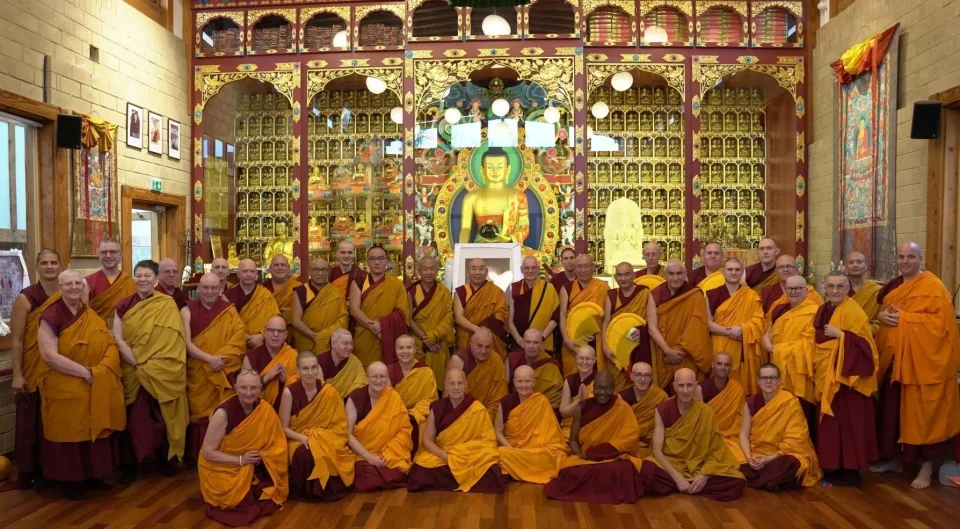
The first Gelug Monlam Festival in Europe, February 23-25, 2024, at Nalanda Monastery.
The grant supported two essential initiatives:
- Cavimac Insurance Support – US$3,500
Nalanda Monastery sought assistance to cover Cavimac, France’s private social and health insurance program for religious communities. The monastery pays about €3,300 each month to insure six monks who are not covered by their home countries. With an aging community and limited regular income, this support ensures the monks have access to healthcare and can legally reside at Nalanda. While donors often prefer to fund visible projects, such as building works or statues, the monastery emphasized that health insurance is a vital yet often overlooked need.
- Poor Monks Fund – US$1,500
The Poor Monks Fund provides emergency financial assistance to monks without personal income or savings. It helps cover travel expenses for visiting family or attending teachings, as well as medical costs not covered by insurance or IMI. By allowing the monastery to respond quickly to urgent needs without relying on direct donations to individuals, the fund offers both dignity and security. Nalanda expressed the hope that this fund will grow, as many monks hesitate to draw on it when resources are scarce.
Perched nearly 4,000 meters above sea level in the Solu Khumbu region, Nepal, Thame Dechen Chokhorling Monastery continues to be a spiritual sanctuary for the Himalayan community. As the birthplace of Lama Zopa Rinpoche and near the retreat cave of his previous incarnation, Lawudo Lama Kunsang Yeshe, Thame holds a special place in the heart of the FPMT family.
In 2023, the monks of Thame offered special daily prayers during the 49 days after Lama Zopa Rinpoche has shown the aspect of passing in front of Rinpoche’s kundung (holy body) in Kopan Monastery. In 2024, they participated in the consecration of the Victory Stupa in Lawudo, built for Rinpoche’s swift return. Their continued prayers and practice reflect a deep spiritual bond and commitment to Rinpoche’s vision.
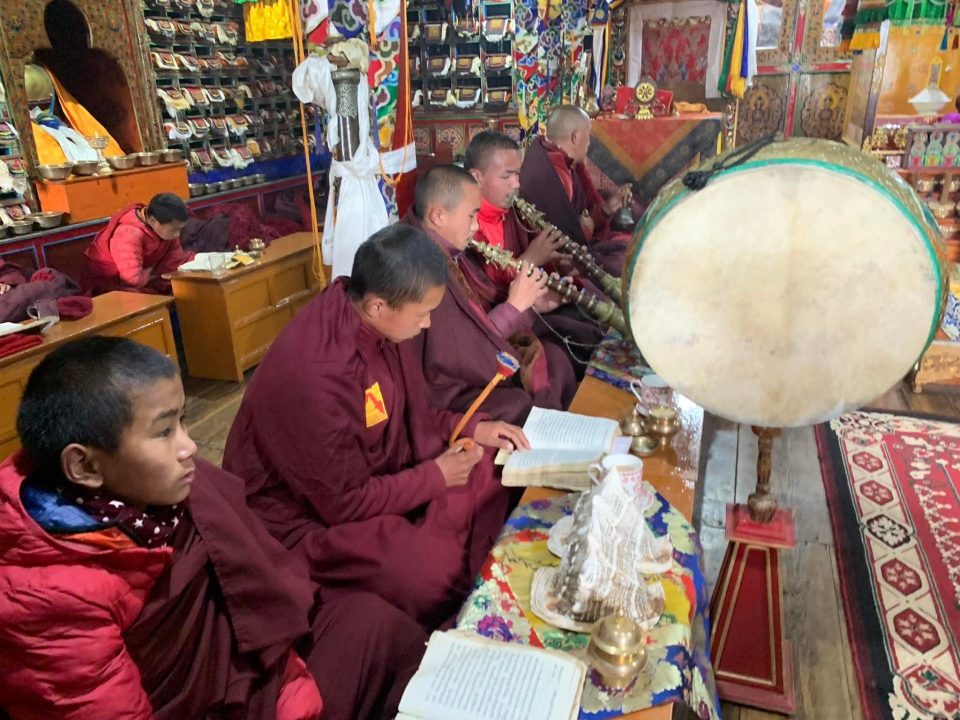
Thame monks performing a puja.
In 2025, the SOSF contributed US$9,106.28 to support the daily food needs of the 22 resident monks at Thame Monastery. This ongoing sponsorship, which began in 2017, ensures that the Sangha receives three nourishing meals a day, along with support for food transport and cook salaries.
In a heartfelt letter dated April 29, 2025, the monastery expressed profound gratitude for the support and shared their joy at the recent announcement by the FPMT and His Holiness the Dalai Lama, confirming that the reincarnation of Kyabje Lama Zopa Rinpoche has been born in Nepal and is yet to be discovered. The monks continue to offer daily prayers with deep devotion and hope.
Zigar Thupten Shedrupling Institute, nestled in the serene hills of Darjeeling, West Bengal, India, is dedicated to preserving the Drukpa Kargyud lineage. The monastery traces its origins to the first Zigar Rinpoche, Sonam Gyatsho (1608–1669), regarded as a manifestation of Guru Padmasambhava. Successive Zigar Rinpoches are recognized as incarnations of King Trisong Detsen, an emanation of Manjushri, the Wisdom Buddha.
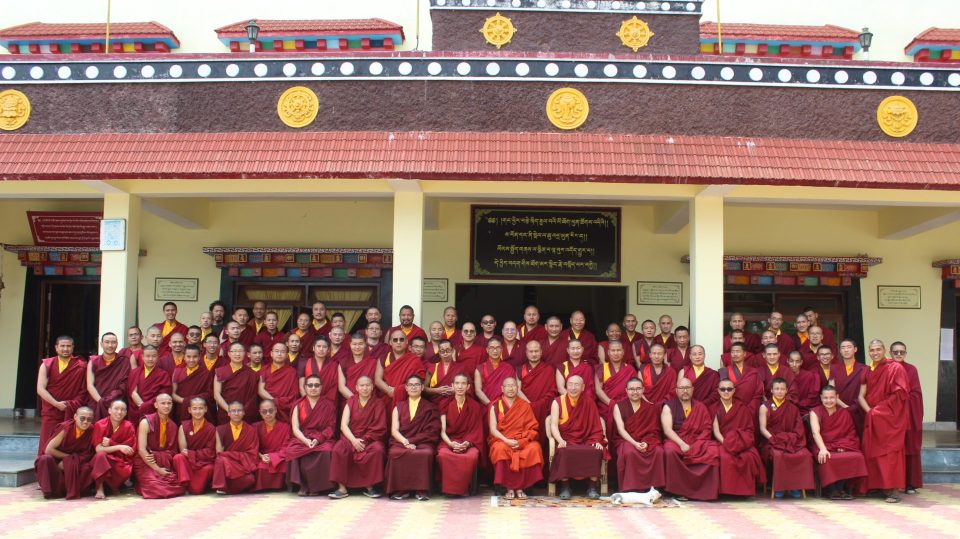
Zigar monks.
This is also the monastery of one of Lama Zopa Rinpoche’s own gurus – Khenpo Thinley Dorje, who attended the second anniversary since Rinpoche has shown the aspect of passing at Kopan Monastery. Although he does not reside at Zigar Monastery permanently, he helps guide the monastery, and Lama Zopa Rinpoche wished to support him in this way.
Since 2019, the SOSF has been honored to provide ongoing support for the monastery’s food expenses, ensuring that the monks are properly nourished and able to continue their studies and practice.
In 2025, SOSF contributed US$122,033, completing Lama Zopa Rinpoche’s compassionate pledge of US$200,000 specifically for food at the monastery. With these final installments, the pledge has now been fully realized, offering vital nourishment to the monastic community and sustaining the flourishing of this monastery.
In the peaceful foothills of Himachal Pradesh, India, Shalu Monastery continues its mission of reviving the Bhulug lineage tradition of Tibetan Buddhism. Founded by the great Sakya master Buton Rinchen Drub, this lineage is cherished for its depth of scholarship and spiritual clarity. With the blessings of His Holiness the 14th Dalai Lama, Shalu Monastery has become a vibrant center of study, prayer, and community.
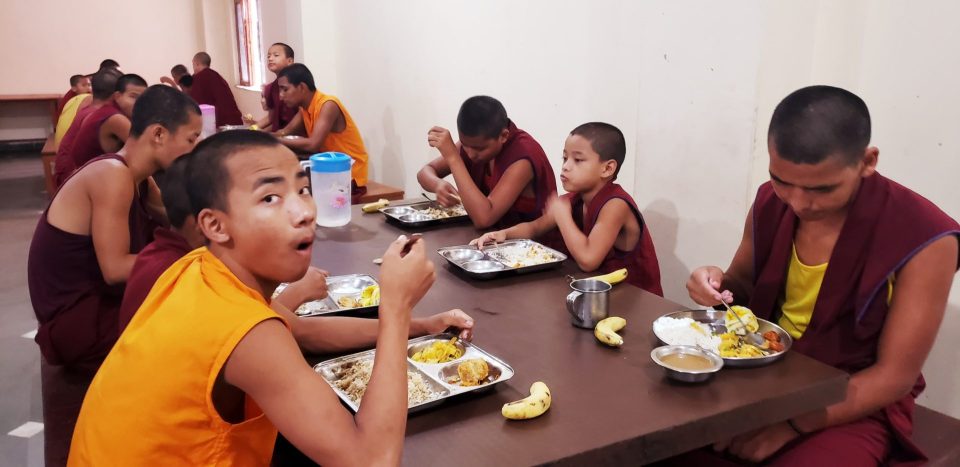
Shalu monks are enjoying their lunch.
In 2025, the SOSF contributed US$12,093 to support annual food needs of the monks of Shalu Monastery. This support has been a lifeline since 2018, helping the Shalu Sangha overcome previous hardships and ensuring they receive nourishing meals while continuing their studies and practice.
In a series of letters, the monastery expressed deep gratitude for this ongoing support. The monks shared that they are in good health, studying diligently, and joyfully engaging in their summer retreat. They emphasized how the food funding has made a tangible difference in their daily lives and spiritual practice.
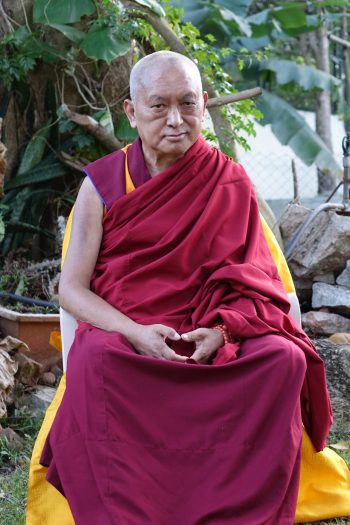
ama Zopa Rinpoche in the garden at Osel Labrang, Sera Jey Monastery, India, December 2015.
Photo: Ven. Roger Kunsang.
The monks continue to offer daily prayers and pujas for the swift return of Kyabje Lama Zopa Rinpoche. With unwavering devotion, the monks regularly recite prayers such as Jampal Tsenjö, Dolchok, and Trinchoel at the monastery, dedicating them to all sentient beings and to peace on earth.
Osel Labrang at Sera Jey Monastery in South India maintains a close connection with FPMT. In 2025, the SOSF offered US$26,630 to cover Osel Labrang’s annual budget for 2025 and 2026. This ongoing support helps ensure the smooth functioning of the Labrang and its activities, sustaining the important link it shares with the FPMT community.
Founded in 2003 through the vision of Lama Zopa Rinpoche and the support of many benefactors, Idgaa Choizinling Monastery in Ulaanbaatar, Mongolia, has become a vital center for Buddhist learning and practice. Closely connected to Sera Je Monastery in India, Idgaa serves as a monastic college for young Mongolian monks, many of whom come from disadvantaged backgrounds.
Since 2015, the SOSF has provided annual support for the Young Monks Feeding Program, ensuring that the monks receive nutritious meals in a clean and supportive environment.
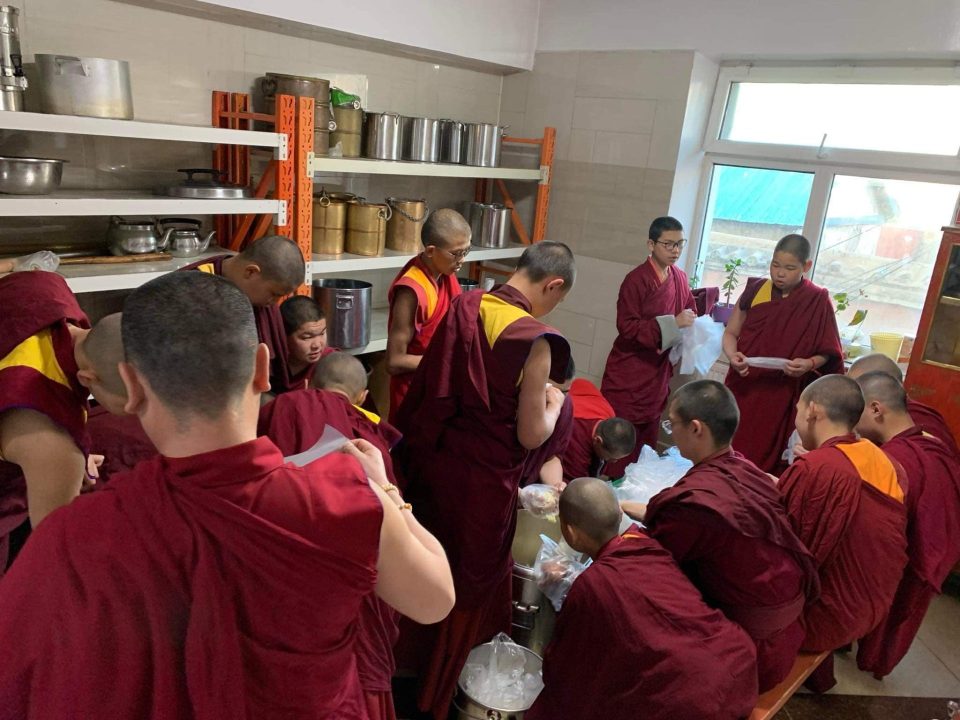
Idgaa monks are supporting the food preparation.
In 2025, US$10,800 was allocated to feed 32 Mongolian monks throughout the year. The funding has been used to:
- Provide daily lunch and dinner for monks during the winter months.
- Cover travel food expenses for young monks practicing in the countryside.
- Maintain a full-time cook, who ensures healthy meals are prepared.
- Purchase cleaning supplies to maintain hygiene and promote well-being.
The monastery also hosts FPMT Mongolia’s annual Mani Retreat since 2013.
The Idgaa Choizinling Monastery has expressed deep gratitude for the continued support. This program not only nourishes the monks physically but also strengthens their ability to study, practice, and preserve the Dharma for future generations in Mongolia.
Other smaller grants were offered in 2025 such to assist an FPMT geshe who experienced a medical emergency while traveling. As well as offerings on behalf of the organization to the geshes who helped during the first Most Secret Hayagriva retreat that was held at Nalanda Monastery.
Thank you!
The grants offered in 2025 reflect the heart of FPMT’s mission: to preserve and spread the teachings of the Buddha by supporting those who dedicate their lives to the Dharma. From food and health care to education and infrastructure, the SOSF has helped sustain Sangha communities in Nepal, India, Mongolia, France, the UK, and beyond.
We extend our deepest gratitude to all donors and supporters who make this work possible. Your generosity ensures that ordained Sangha, who are the living transmission of the Buddhadharma, continue to thrive for generations to come!
All are welcome to contribute to the Supporting Ordained Sangha Fund, to help ensure grants like these continue for the benefit of monks and nuns around the world.
- Tagged: Gyudmed Monastery, idgaa choizinling monastery, international mahayana institute, jamyang buddhist centre, nalanda monastery, osel labrang, ribur rinpoche, shalu monastery, tashi chime gatsal nunnery, thame, zigar thupten shedrupling institute
12
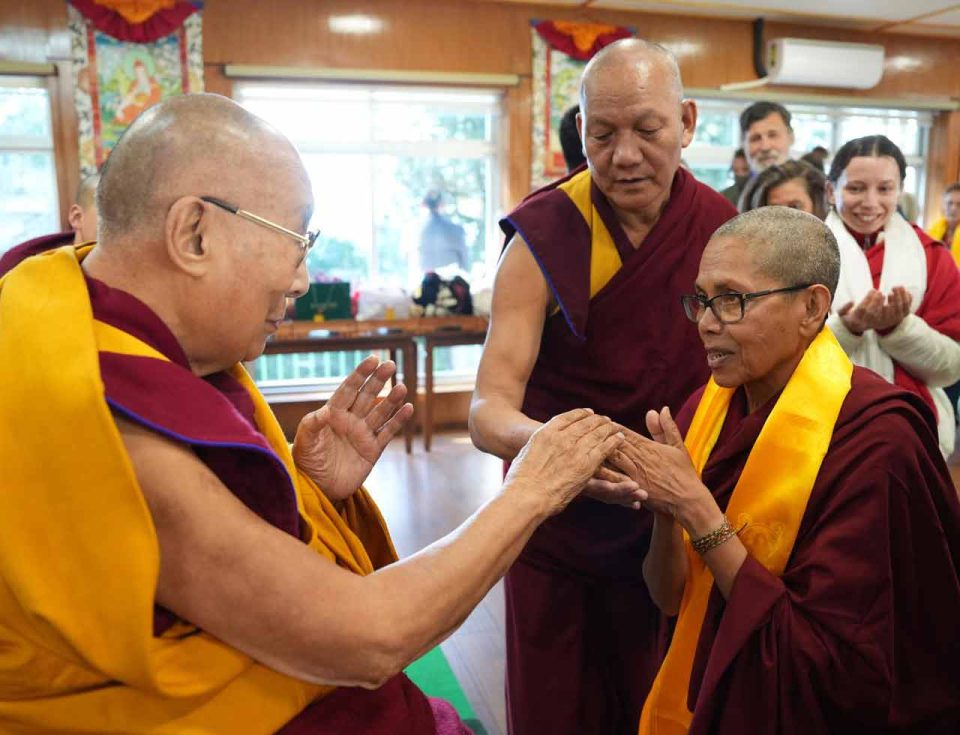
Ven. Lekdron with His Holiness the Dalai Lama, who granted His blessings for the documentary film project, Five Prominent Historical Mahayana Buddhist Sites in Sri Lanka, Dharamsala, December 2024.
In 2025, the FPMT Education and Preservation Fund continued its mission to safeguard and share the profound teachings of the Mahayana tradition by awarding a total of US$13,300 in grants. These contributions supported a diverse range of projects – from translation and publication efforts to teacher development and multimedia initiatives – each aligned with Lama Zopa Rinpoche’s vision of making the Dharma accessible, inclusive, and transformative across cultures and generations.
Documentary in Sri Lanka | The Six Perfections in Italy | Dharma Teachers | Revival in Bengal | Thank you
Preserving Mahayana Buddhist Heritage in Sri Lanka
In 2025, the FPMT Education and Preservation Fund contributed US$7,000 to support a landmark initiative led by Ven. Tenzin Lekdron and the Tara Lanka FPMT Study Group, dedicated to preserving and illuminating Sri Lanka’s rich Mahayana Buddhist heritage through the production of a documentary film. This grant funded the pre-production phase of “Five Prominent Historical Mahayana Buddhist Sites in Sri Lanka,” laying the groundwork for a full-scale exploration of Mahayana Buddhism’s presence and influence on the island.
Although widely recognized as a Theravada country, Sri Lanka also nurtured vibrant Mahayana traditions, particularly during the Anuradhapura period (377 BCE to 1017 CE). The documentary seeks to uncover this underappreciated history, bringing together archaeological evidence, and cultural research. Through interviews with scholars, historians, and practitioners, the film will highlight the depth and diversity of Sri Lanka’s Buddhist heritage, offering a broader and more unified view of Buddhist traditions.
The project’s early milestones have already demonstrated its significance. In October 2024, a Medicine Buddha Puja at Mahiyangana Temple drew over 2,000 participants, followed in December by His Holiness the Dalai Lama blessing the Medicine Buddha statue and the project itself.

Buddhas on Rocks, one of the sites featured in the documentary.
Pre-production activities have focused on extensive research, site access permissions, and collaboration with Sri Lankan ministries and cultural institutions, along with engagement of local AV teams and international documentary producers. These efforts ensure that the forthcoming film will be both historically rigorous and culturally sensitive. Featured sites include Rajagala Stupa in Ampara, where unaltered stupas reveal Mahayana architectural principles from the Manjusri Bhasita Vastuvidya Sastra (ancient Buddhist architectural manual); Buduruwagala, home to extraordinary rock carvings of Mahayana deities such as Vajrapani and Manjushri; and Mahiyangana Temple, a site visited by the Buddha and now witnessing a revival of Mahayana practice.
The project has received strong endorsements, including from Senior Venerable Phuoc Tan Thich, Abbot of Quang Minh Temple in Vietnam, who praised its potential to foster healing and unity across traditions while recognizing Ven. Lekdron’s leadership and vision.
Looking ahead, the completed documentary will be screened globally at FPMT centers and broadcast on public television in Sri Lanka and Australia. It is expected to encourage pilgrimages and retreats to the featured sites, support scholarly symposiums between Mahayana and Theravada communities, and contribute to the publication of previously overlooked Mahayana texts.
Bringing the Six Perfections to Italy

The Six Perfections cover.
In 2025, the FPMT Education and Preservation Fund proudly supported a meaningful initiative in Europe: the Italian translation of Lama Zopa Rinpoche’s profound work, The Six Perfections, with a grant of US$1,500. This project, led by Nalanda Edizioni, is more than a publishing effort – it’s a cultural bridge, a spiritual offering, and a legacy in motion.
Tibetan Buddhism, while growing in popularity, remains underrepresented in Italy. Nalanda Edizioni has long served as a vital conduit for making authentic Dharma teachings accessible to Italian-speaking practitioners – both those affiliated with FPMT centers and independent students seeking spiritual depth.
This year’s focus on The Six Perfections is especially timely. As Ven. Sangye Khadro beautifully put it, the book is: “a jewel… full of practical advice on how we can start working on these six precious practices, even if we are not yet bodhisattvas.” The translation will offer Italian readers a clear, compassionate guide to cultivating generosity, ethics, patience, joyous effort, concentration, and wisdom – core pillars of the Mahayana path.
The grant from FPMT covers the translation phase, ensuring the text’s spiritual and linguistic integrity. All other phases – editing, typesetting, printing, and distribution – are being self-funded by Nalanda Edizioni or supported through a crowdfunding campaign, a model that has proven successful in their past projects.
With many Italian FPMT centers and growing interest from other Buddhist institutions, Nalanda Edizioni is well-positioned to distribute the translated text widely. Their e-commerce platform and active digital presence (including newsletters and social media) ensure that even those in remote areas can access these teachings.
The project also strengthens the broader mission of FPMT: to preserve and spread the Mahayana tradition. By making Lama Zopa Rinpoche’s teachings available in Italian, this initiative nurtures a new generation of practitioners and honors the enduring legacy of our beloved teacher.
Empowering Dharma Teachers
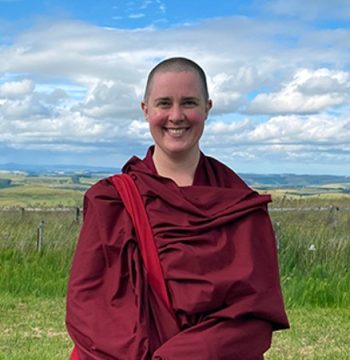
Ven. Lozang Yönten from Maitripa College.
In July 2025, Maitripa College has hosted the Teacher Development and Support Seminar (TDSS), a transformative gathering for Dharma educators made possible by a US$3,000 grant from the FPMT Education and Preservation Fund. Designed to uplift the next generation of Buddhist teachers, the seminar will combine traditional Dharma transmission with modern pedagogical tools, digital literacy, and cultural sensitivity, ensuring that teachers are equipped to meet the needs of today’s diverse and global community.
Led by Ven. Lozang Yönten and Namdrol Adams, Ed.D., and shaped through consultation with experienced educators such as Don Handrick, Ven. Connie Miller, and Andy Wistreich, the seminar will address the challenges Dharma teachers face in balancing tradition with innovation.
The FPMT grant helped to remove financial barriers for participants, making it possible for dedicated Sangha and lay teachers ( many of whom serve as volunteers) to attend.
Reviving Mahayana Wisdom in Bengal
In 2024, the FPMT Education and Preservation Fund supported the Department of Indo-Tibetan Studies at Visva-Bharati University in their mission to revive Mahayana Buddhism in Bengal. Led by the late Professor Sanjib Kumar Das, the team translated foundational Mahayana texts into Bengali, including the Prajñādaṇḍa, Jñānasārasamuccaya, and Dharmadharmatāvibhaṅga, as well as Ārya-prajñāpāramitā-vajrapāṇi-mahāyāna-sūtra, Ārya-prajñāpāramitā-vajraketu-mahāyāna-sūtra, and Nagarjuna’s Yuktiṣaṣṭikākārikā. These efforts helped reconnect Bengali-speaking practitioners with their rich Buddhist heritage and laid the groundwork for future scholarship.
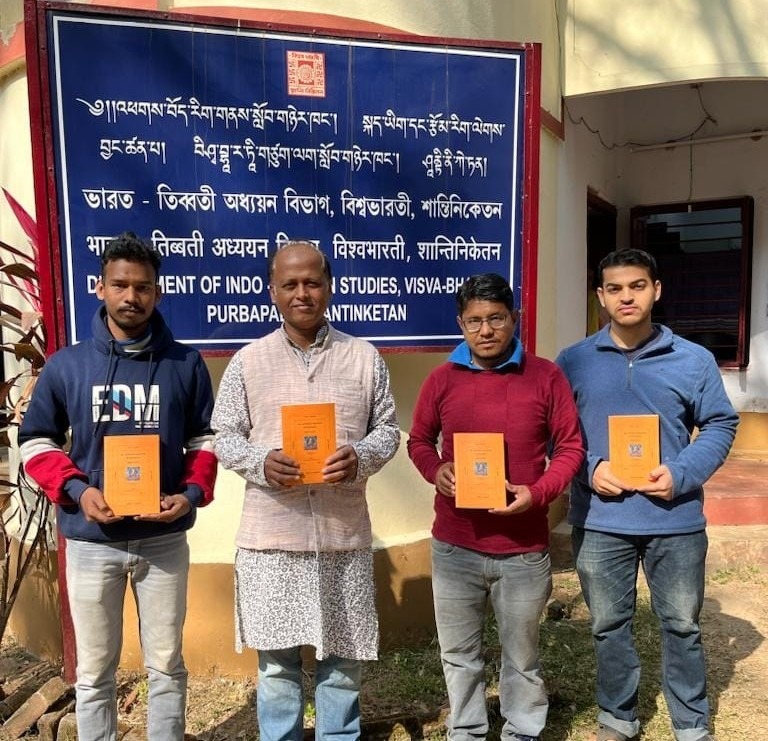
The team of Bengali translators at Visva-Bharati University. With the late Professor Sanjib Kumar Das (second from the left)
This year, the department continues its vital work with a new translation project: Ācārya Aśvaghoṣa’s Vajrasūcī, a powerful text that challenges caste-based hierarchies and affirms the universal potential for spiritual awakening. The project is led by Dr. Debajit Chatterjee and Dr. Norbu Gyaltsen Negi, who aim to translate the Tibetan version of the Vajrasūcī into Bengali for the first time.
The Vajrasūcī, a blend of poetry and prose, contains 53 verses and commentary that refute the concept of Brāhmaṇa as a birth-based spiritual elite. Its message is especially relevant in today’s context, offering a timeless reminder of the Buddha’s radical inclusivity and compassion. Despite its significance, the Vajrasūcī has never been translated into Bengali.
The project has received US$1,800 from the FPMT Education and Preservation Fund to support the translation and publication process.
Thank you!
These projects supported in 2025 reflect FPMT’s commitment to preserving the Mahayana tradition and expanding its reach in meaningful ways. From reviving ancient texts in Bengali and Italian, to empowering Dharma teachers, each initiative contributes to a vibrant and compassionate future for Buddhist learning and practice.
We extend our deepest gratitude to all scholars, educators, translators, and practitioners whose dedication continues to bring the Dharma to life for communities around the world!
To support or learn more about the Education and Preservation Fund, and all of our FPMT Charitable Projects that are working to build a more compassionate world.
7
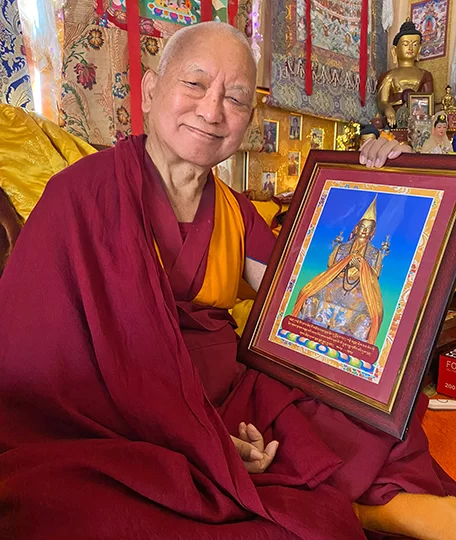
Lama Zopa Rinpoche with a picture of Lama
Tsongkhapa that Rinpoche liked very much,
Kopan Monastery, Nepal, February 2022.
Photo by Ven. Roger Kunsang.
The Lama Tsongkhapa Teachers Fund (LTKTF) continues to be a cornerstone in preserving the Geluk lineage of Tibetan Mahayana Buddhism. Named after the 14th-century master Lama Tsongkhapa (1357–1419), the Fund embodies His vision of integrating deep scholarship, ethical discipline, and meditative insight. In 2025, the Fund has already disbursed US$174,568, reinforcing its commitment to sustaining the living transmission of Dharma teachings.
Lineage Teachers | Annual Geluk Exam | Annual Winter Debate | Scholastic Achievement | Geluk Lineage | Medical Research | Thank you!
Supporting Our Lineage Teachers
Since its inception in 1997, the Fund has provided monthly stipends to 141 senior Geluk teachers, including past and present abbots of the main geluk monasteries, umzes, and teachers from major monasteries such as Sera Je, Sera Mey, Gaden Jangtse, Gaden Shartse, Drepung Loseling, Drepung Gomang, Gyudmed, Gyuto, Rato, and Tashi Lhunpo. These stipends – totaling around US$14,080 annually – ensure that these scholars can focus fully on their spiritual and academic pursuits.
On August 31, 2025, the annual graduation ceremony of Great Examination of Gelugpa University was successfully completed with the graduation of second-year Lhopon, and a closing ceremony was held. During the ceremony, certificates and tokens of appreciation were also presented to the participants.
Supporting the Annual Geluk Exam
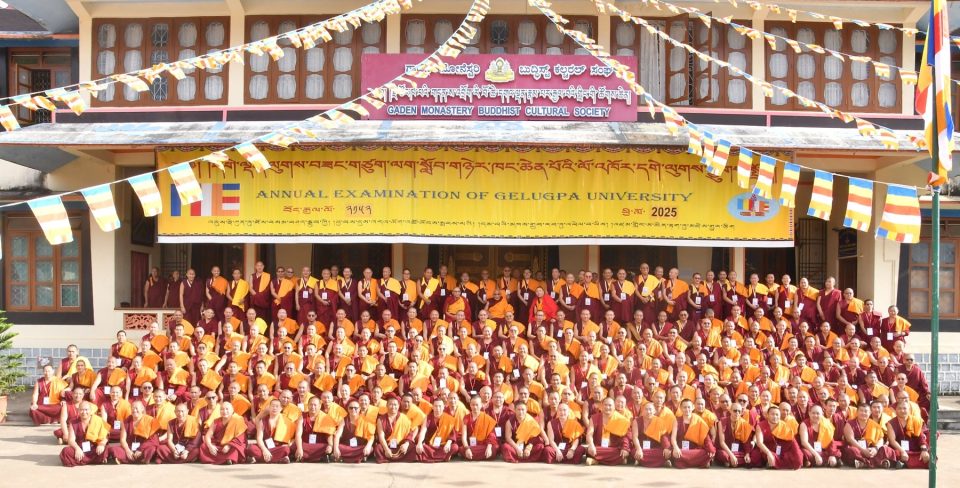
Supporting the Annual Geluk Exam.
During the event, Geshe Sonam Norbu, Director of the Gelugpa Cultural society, spoke about how the great patron of the teachings, the late Lama Zopa Rinpoche, who from 1997 until now, through the Lama Tsong Khapa Teachers Fund, has provided food, provisions, and travel expenses to retired abbots from the three great monastic seats, great teachers, and participants in the Gelug debate examinations. The director dedicated the merit of such extensive service to the teachings and expressed prayers and encouragement that Rinpoche’s unmistaken reincarnation would quickly arrive and be able to continue his predecessor’s legacy of spiritual accomplishments.
In 2025, US$10,841 was allocated to support the Geluk Exam, a rigorous test of philosophical understanding.
Supporting the Annual Winter Debate
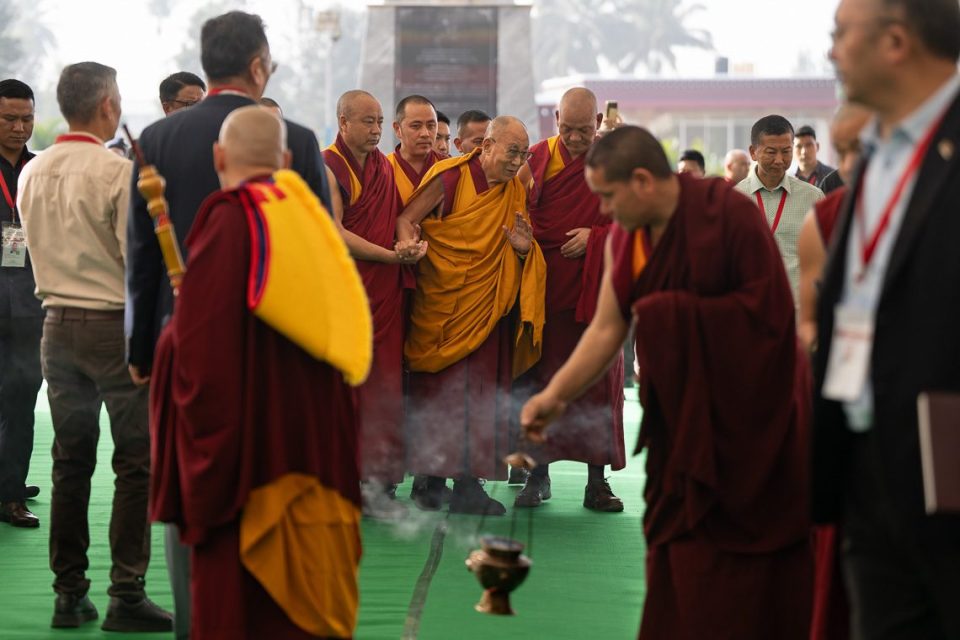
His Holiness the Dalai Lama arriving at debate ground of Tashi Lhunpo Monastery to attend the Winter Debating Session in Bylakuppe, Karnataka. Photo by Tenzin Choejor. January 2025
The Fund also sponsors the annual Winter Debate, which bring together hundreds of monks from the eight major Geluk monasteries.
The Winter Debate, hosted this year at Gaden Monastery, received US$16,609 in funding. This covered round-trip bus travel and offerings of milk and fruit, and organizational costs for nearly 500 monks.
Honoring Scholastic Achievement
Since 2000, a cherished tradition has been upheld through the offering of complete sets of robes to monks who successfully memorized the Migsel Loguk Chenpo text. For 25 years, this offering has honored their dedication and inspired continued excellence in Dharma study. In 2025, 119 students were recognized with robes and ceremonial scarves, representing a total offering of US$3,038.
Strengthening the Geluk Lineage
The LTKTF and its partner, the Geluk International Foundation (GIF), have made remarkable strides in 2024–2025 in preserving and advancing the Geluk tradition of Tibetan Buddhism. Through sponsorship and coordinated efforts, this initiative has empowered scholars, teachers, and monastic institutions across India to deepen their study and transmission of the Dharma.
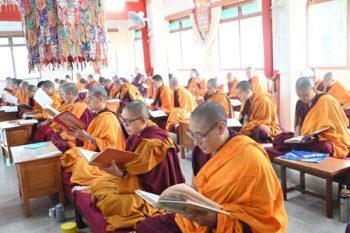
Jangchup Choeling Nunnery nuns are celebrating Lama Tsongkhapa’s Day on December 25th, 2024.
Source: Jangchup Choeling Nunnery’s website.
The Research and Training of Specialist Geshes and Geshemas project, initiated in 2020 under the guidance of His Holiness the Dalai Lama, has grown to include dozens of scholars from over 10 major monasteries, including: Sera Jey & Sera Mey, Gaden Jangtse & Gaden Shartse, Drepung Gomang & Drepung Loseling, Gyuto & Gyumed Tantric Monasteries, Tashi Lhunpo Monastery, Rato Monastery, and Jangchup Choeling Nunnery.
Each scholar is engaged in a three-year research program focused on one of the five major treatises of Buddhist philosophy: Pramana (Logic), Prajnaparamita (Perfection of Wisdom), Madhyamaka (Middle Way), Abhidharma (Phenomenology), and Vinaya (Monastic Discipline). Their work includes quarterly submissions of research papers, guided by appointed instructors and supervisors, and culminates in a thesis reviewed by an expert committee.
The Geluk International Foundation has implemented a robust monitoring system, including:
- Regular workshops on research methodology
- Quarterly progress tracking and feedback
- Personalized mentorship for each scholar
- Coordination with abbots and monastic leaders to ensure timely submissions and project alignment
This year, the annual grant for the Research and Training Project for Specialist Geshes and Geshemas reached US$77,500, while the Third Research and Training Project received US$37,500.
These funds, were used to provide stipends to scholars, instructors, and supervisors across all participating monasteries. Together, these initiatives cultivate the next generation of Buddhist scholars, ensuring the Geluk tradition remains intellectually robust and accessible to future generations.
Funding Tibetan Medical Research
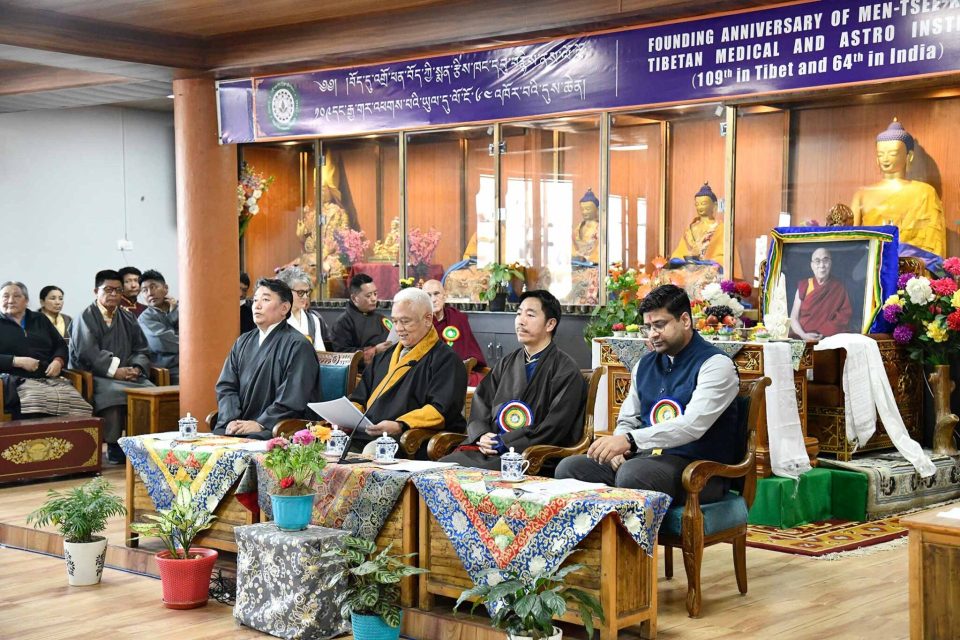
On March 25, 2025, Men-Tsee-Khang celebrated its 109th founding anniversary since its establishment in Lhasa, Tibet, in 1916 by His Holiness the 13th Dalai Lama, and its 64th year since its re-establishment in Dharamsala, India, in 1961 by His Holiness the 14th Dalai Lama. Source: Men-Tsee-Khang’s official website.
In 2025, a grant of US$15,000 was offered to Men-Tsee-Khang. Men-Tsee-Khang’s Clinical Research Department has launched a retrospective observational study to evaluate the role of Traditional Tibetan Medicine (TTM) in cancer care. Led by Dr. Dorjee Rabten Neshar and a team of Tibetan medical researchers, the study explores how ancient Sowa Rigpa principles can complement modern oncology.
TTM views cancer as an imbalance among the body’s three energies: rlung (wind), mkhris-pa (bile), and bad-kan (phlegm), and treats it holistically through herbal formulations, dietary changes, external therapies, and mental well-being practices.
The two-year study will analyze patient records from Men-Tsee-Khang clinics to assess survival rates, quality of life, symptom changes, and safety outcomes among cancer patients who received TTM for over three months. Results will be compared to existing cancer survival data to evaluate TTM’s potential as a complementary, safe, and affordable treatment option.
This initiative marks a significant step toward integrating Tibetan healing wisdom with global cancer research—bridging tradition and modern science for compassionate, holistic care and this research continues to advance knowledge and share valuable findings at Tibetan medical conferences in Dharamsala.
Full funding for the Research and Training projects, as well as the Tibetan Medical Research, has already been received and is being administered by the Lama Tsongkhapa Teachers Fund.
Thank You!
Your continued support is not only sustaining the Geluk lineage but actively nurturing its future. With your help, these scholars are building bridges between tradition and contemporary understanding, ensuring that Lama Tsongkhapa’s legacy continues to illuminate minds across generations!
The Lama Tsongkhapa Teachers Fund preserves the unbroken Tsongkhapa lineage, and cultivates the foremost scholars of tomorrow. The fund provides support to the abbots and senior teachers of the Lama Tsongkhapa tradition, supports the annual Gelugpa exam and monks and nuns to attend the annual winter debate among many other activities.
- Tagged: lama tsongkhapa teachers fund, supporting ordained sangha, supporting ordained sangha fund, winter debate
4

The beautiful decorations adoring the Stupa of Complete Victory. Photo by Ven. Tenzin Tsultrim.
As we have previously reported, a Stupa of Complete Victory is being built at Kopan Monastery, Nepal, for the swift return of Kyabje Lama Zopa Rinpoche and actualization of all his wishes. Venerable Tenzin Tsultrim was recently at Kopan Monastery and provided some beautiful photos showing the progress.
Over the monsoon extensive work by some of the best artists has been undertaken on the incredible decorations that grace every level of the stupa. The 32 smaller stupas that will surround the main stupa are currently being carved in sandstone in India and will later be brought to Kopan Monastery.

Some of the best artists are working on the stupa’s decorations. Photo by Ven. Tenzin Tsultrim.
Kyabje Lama Zopa Rinpoche has explained:

One of the 32 smaller stupas that will surround the main stupa.
In the Guhyasamaja text (one of the higher tantras) it says: A stupa is a palace where all the buddhas are abiding. Those beings who don’t have the karma actually to see buddha need the holy objects of body, speech and mind – statues, scriptures, stupas – as a field for accumulating merit.
The benefits you receive from building a stupa equal the number of atoms of the stupa and these benefits exist as long as the stupa exists. Sentient beings accumulate extensive merit by making offerings to holy objects, and from this merit happiness comes…
… The purpose of making holy objects is not only so that the person who makes them can complete their collection of merit; it also gives many other sentient beings, who do not have the karma actually to meet Buddha and make offerings to him, the opportunity to make offerings to the holy body, holy speech, holy mind.
In this way sentient beings make connection with Buddha and accumulate the merit of having actually made offerings to Buddha. This connection with Buddha is very important.

Stupa garden at Kopan Monastery. Photo by Ven. Tenzin Tsultrim.
Above you can see the placement of the stupa in the magnificent stupa garden at Kopan Monastery, with Geshe Lama Konchog’s stupa in the middle, Khensur Lama Lhundrup’s stupa (not pictured) is to the left and Kyabje Lama Zopa Rinpoche’s stupa is arising on the right.
“The most important benefit is that these holy objects help to purify the mind and collect extensive merit so that it is possible for people to have realizations of the path easily. That is the main function of these holy objects— to help us sentient beings have quick realizations of the path to enlightenment, by the power of the holy object.” — Lama Zopa Rinpoche

This photo shows the gompa that will be below the actual stupa. Below that will be retreat rooms. Photo by Ven. Tenzin Tsultrim.
Please enjoy this short video showing all the progress on the stupa and giving you an opportunity to virtually circumambulate and rejoice:
Kyabje Lama Zopa Rinpoche mentioned: “Circumambulating stupas, statues of enlightened beings and scriptures, as well as doing prostration and making offering to all these things, naturally becomes virtue, becomes Dharma, the cause of happiness. This is due to the power of the holy object, the fully enlightened beings or statues, scriptures or stupas. The stupa which has arisen is the fully enlightened beings’ holy mind, the dharmakaya.”
Padmasambhava explaining the benefits of building stupas to King Trisong Detsen: “All those who rejoice in the stupa will generate every single quality of a buddha in their mental continuum.”
We still need funds to complete this beautiful stupa, please consider supporting in whatever way you can.
Please read more about the holy objects supported through the Holy Objects Fund.
- Tagged: holy objects fund, Lama Zopa Rinpoche Stupa of Complete Victory, stupa, stupa of complete victory
24
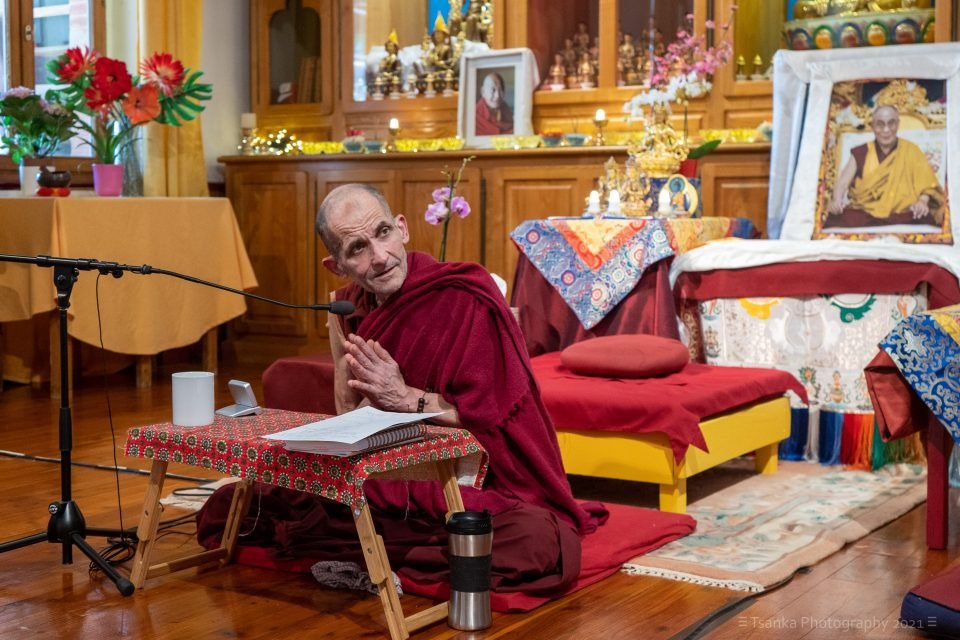
Since 2011, Ven. Charles has led 14 sets of Institut Vajra Yogini’s annual 108 Nyungne retreat. Next set of 108 Nyungne is set to start on November 11.
Institut Vajra Yogini (IVY) in France will soon start a new series of Nyung Na retreats (November 11, 2025 – June 15, 2026). It hosted its fourteenth series of 108 Nyung Na retreats from November 2024 to June 2025!
One of Lama Zopa Rinpoche’s Vast Visions for the FPMT organization was to sponsor people who make a serious commitment in this life to complete 1,000 Nyung Na retreats, and IVY kindly began to host the retreats every year to help fulfil this vision. For the last fourteen years, Lama Zopa Rinpoche has been sponsoring the food and accommodation for a number of people, who undertake the 108 Nyung Na retreats, and in 2025, US$16,347 was offered toward the retreat. In addition, IVY offered financial support to some of the part-time participants. The FPMT Practice and Retreat Fund and IVY are very happy to continue to offer support each year toward the retreats, in alignment with Rinpoche’s wishes and make retreats possible.
The Nyung Na retreat is a two-day intensive practice that includes taking the 24-hour Mahayana precepts every day, with the addition of complete fasting and silence every second day. There are three sessions of about three hours each day, including meditation, prostrations, and mantra recitation. It is a powerful, effective, experiential practice that can be done by anyone with respect and faith for the practice. Lama Zopa Rinpoche has highly praised Nyung Na retreat as a supreme method for transforming the mind.
Three people completed the full round of 108 retreats this year and a lot of other people joined to do one or a few two-day retreats or even do single sessions. Last year, Ven. Charles, the retreat leader, offered the morning sessions online every day, as well as one complete two-day retreat online once a month. In this way more students could participate from home. Please take a moment to rejoice!
The number of participants can vary from only six participants to sometimes twenty people joining the retreat. The long-term participants enjoy doing this practice in a bigger group as these retreats can be more powerful when more people participate. Retreat leader Ven. Charles, who has completed thousands of Nyung Nas, is very inspiring for beginners and advanced students as well. Additionally, resident teacher Geshe Loden is always willing to give advice, and the group benefits from the inspiration and advice from high realized lamas who visit the Institute.
To continue fulfilling Rinpoche’s Vast Visions, Institut Vajra Yogini has already begun planning for the fifteenth series of 108 Nyung Na retreats, which will start on November 11, 2025, and will finish June 15, 2026. The retreats are led most of the time in French and sometimes in English, but can be followed simultaneously in other languages. Ven. Charles will lead the Nyung Nas despite health issues, but a team of experienced practitioners will be assisting and leading sessions if Ven. Charles needs rest.
Please join us in rejoicing in fourteen consecutive years of Nyung Na retreats at Institut Vajra Yogini and feel very welcome to engage residentially or online in the upcoming retreat. You can also reach out to IVY directly for information on upcoming studies, retreats, and volunteer-study programs.
If you would like to support Lama Zopa Rinpoche’s wish to support these important retreats, you are welcome to offer any amount to the Practice and Retreats Fund
- Tagged: nyung na retreat, nyungne
20
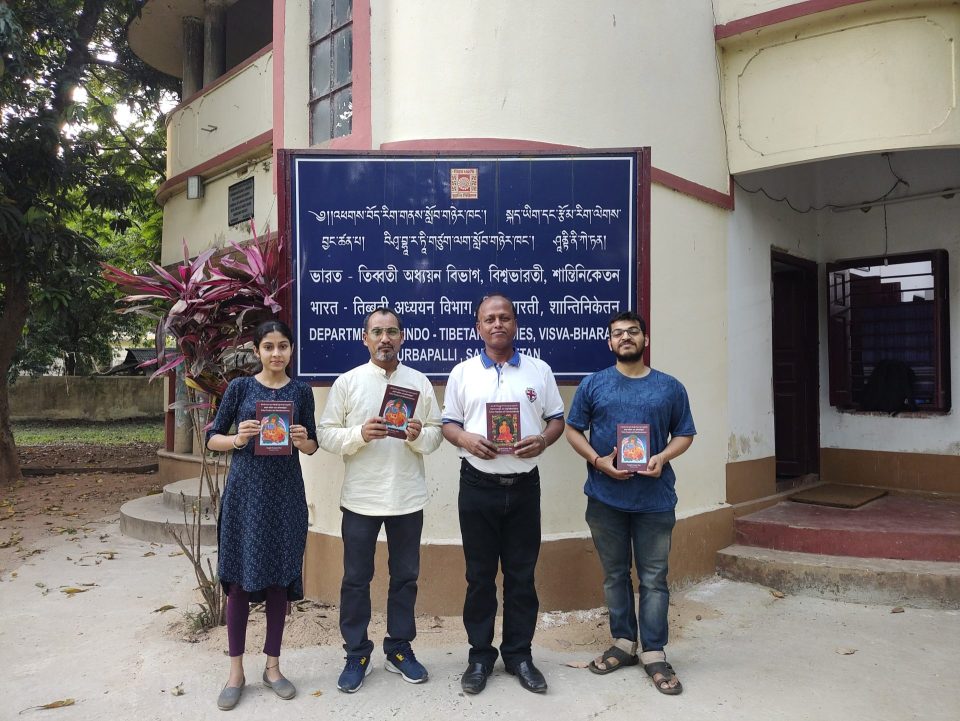
Professor Sanjib Kumar Das (third from the left) and his team in 2024.
The Education and Preservation Fund supports Dharma study and contributes to the development of Buddhist education programs and the preservation of the Dharma through the publication of Dharma practice materials and translations.
The fund also supports the publishing of the vast archive of Lama Zopa Rinpoche’s teachings and contributes to important initiatives that preserve the Dharma and the Mahayana tradition as identified by Lama Zopa Rinpoche.
In 2024, the Education and Preservation Fund supported three key translation projects aimed at making Buddhist teachings more accessible across linguistic and cultural boundaries.
Bengali and English Translations
Recipient: Indo-Tibetan Translation Group at Visva-Bharati University led by the late Prof. Sanjib Kumar Das
Visva-Bharati University – founded in 1921 by Nobel Laureate Rabindranath Tagore – is a central university and institution of national importance situated in Santiniketan, West Bengal. Conceived as a place where education, culture, and nature converge, it continues to embody Mr. Tagore’s vision of holistic human development.
At the heart of Visva-Bharati’s mission lies the preservation and translation of ancient texts – an endeavor essential for safeguarding the spiritual and philosophical heritage of India and the wider Buddhist world. Translation here is more than a linguistic pursuit: it is a bridge across generations, cultures, and communities. It ensures that timeless wisdom can speak anew to diverse audiences, keeping the profound teachings of the past both relevant and accessible.
Historically, Bengal was a vibrant center of Buddhist scholarship, home to renowned figures like Shantarakshita and Atisha, and closely linked to institutions like Nalanda. However, the destruction of Nalanda in the 12th century led to a sharp decline in Buddhist practice and literature in the region.
In 2024, with the support of the FPMT Education and Preservation Fund, three important texts were translated into Bengali and English:
- Prajñādaṇḍa (Eng. The Staff of Wisdom)
- Jñānasārasamuccaya (Eng. Aryadeva’s Compendium of the Essence of Wisdom)
- Dharmadharmatāvibhaṅga (Eng. Distinguishing Phenomena and Pure Being)
These texts offer deep insights into Buddhist ethics, wisdom, and the nature of reality, and are foundational to Mahayana philosophy.
With deep sadness, the Indo-Tibetan Translation Group at Visva-Bharati University announces the passing of Professor Sanjib Kumar Das on June 14, 2025, after a courageous six-month battle with pancreatic cancer. Professor Sanjib Kumar Das was the guiding spirit of the Revival of Mahayana Buddhism in Bengal project, supported by FPMT and Lama Zopa Rinpoche. Between 2021 and 2024, under his leadership, the group translated significant Tibetan Buddhist texts into Bengali and other Indian languages. Even in the midst of his illness, he continued working alongside his students on a final translation – an enduring testament to his dedication.
We extend our heartfelt condolences to his family and his team, who shared in his vision and tireless work.
Bengali Translation of Mahayana Sutras and Philosophical Treatise
Recipient: Bengali Department of Indo-Tibetan Studies at Visva-Bharati University led by Dr. Debajit Chatterjee and Dr. Norbu Gyaltsen Negi
The Bengali Department of Indo-Tibetan Studies at Visva-Bharati University, led by Dr. Norbu Gyaltsen Negi and Dr. Debajit Chatterjee, is undertaking a translation project focused on three key Madhyamaka Buddhist texts:
- Ārya-prajñāpāramitā-vajrapāṇi-mahāyāna-sūtra (Eng. The Noble Mahāyāna Sūtra of the Perfection of Wisdom with Vajrapāṇi)
- Ārya-prajñāpāramitā-vajraketu-mahāyāna-sūtra (Eng. The Noble Mahāyāna Sūtra of the Perfection of Wisdom with Vajraketu)
- Nagarjuna’s Yuktiṣaṣṭikākārikā (Eng. Sixty Verses on Reasoning)
Among the texts, two are Perfection of Wisdom sutras – emphasizing emptiness and wisdom through the Bodhisattvas Vajrapāṇi and Vajraketu – while the Yuktiṣaṣṭikā, a seminal work by Nāgārjuna, presents a systematic analysis of emptiness through reasoning at the heart of the Madhyamaka tradition.
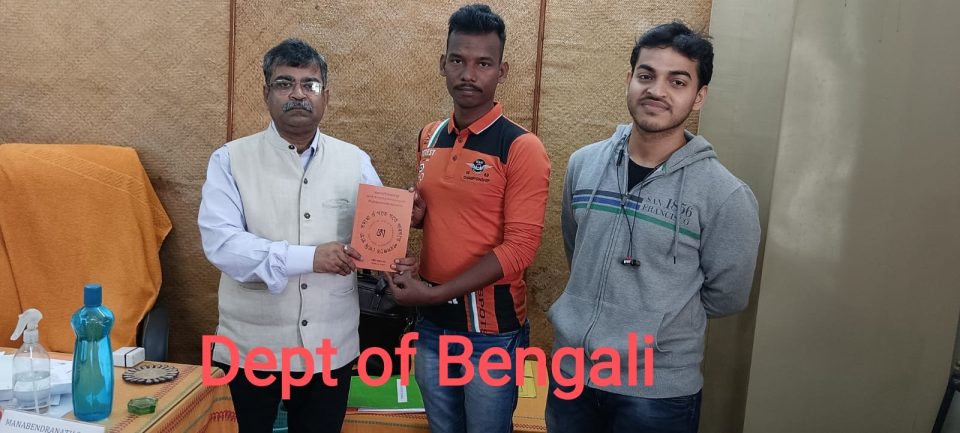
Bengali Department of Indo-Tibetan Studies at Visva-Bharati University.
These works are foundational to Mahayana thought and their translation into Bengali opens access to a broader audience of practitioners and scholars.
Sinhala Translation of “Liberation in the Palm of Your Hand” by Pabongka Rinpoche
Recipient: Tara Lanka FPMT Study Group led by Ven. Lekdron and Upul Bandara
In response to a request from Lama Zopa Rinpoche, the Tara Lanka FPMT Study Group in Sri Lanka has undertaken the translation of the core Lam Rim text, the Liberation in the Palm of Your Hand by Pabongka Rinpoche, into Sinhala language. This project began in June 2022 and is expected to be completed by mid-2025.
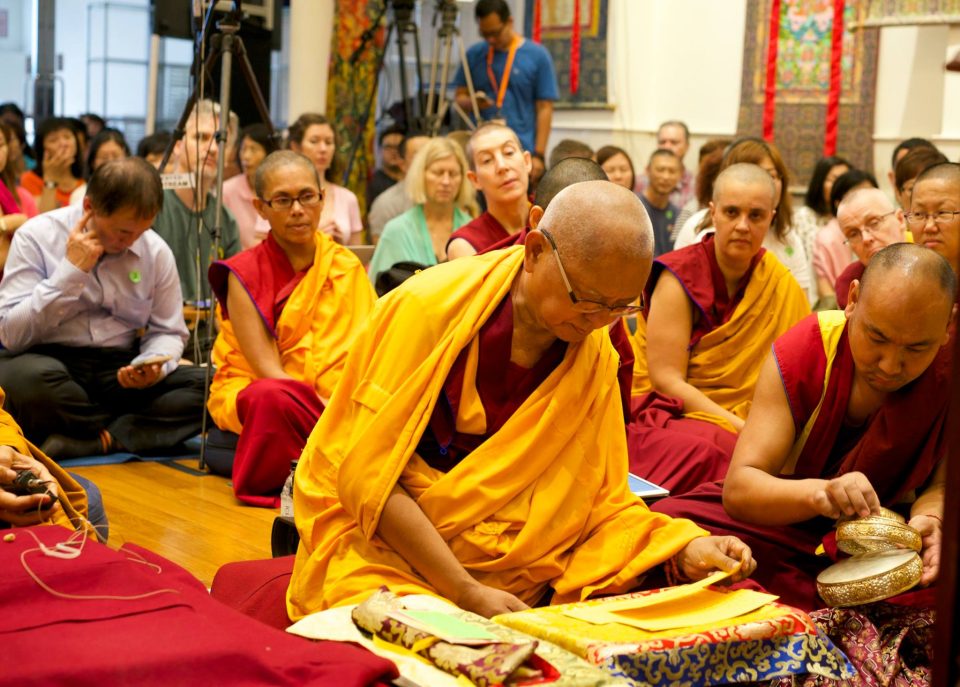
Ven. Lekdron (behind Rinpoche) with Lama Zopa Rinpoche. Photo courtesy of Ven. Lekdron.
The translation is led by Upul Bandara, a seasoned translator with over 20 years of experience, including work for the Sri Lankan Parliament and the studybuddhism.com platform. Editorial guidance is provided by Bertram Liyanage, a Dharmakirti expert and current PhD student at Temple University (Pennsylvania, United States).
This effort is deeply aligned with Rinpoche’s vision of making Mahayana teachings accessible to Sri Lankan practitioners. The project has progressed steadily despite limited resources, with initial funding personally covered by Ven. Tenzin Lekdron, a Sri Lankan nun and the project initiator.
The translation promises to significantly enhance understanding of Mahayana Buddhism in Sri Lanka, fulfilling Rinpoche’s aspiration to bring the Lam Rim teachings to a wider audience.
In 2024, the Education and Preservation Fund awarded a total of US$9,771 to support vital translation projects across South Asia. These efforts are crucial for preserving ancient knowledge systems, enabling comparative philosophical studies, fostering intercultural dialogue, and empowering regional communities through access to spiritual literature in their native languages. We extend our heartfelt thanks to the translators and scholars whose dedication continues to make the Dharma accessible to all. These projects reflect the core mission of the Fund: to preserve, translate, and share the teachings of the Buddha for the benefit of present and future generations. This work continued in 2025 with additional grants offered to support important preservation projects. We will share details of these 2025 grants in an upcoming report.
Learn more about the Education and Preservation Fund, and all of our FPMT Charitable Projects that are working to build a more compassionate world.
24
Grants Offered To Holy Object Creation in 2025
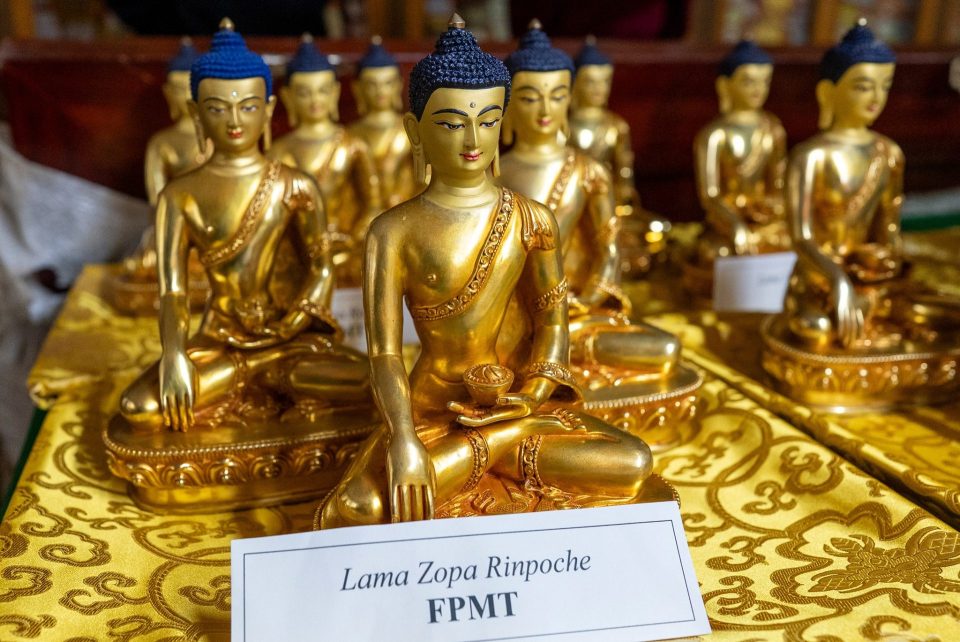
Shakyamuni Buddha statues offered to His Holiness the Dalai Lama on behalf of the entire FPMT family.
Kyabje Lama Zopa Rinpoche expressed in His Vast Visions the wish for the FPMT organization to build many holy objects everywhere, as many as possible. In this way, countless beings can easily purify their negative karma and create vast merit, bringing them closer to realizations on the path to liberation and enlightenment.
The Holy Objects Fund continues to fulfill Lama Zopa Rinpoche’s wish by supporting the creation of holy objects worldwide – for the success of the FPMT organization and for the benefit of all beings. In 2025, the Holy Objects Fund and other funds within FPMT that are dedicated to creating holy objects such as Stupa Fund, Prayer Wheel Fund and Offering Buddha Statues Fund, granted US$70,677 toward the creation and restoration of holy objects, helping bring Rinpoche’s compassionate vast vision to life across the globe. Please continue to read about some of these precious holy objects.
Ama Chhoyoling Monastery | Nagarjuna FPMT Centre | Nalanda Monastery | Tse Chen Ling | Karma Thegsum Tashi Gomang | Shakyamuni Buddha Statues | Naropa Center Tahiti | Stupa of Complete Victory |
Pokhara Guru Rinpoche Project | Mani Lhakhang | Thank you!
Amidst the peaceful hills of Khajilung, Sindhupalchok, Nepal, the Ama Chhoyoling Monastery (Gumba) has emerged as a symbol of devotion and community spirit. For many years, local villagers gathered for teachings and pujas in open fields and private homes. As the community’s spiritual aspirations grew, so too did the vision for a permanent home where the Dharma could flourish.
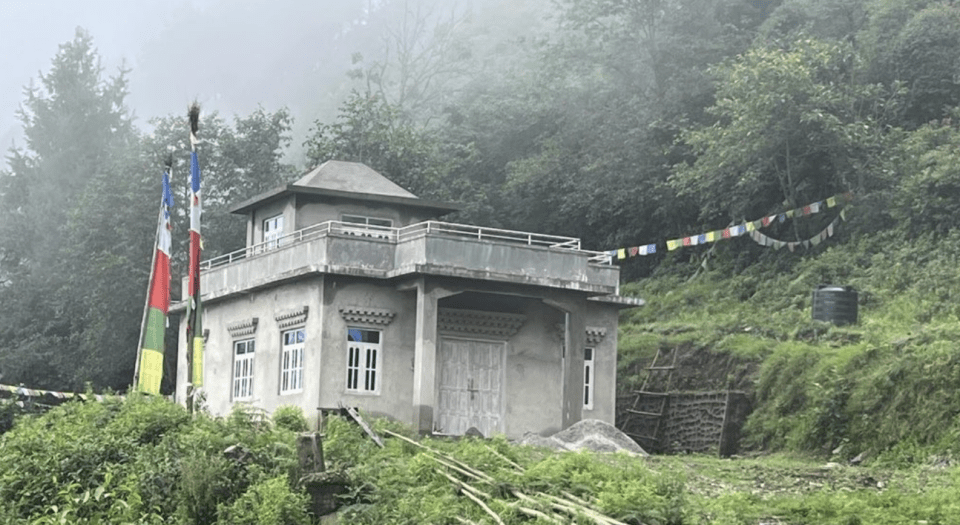
Ama Chhoyoling Gumba.
With generous support from the local community and the kind sponsorship of Mingyur Rinpoche, who offered holy statues, the monastery’s main structure was brought to life. Dharma teachings are already being shared within its walls, filling the space with practice and blessings, even as some important elements remain unfinished.
To complete the monastery’s spiritual and aesthetic vision, the community sought support for vital finishing touches such as painting the building and deity images on the entrance wall, creating victory banners for the four directions, installing the Eight Auspicious Symbols, designing a Dharmachakra with two deers, and building a cabinet for storing holy texts.
As a way to show support, Ama Chhoyoling Monastery has received a grant from the Holy Objects Fund to complete the Gumba. This contribution marks a major step forward in completing the monastery and enriching the spiritual lives of the local sangha.
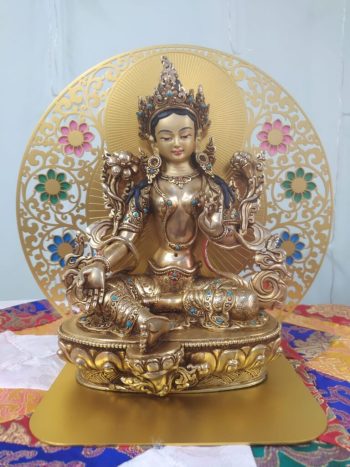
One of the Taras at Nagarjuna FPMT Centre Alicante.
In 2022, Nagarjuna FPMT Centre in Alicante, Spain, inaugurated its new premises, marking a significant milestone in its long-standing commitment to Dharma activities since 1996. Following this transition, the center also started spiritual advice given by Lama Zopa Rinpoche to ensure success and harmony at the new location. These efforts have included fire pujas, a Feng Shui study by Mr. Tan Hup Cheng with corresponding structural adjustments, extensive recitations, and ritual offerings.
Now, the center is focused on completing the final piece of Rinpoche’s advice: installing the Twenty-One Taras on the altar. The statues will be sourced from Nepal, filled and blessed there, and placed on a specially designed base to meet the high standards.
In 2025, the Holy Objects Fund has offered a grant toward the Twenty-One Taras project.
In a deeply moving continuation of Lama Zopa Rinpoche’s advice, the Sangha at Nalanda Monastery in France has taken on a profound daily practice: the creation of holy objects dedicated to those who have passed away and those facing illness or life obstacles. This tradition, once carried out by sangha at Rinpoche’s house in California, has now been lovingly passed to Nalanda, where it flourishes with renewed devotion.
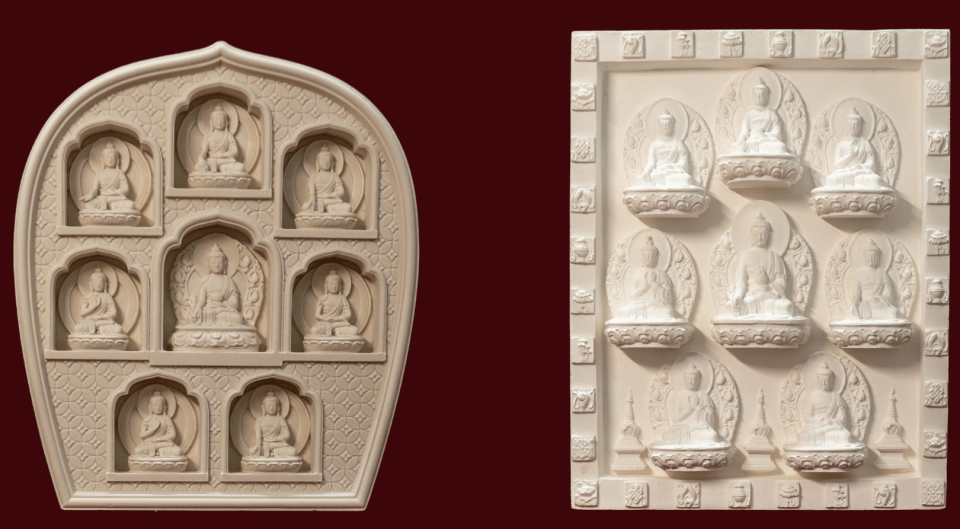
Eight Medicine Buddhas tsa-tsa mold at Nalanda Monastery.
Each day, the Sangha crafts three small stupas, each filled with a roll of the Four Dharmakaya Relic Mantras. As the mantras are placed inside, prayers are offered for individuals who have passed away, invoking blessings that they may never be born in the lower realms, be liberated from samsara, and swiftly attain enlightenment.
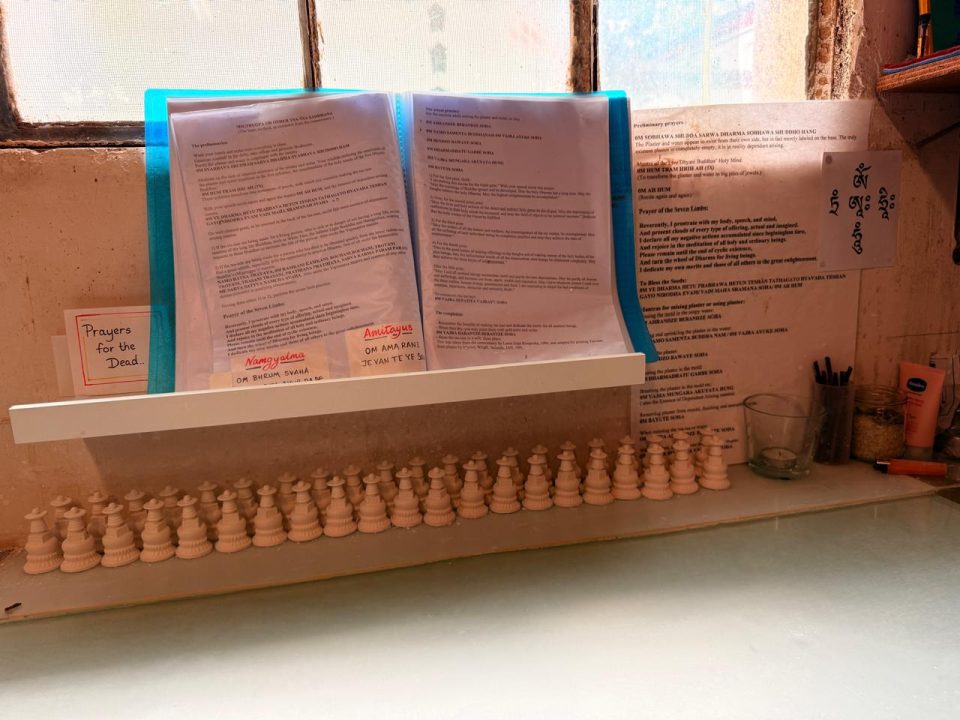
Stupas made at Nalanda Monastery.
In addition to the stupas, three long life tsa-tsas and thirteen Mitrugpa tsa-tsas are made daily, dedicated to those who are sick or facing life obstacles. These tsa-tsas are created with heartfelt prayers for immediate recovery, liberation, and enlightenment.
On special days of the Tibetan calendar, the practice expands: on the eighth day, three Eight Medicine Buddhas tsa-tsas are made, and on the thirtieth, a Padmasambhava tsa-tsa is created.
The Stupa Fund plays a vital role in sustaining this practice, covering the material expenses for the making of these tsa-tsas.
Tse Chen Ling Center, meaning “Land of Great Compassion” in Tibetan, is a vibrant urban Dharma center located in San Francisco. Named by His Holiness the Dalai Lama, the center has long served as a sanctuary for meditation, study, and spiritual practice. In 2025, the center embarked on a new auspicious project: the installation of a backyard stupa.
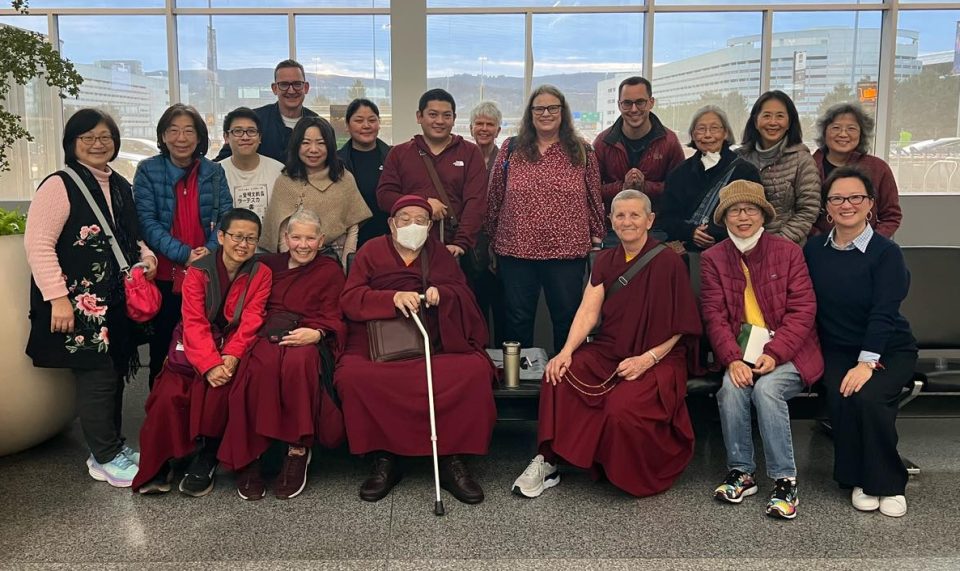
Tse Chen Ling Center members with Geshe Ngawang Dakpa.
This initiative was inspired by the advice of Kyabje Lama Zopa Rinpoche, who recommended the stupa for the center. The placement and size were further guided by Geshe Ngawang Dakpa, Tse Chen Ling’s resident teacher emeritus. The project involves constructing a concrete base for a one-meter tall stupa, creating a circumambulation path for students, and installing lighting – requiring electrical work due to the lack of outdoor power sources.
The stupa is being procured from Nepal through Kopan Monastery, ensuring its authenticity and spiritual integrity. The goal is to create a space where students and visitors can engage in merit-generating practices and deepen their connection to the Dharma.
To support this effort, the Stupa Fund contributed a grant toward the project.
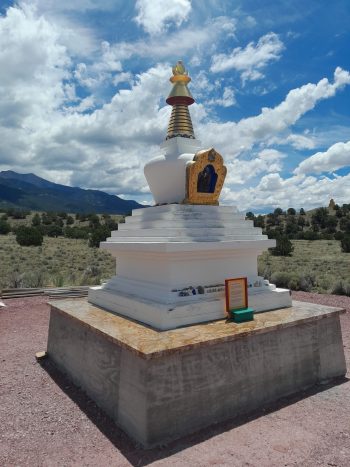
Relocated Padmasambhava Stupa
The Karma Thegsum Tashi Gomang is leading a restoration project for one of North America’s oldest stupas – the Padmasambhava Stupa, originally built in 1981 and recently relocated to a serene meadow in Crestone, Colorado. Surrounded by the Sangre de Cristo Mountains, the new site offers a tranquil setting for spiritual reflection and practice.
The stupa, which was inspired by His Holiness Dudjom Rinpoche and consecrated by Sogyal Rinpoche, had become crowded by nearby development. After years of consultation with senior lamas and Khenpos, the committee made the bold decision to move the 20,000 pound stupa to a more auspicious location. The relocation was completed in October 2024, and the focus has now shifted to restoring the stupa’s structure and surroundings.
Work commenced again in late spring beginning with the granite being placed as a capstone on the concrete base. The granite was procured and fabricated in Albuquerque, NM and transported to Crestone. Most recently, after some repair, the stupa received a new white stucco coat. The completion of this work magnifies its beauty and presence on the new site. It “stands out like a beacon” as one recent visitor stated.
The restoration includes re-stuccoing the stupa, repairing the concrete platform and korwa path, adding river rock and capstone to the foundation, and enhancing the site with landscaping, prayer flags, and offering racks.
In support of this endeavor, the Stupa Fund made a contribution, recognizing the project’s alignment with the FPMT mission and its potential to benefit countless beings.
On the auspicious occasion of His Holiness the Dalai Lama’s 90th birthday on July 6, 2025, the FPMT family came together to make a heartfelt offering on behalf of the entire organization. With deep devotion and prayers for His Holiness’s long life, one hundred Shakyamuni Buddha statues – carefully crafted in Nepal, gold-gilded, filled with mantras, consecrated at Gyudmed Tantric Monastery in Dharamsala, and painted with care – were offered to His Holiness. The creation and transport of these statues was made through the Offering Buddha Statues Fund for this purpose.
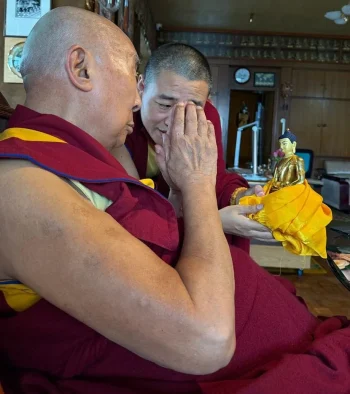
His Holiness the Dalai Lama receiving a Shakyamuni Buddha statue on behalf of the FPMT organization and praying for Lama Zopa Rinpoche’s incarnation.
Photo courtesy of the Office of His Holiness the Dalai Lama.
On July 5th, five representatives of FPMT – Ven. Roger Kunsang, Ven. Topgye, Ven. Elisabeth Drukier, Ven. Kunphen, and Frances Howland – had the great fortune to join the long life puja offered in Dharamsala by the Kashag of the Central Tibetan Administration. Within the puja procession, 13 of the statues were offered, including three that Ven. Roger was able to personally place in the hands of His Holiness. The remaining 87 statues were offered directly to His Holiness’s private office earlier that day.
These offerings, made on behalf of every FPMT center, project, service, student, volunteer, and benefactor, are an expression of gratitude and prayers for His Holiness’s continued guidance in this and all future lifetimes. With great rejoicing, we share that after the puja, we received precious photos of His Holiness receiving one of the statues, along with the message that His Holiness is making prayers for Lama Zopa Rinpoche’s incarnation.
May these offerings create the causes for His Holiness to live long, remain stable, and continue to benefit the world, and for the swift return of our precious guru, Kyabje Lama Zopa Rinpoche! Following on from Lama Zopa Rinpoche’s wishes we will continue to offer one hundred Buddha statues each year to His Holiness the Dalai Lama.
In a heartfelt initiative aligned with the mission of the FPMT, Naropa Center in Tahiti has been entrusted with a unique spiritual project: the construction of a prayer wheel over water in Tahiti. This vision was personally entrusted by Lama Zopa Rinpoche, recognizing the presence of numerous nagas in Tahiti and French Polynesia and the profound spiritual benefits such a holy object could offer.
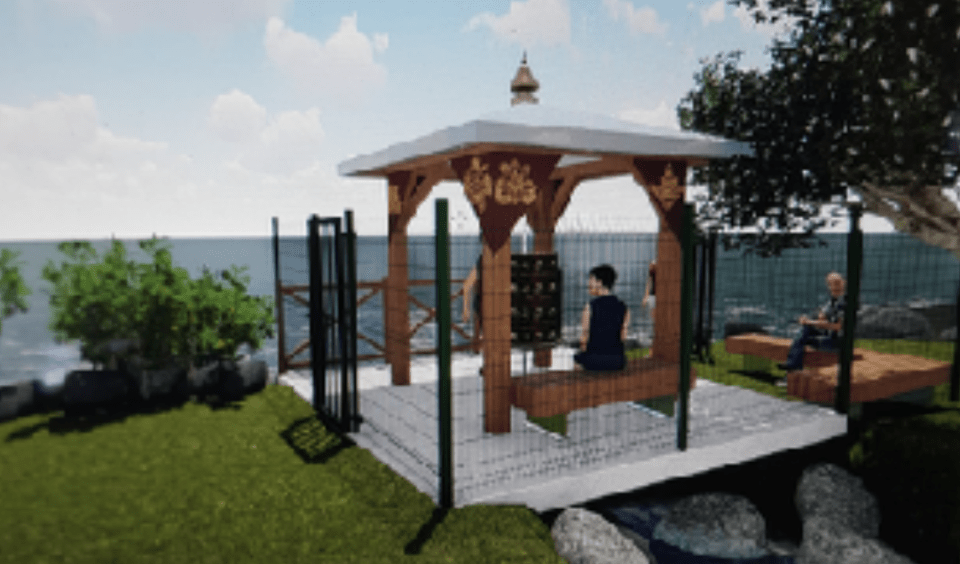
Rendering of the prayer wheel in Tahiti.
The prayer wheel, filled with millions of mantras, is designed to touch the water through its axis, radiating blessings across the Pacific Ocean and beyond. In 2025, the Prayer Wheel Fund offered a grant toward this initiative.
In October 2023, the FPMT announced the construction of the Stupa of Complete Victory, a 42-foot (12.8-meter) high monument dedicated to the swift return of Kyabje Lama Zopa Rinpoche. This stupa, advised by H.E. Zong Rinpoche, symbolizes the Buddha’s victory over the mara of death and is being built on the northeast side of the Stupa Garden at Kopan, facing midway between Swayambhunath and Boudhanath stupas.
The project includes a ground-level structure covering 180 square feet (16.7 square meter) and a semi-basement level of 715 square feet (66.4 square meter), which will house two retreat rooms. The design integrates a circumambulation path around the stupas of Lama Zopa Rinpoche, Geshe Lama Konchog, and Khensur Rinpoche Lama Lhundup, creating a holy space for purification and merit-making.
Extensive pujas were performed in October 2023 to bless the land and seek permission from local spirits. Excavation began in December, followed by the completion of the building up to the second story by May 2024. In October 2024, the stupa reached the precious vase section, and in November, nine large treasure vases filled with consecrated substances and texts were placed inside the throne. In February 2025, monks carefully wrapped and placed sacred texts and the life tree, inscribed with the Four Dharmakaya Relic Mantras, inside the stupa.
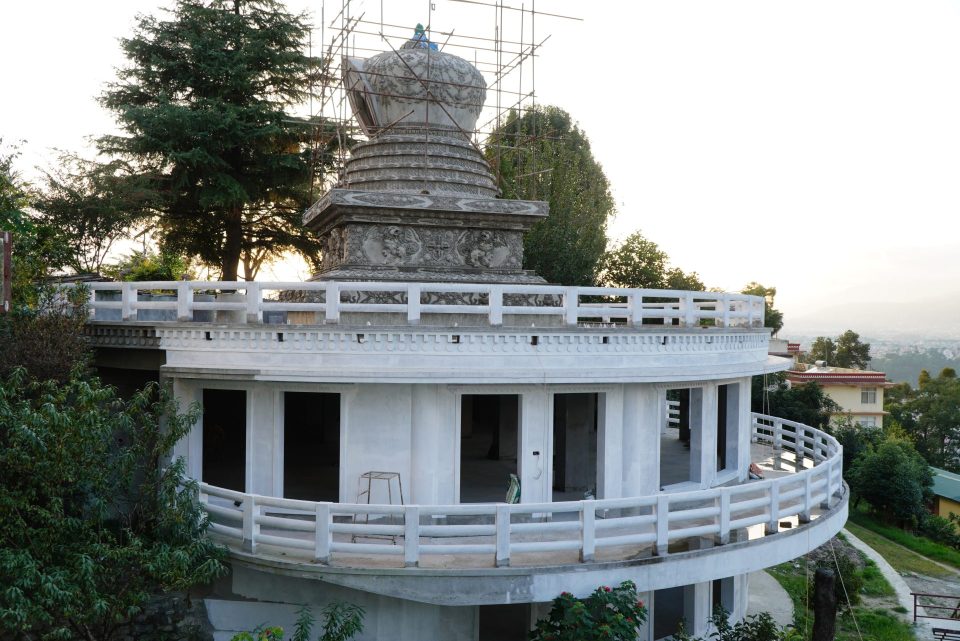
Stupa of Complete Victory at Kopan Monastery, September 2025. Photo by Tenzin Tsultrim.
The estimated cost for the entire project is US$935,890, covering the civil works, new gompa, retreat rooms stupa, landscaping, ornamentation, and the construction of 32 smaller stupas that will surround the main stupa.
As of now, the decorative work on the Stupa of Complete Victory is actively underway. Simultaneously, the process of building the 32 smaller stupas that will encircle the main stupa has begun. These stupas are being crafted in marble in India, and once completed, they will be installed around the central stupa, further enriching the holy environment and offering additional opportunities for circumambulation and merit-making.
The Padmasambhava Project for Peace, inspired by Lama Zopa Rinpoche, is dedicated to building large statues of Guru Rinpoche worldwide. To date, twenty-seven statues have been completed, each a symbol of hope, healing, and unity while also preserving traditional craftsmanship and supporting local communities.
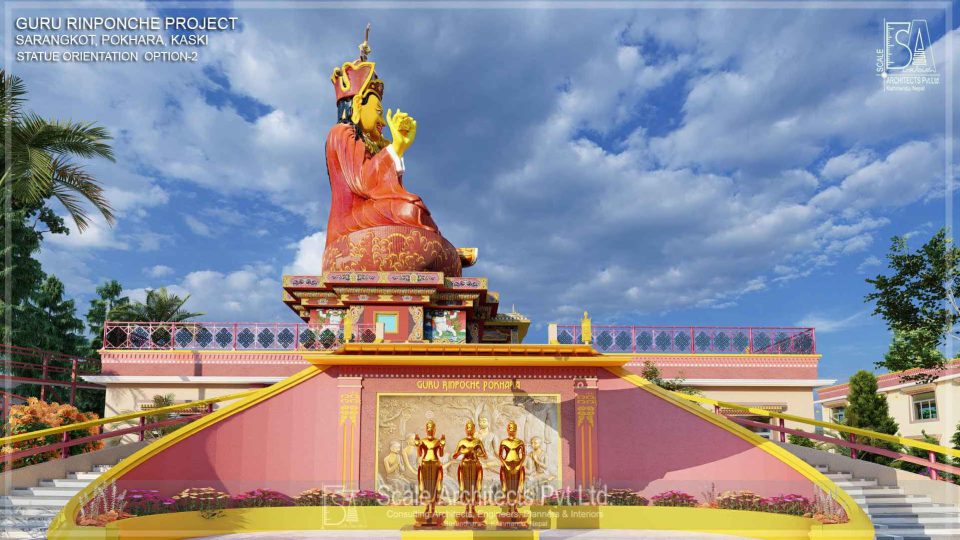
Pokhara Guru Rinpoche Project’s rendering.
In Nepal, the Pokhara Guru Rinpoche Project entered a new phase in 2025 with the construction of Block A, the first residential wing for retreatants, resident Sangha, and visiting practitioners. The site will eventually include a fifteen-meter statue of Guru Rinpoche, meditation and prayer halls, a mantra wall, and green spaces blending with the Annapurna landscape. Block A is expected to be completed by the end of 2028, marking a significant milestone in this meaningful project. Please do visit their website to keep updated on this amazing project and to support directly.
In October 2022, while on retreat at Gyudmed Monastery, Kyabje Lama Zopa Rinpoche was approached by residents of Village A in Hunsur with a humble request: to help them build a prayer wheel. A few days after this meeting, Rinpoche had an auspicious dream, which led him to envision a much larger and more meaningful structure than originally proposed.
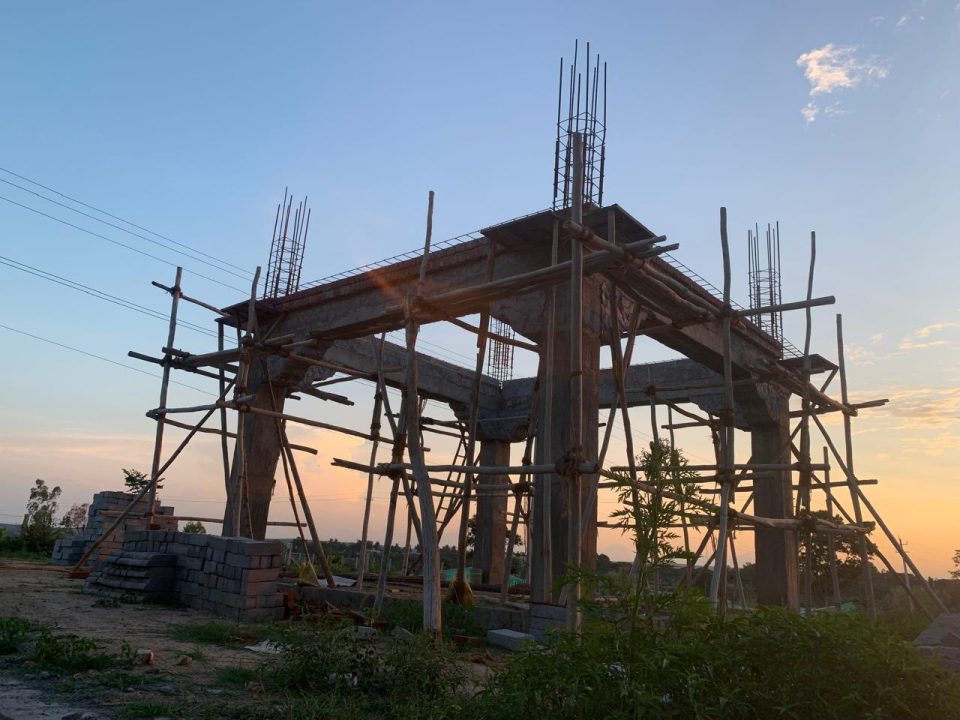
Construction of the Mani Lhakhang in Village A, Hunsur.
Based on this dream, Rinpoche expressed His wish to sponsor a significantly larger prayer wheel, giving it the name: “Wish Fulfilling Jewels Prayer Wheel Which Swiftly Liberate from Samsara and Achieve Enlightenment.” The new prayer wheel will contain over 30 billion mani mantras, making it a powerful source of purification and merit for all who engage with it.
This project is being sponsored by Lama Zopa Rinpoche Bodhichitta Fund. In 2023, the Fund granted US$64,127 toward the building of the new prayer wheel. Due to space limitations in the original location, the village community sought a new site. A local family offered a 50 ft x 50 ft (15,24m x 15,24m) plot from their agricultural land. Although the land was not zoned for construction, the community successfully obtained the necessary permits after a lengthy approval process. They have begun the construction and have invited Ven. Lhundup Tsondue, who has experience in similar projects, to assist. The community is also exploring other newly built prayer wheels in the region to gather ideas and ensure the new structure meets the highest standards. Despite delays, the spirit of the project remains strong. The village continues to pray for Rinpoche’s swift return and is committed to fulfilling His wishes with sincerity and devotion.
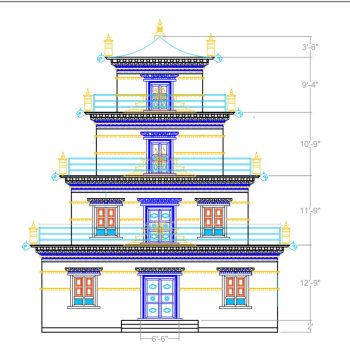
Rendering of the temple that will be built at Lawudo.
The Zangdog Palri Project at Lawudo, Nepal, remains a deeply inspiring and long-term vision initiated by Lama Zopa Rinpoche. This monumental undertaking aims to build a three-dimensional representation of Guru Rinpoche’s Pure Land, known as Zangdog Palri, or the Glorious Copper-Colored Mountain.
Following Rinpoche’s advice, the first step before building Zangdog Palri was the establishment of a 7-foot (2.1-meter) Kalachakra statue at Lawudo. This is essential for accumulating merit and removing obstacles for the project. The statue is currently in Lawudo Gompa, having been transported to Lawudo by helicopter.
A local consulting firm has prepared a comprehensive budget for the project, estimating the total cost for the whole Zangdog Palri temple – including civil works, cement, art, and thangka paintings – at approximately US$760,000.
In 2025 a lot of preparation work has been happening, such as moving of the prayer wheel that is beside the library at Lawudo to behind the Gompa, and building material is being collected and slowly brought up to Lawudo, which is huge task, as it all has to be carried up. This project remains close to the heart of many, especially Rinpoche’s sister, Anila Nawang Samten, who wants very much to fulfill all the wishes Rinpoche had for Lawudo. Please rejoice as the vision of creating Guru Rinpoche’s Pure Land in the Himalayas is alive and progressing, step by step.
Thank you!
This is truly something to rejoice in: every single day, new holy objects are created, prayers are offered, and merit is generated, keeping alive the legacy of Kyabje Lama Zopa Rinpoche! Through these projects, the FPMT community continues to fulfill Rinpoche’s wishes and offer immeasurable benefit to all sentient beings!
Thank you to all the donors who make it possible and please continue to support the creation of holy objects in anyway possible, whether it is at your local Dharma center or any of the funds at FPMT created for Holy Objects.
To help ensure our support to the creation of holy objects around the world, we invite you to offer a donation of any amount to the Holy Objects Fund.
- Tagged: 1000 buddha project, Ama Chhoyoling Monastery, guru rinpoche statue, holy objects, holy objects fund, lama zopa rinpoche bodhichitta fund, Nagarjuna FPMT Centre, nalanda monastery, naropa meditation center, stupa fund, stupa of complete victory, tse chen ling, zangdog palri
16
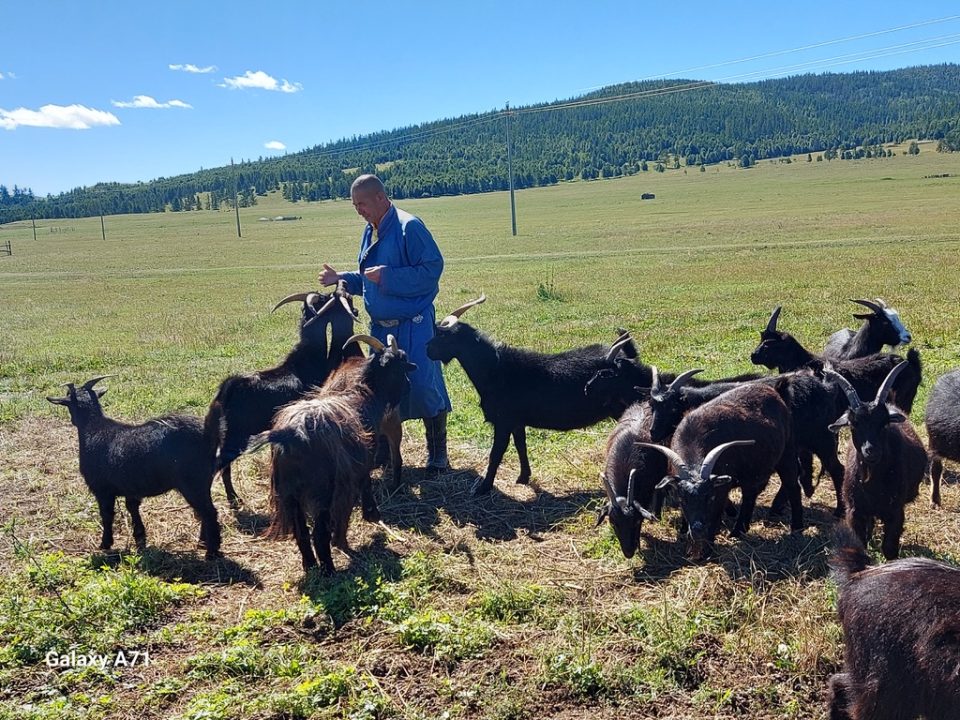
Herder Jigmed with liberated goats, Animal Liberation Project, FPMT Mongolia.
The Animal Liberation Fund continues to fulfill the holy wishes of Kyabje Lama Zopa Rinpoche by supporting the liberation and care of animals through extensive prayers, dedications, and compassionate action. These efforts benefit not only the animals but also those to whom the prayers are dedicated – including our sponsors, the sick, and those facing untimely death.
The fund enables weekly liberations and extensive dedications at Buddha Amitabha Pure Land in Washington State, USA. We are delighted to share that the Animal Liberation Fund provided US$13,139 in grants in 2025. Please read below to learn about the different grants offered and some of the ways that we are benefiting animals in the organization.
Animal Liberation Sanctuary in Nepal | Washington State, USA | FPMT Mongolia | Nalanda Monastery, France | Thank you!
Kopan Animal Liberation Sanctuary in Nepal
We were overjoyed to share the uplifting news that three young buffalo – Losang (Wise), Ngawang (Lord of Speech), and Jampal (Gentle Glory) were rescued from imminent slaughter in Kathmandu, in celebration of His Holiness the Dalai Lama’s ninetieth birthday and in sincere prayers for His enduring health and happiness.
These precious animals now enjoy a peaceful sanctuary near Kopan Monastery, where they are enfolded in daily care and kindness. Here, they rest in warm shelters, graze on nourishing food, and are gently soothed by the constant resonance of mantras and sutra recitations.
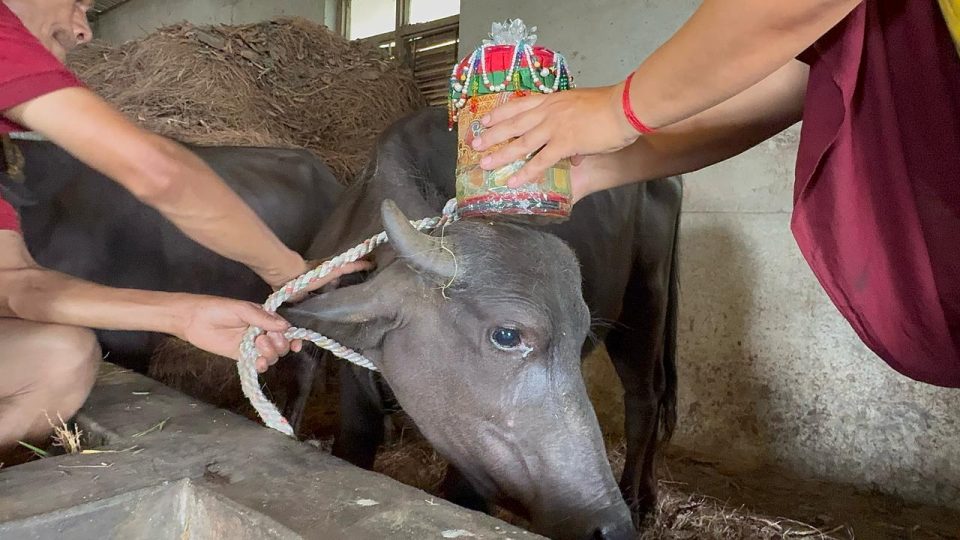
One of the buffaloes at the Kopan Animal Liberation Sanctuary receives a blessing of millions of different mantras placed on his head.
At the request of Ven. Roger Kunsang, H.E. Ling Rinpoche bestowed upon them the names Losang, Ngawang, and Jampal – each a reflection of the profound qualities we aspire to cultivate. His Holiness the Dalai Lama reminds us that universal responsibility extends beyond our own lives to embrace all sentient beings and the environment that sustains them. In honoring this responsibility, we nurture compassion for every creature.
The Animal Liberation Sanctuary currently houses: 61 goats, 5 cows, 1 buffalo (named Bodhichitta), several dogs, and 3 ducks. Bodhichitta was personally blessed by Lama Zopa Rinpoche in 2021. The animals receive food, shelter, and daily blessings, including mantra recitations, and circumambulation around stupas. They are blessed by microfilm mantras printed billions of times, as instructed by Lama Zopa Rinpoche, to create the causes for enlightenment
In 2025, the Animal Liberation Fund offered a granted in support of the sanctuary’s ongoing care.
We also have a large future grant prepared for the development of a new animal sanctuary, including infrastructure and construction of eight stupas.
Thanks to the perfect example and guidance of Lama Zopa Rinpoche, these three buffalos – and all the residents of the Animal Liberation Sanctuary – are now enveloped in love, safety, and spiritual care. Their liberation was made in the name of the entire FPMT family, a collective act of devotion and loving kindness.
Animal Liberation Practices in Washington State, USA
At Buddha Amitabha Pure Land in Washington State, USA, Sangha members continue to dedicate themselves to animal liberation practices with deep compassion and care. Over the past year alone, 33,780 animals – mostly crickets – were liberated, supported by the Animal Liberation Fund. With every animal liberation extensive prayers are made for those who have requested or who support the Fund.
Following the precious advice of Lama Zopa Rinpoche, the monks create as many opportunities as possible for animals to encounter the Dharma and accumulate merit. Ant nests in the area are offered charity in the form of tsampa, sugar, butter, and crushed mani pills, while lakes are blessed with mantras and recordings, and special fish food. Bird feeders are filled not only with seeds and water but also with blessings – sunflower seeds are consecrated with mantras, the water is infused with the mantras and crushed mani pills, and continuous Dharma audio plays in the background so that even the simple act of eating becomes an occasion for purification and awakening.
Venerables Tarchin and Tenzin, the monks in residence, recently shared inspiring glimpses of these activities. Videos show birds gathering under a Namgyalma mantra roof to eat blessed seeds and drink consecrated water, crickets being liberated during the summer months with microfilms of powerful mantras placed on top of their containers, and ants receiving blessed offerings. Each of these practices – whether blessing, feeding, or liberating – creates the conditions for animals to meet the path to enlightenment and to be freed from suffering.
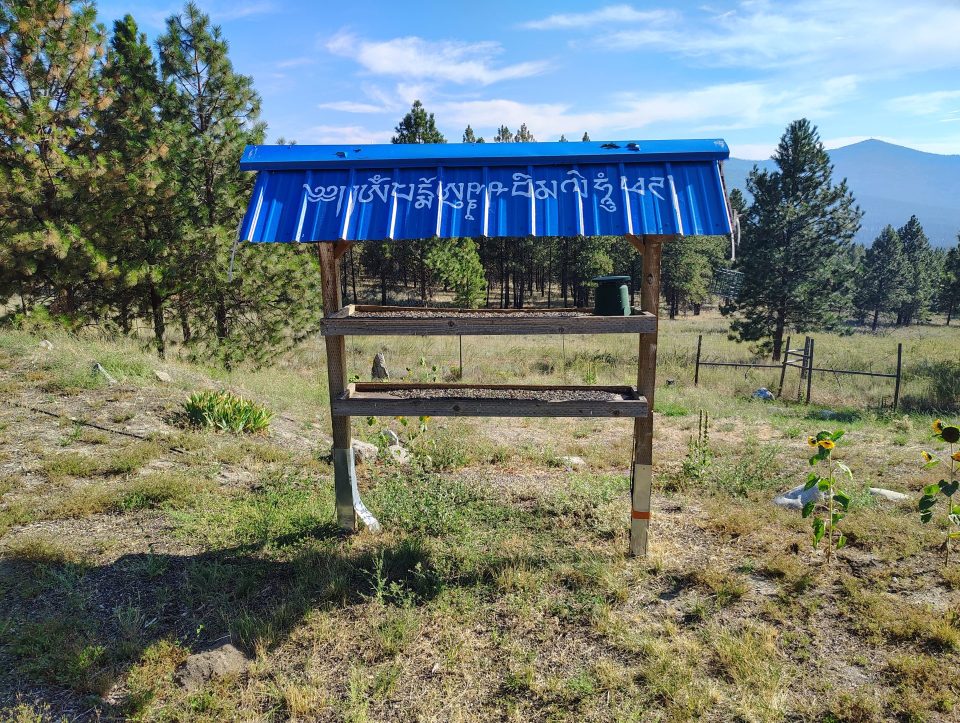
Bird feeder at Buddha Amitabha Pure Land in Washington State, USA.
Through such dedicated efforts, Buddha Amitabha Pure Land embodies Rinpoche’s vision of caring for every living being, ensuring that no act of compassion is too small to bring benefit.
Animal Liberation Project in FPMT Mongolia
Since 2019, FPMT Mongolia has been deeply committed to one of Lama Zopa Rinpoche’s most cherished activities – liberating animals from suffering and premature death, while offering them the opportunity to receive positive Dharma imprints. This unique project, now in its seventh year, has grown into a vibrant and compassionate initiative that continues to inspire communities across Mongolia.
Currently, the liberated herd includes 96 animals (mainly goats), lovingly cared for by a dedicated local herder Jigmed (pictured at top of page). These animals roam freely across the vast landscapes of Bulgan Aimag, marked for identification and protected throughout the harsh Mongolian winters with supplemental food and shelter.
In 2024, several new animals were added to the herd and received blessings from Geshe Thubten Soepa and other geshes during H.E. Jhado Rinpoche’s visit. These additions have expanded the animal family and deepened the responsibility to care for them until their natural passing.
Unlike traditional animal liberation practices where animals are released and never seen again, FPMT Mongolia’s approach emphasizes ongoing care, spiritual blessings, and community engagement. Each year, staff and nuns travel to visit the herd, meet with the herder, and perform prayers and rituals, ensuring the animals continue to receive Dharma imprints.
In 2025 the Animal Liberation Fund offered a grant to support:
- Herder salary and community gifts
- Annual team visits for blessings
- Supplemental food and winter care
- Veterinary and medical supplies
This compassionate work is gaining recognition among local herders, many of whom now believe that having liberated animals in their herds brings protection and better health to all. This unique liberation model ensures long-term care and Dharma exposure, fulfilling Rinpoche’s vision in a culturally resonant way.
Nalanda’s Animal Welfare Initiative
In 2025, the Animal Liberation Fund contributed a grant to support the meaningful work of Nalanda Monastery’s Animal Care Project, a unique initiative dedicated to the welfare of animals living in and around the monastery.
The grant covers essential care and expansion efforts, including:
- Veterinary treatment for stray and injured cats, including infections, cancers, dental issues, and parasite control
- Nutritious food for resident cats
- Onsite nursing, rehoming, and wild release, including support for local monastics caring for animals
- The BeeKind Project, which provides winter feeding, hive maintenance, and colony support for bees
- New wildlife support structures, including 40 songbird nesting boxes and 6 pipistrelle bat roosts built in Nalanda’s workshop.
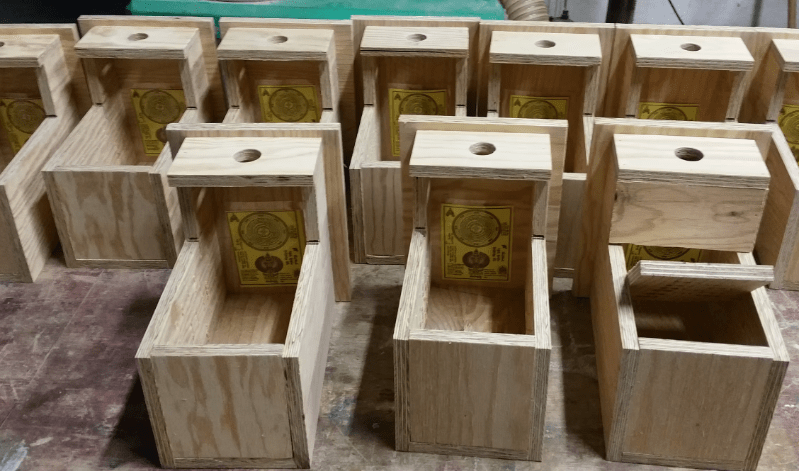
Songbird nesting boxes with mantras at Nalanda’s workshop.
This project demonstrates how Dharma practice can extend into ecological and community care. The support from FPMT ensures that Nalanda can continue offering refuge and healing – not just to humans, but to the animals who share their beautiful space.
With Deepest Gratitude
To our compassionate sponsors: your generosity is the lifeblood of these auspicious activities. Through your support, countless beings are saved, blessed, and guided toward enlightenment. May all the merit generated be dedicated to the enlightenment of all sentient beings!
All are welcome to contribute to the Animal Liberation Fund to help ensure that our work sponsoring animal rescue, care, and liberation continues.
- Tagged: animal care project, animal liberation, animal liberation fund, animal liberation sanctuary, buddha amitabha pure land, fpmt mongolia, nalanda monastery
8
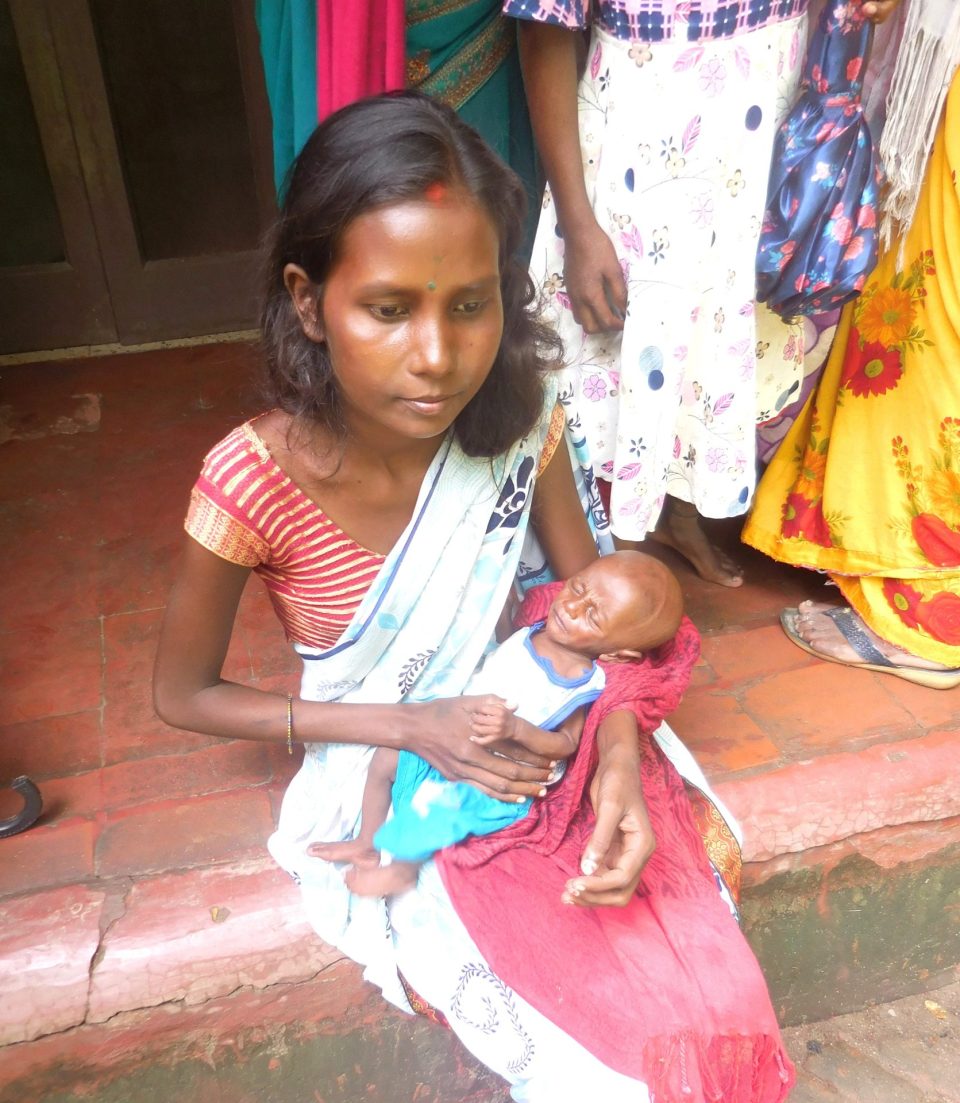
Young mother with child receiving care from the Maitri mobile clinic.
In 2025, the FPMT Social Services Fund (SSF) remained dedicated to its mission of uplifting the most vulnerable populations in India and Mongolia. With a strong focus on supporting children, the elderly, the sick, and the extremely poor, the fund allocated over US$179,706 to essential healthcare and service initiatives. These grants facilitated the operation of health camps, mobile clinics, soup kitchens, and outreach programs, providing life-saving care and support to thousands. In total, these efforts impacted an estimated 44,000 individuals offering not just medical aid but also dignity, hope, and a pathway to well-being. We hope you will enjoy learning about the different health care and essential services we are currently supporting, and how the grants were utilized this year.
Shakyamuni Buddha Community Health Care Centre | Maitri Charitable Trust | Lamp of the Path | Patient Care Trust | Tibetan Heart Foundation | Integrated Indigenous Tribal Children’s Ministry of India | Thame Support Fund | Thank you!

A young patient receiving care from Shakyamuni Clinic.
The Shakyamuni Buddha Community Health Care Centre, located in a remote Bihar region of India, continues to be a vital source of medical care for underserved and isolated communities.
The clinic has made remarkable progress in improving healthcare access and outcomes. The mobile clinic program, which previously operated twice a month, now runs five days a week, reaching five villages – including one newly added this year. This expansion enabled the clinic to serve 10,303 patients through mobile outreach and an additional 23,543 patients at the main clinic, totaling 33,846 individuals reached with free consultations, screenings, and treatments.
The clinic also conducted community health education workshops on hygiene, nutrition, mental health, and disease prevention, reaching approximately 3,000 people. Special attention was given to women’s health, with a female doctor leading sessions on personal hygiene and reproductive health.
Despite these successes, the clinic faced challenges such as poor road conditions, limited medical supplies, and the need for greater infrastructure. Looking ahead, the team aims to open a 4-bed inpatient care facility, acquire an ambulance, and expand preventive health campaigns focused on malaria, clean water, and hygiene.
In 2025, the clinic has received a grant from the Social Services Fund, that covered roughly 75% of their annual budget, helping to sustain and expand its essential services.
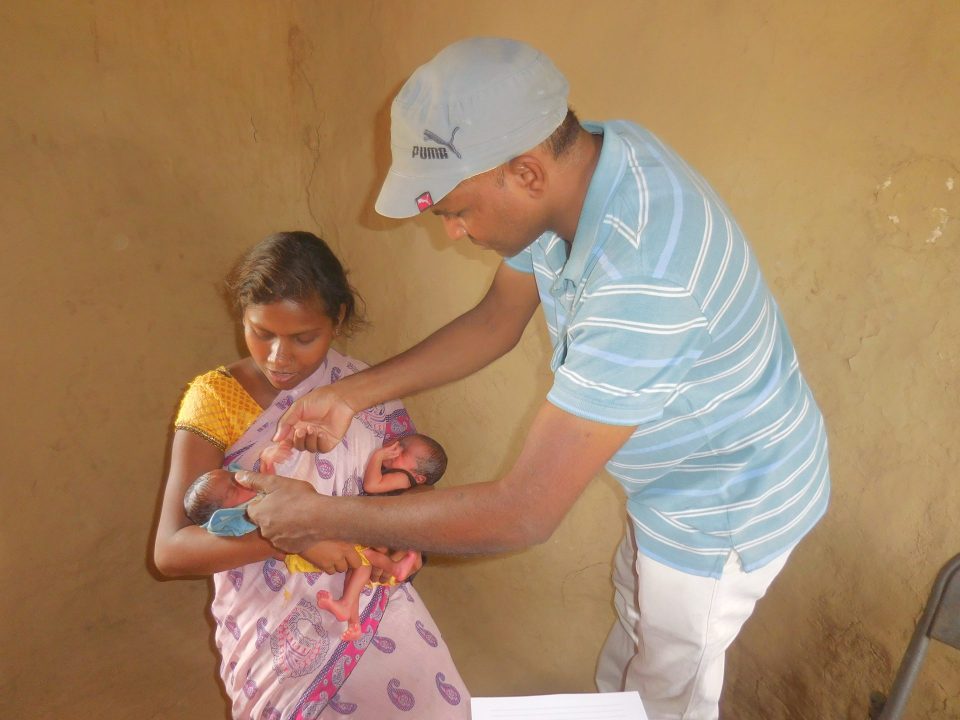
Maitri’s doctor checks on twins in the mobile clinic.
The Maitri Charitable Trust, based in Bodhgaya, India, continues to provide essential health services to vulnerable populations through its Mother and Child Care and Tuberculosis (TB) Care programs.
In 2024, Maitri’s TB Care program identified and registered 475 new TB cases, collected 76 follow-up sputum samples, and provided monthly rations to 302 under-treatment patients. The team conducted awareness campaigns across 1,346 villages, organized educational events for students, and celebrated World TB Day with community outreach and educational material distribution. At the Maitri’s headquarters, 139 individuals were tested for TB, 44 confirmed cases were referred for treatment, and 11 patients were hospitalized.
The Mother and Child Care program registered 335 new mothers, delivered 215 healthy babies including twins, and administered 19 tetanus vaccinations. The program also ensured 27 tubectomies for third pregnancies. For children aged 0-5, 488 new patients were managed, with 265 released from treatment, and 223 children received monthly check-ups and supplements. Among girls aged 6-14, 195 new cases were registered, with 101 released from treatment.
Additional support included the distribution of 144 monthly rations of legume seeds, 461 packets of sanitary pads, and 159 rations of milk powder and infant cereal. The grant also funded critical repairs to Maitri’s facilities and contributed to a Fixed Term Deposit for future sustainability.
In 2025, the grant offered from the Social Services Fund supported Maitri’s ongoing efforts in both field outreach and clinic-based care, covering the entire budget of the Mother and Child and TB programs.
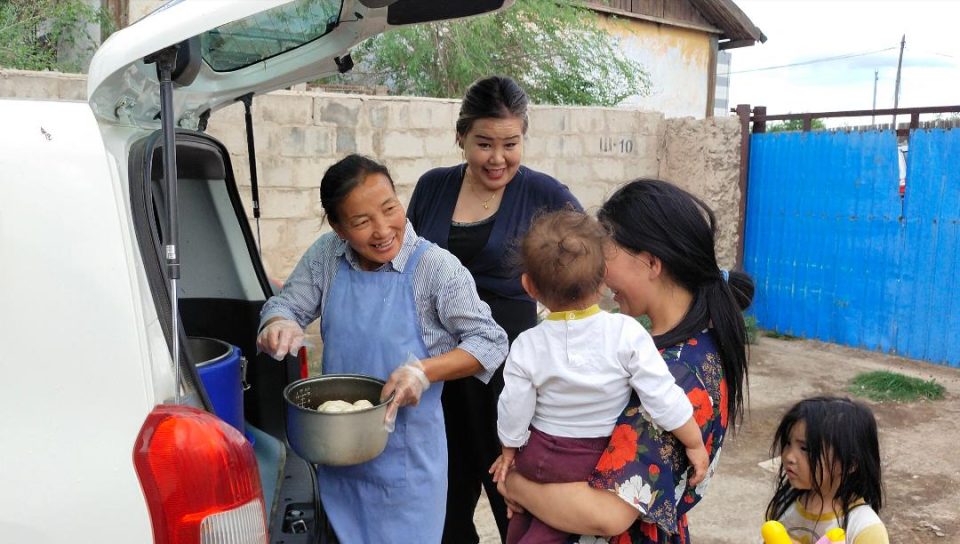
Lamp of the Path’s mobile food delivery program.
The Lamp of the Path (LOP), FPMT Mongolia’s flagship community service project, continues to serve as a vital support system for vulnerable populations in the Amgalan ger district of Ulaanbaatar.
In 2024, LOP provided over 7,245 hot meals through its daily Soup Kitchen, and delivered 6,084 meals to 21 individuals across 7 families who were unable to visit the center due to age, disability, or distance. The kitchen’s renovation this year has enhanced its capacity and improved service quality, much to the satisfaction of both staff and beneficiaries.
LOP also distributed second-hand clothing to over 400 individuals, including children in women’s prisons and homeless men through partner NGOs. The team emphasized dignity in service by allowing beneficiaries to choose their clothing when possible.
Medical outreach remained a core focus, with multiple health check-ups conducted in collaboration with local hospitals, international volunteers, and medical students. Services included wound care, blood pressure monitoring, and tuberculosis screening. LOP also provided alcohol abuse counseling and hosted 16 AA outreach sessions to support recovery and community reintegration.
The Mahayana Children’s Program (MCP) continued to operate, offering weekly life-skills and creative classes to children aged 6-14. The program also hosted seasonal celebrations and distributed school supplies and clothing to children from disadvantaged families.
LOP’s vegetable garden and greenhouses yielded 1,000 kg of produce, which was used in the soup kitchen, preserved for winter, and sold to generate income. The garden also supported the annual 100 Million Mani Retreat at Idgaa Monastery.
In 2025, the grant offered from the Social Services fund covered the entire annual budget of all of LOP’s wide-reaching programs.
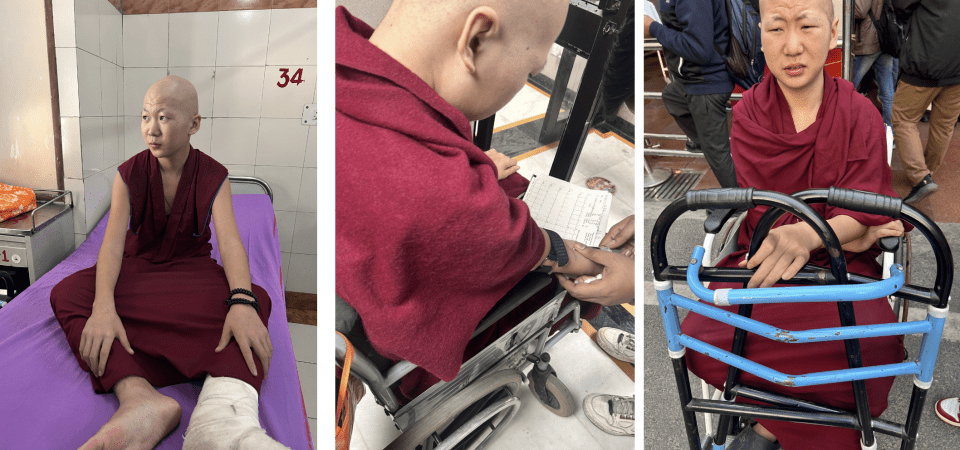
Patient Care Trust 16-year-old monk diagnosed with osteosarcoma undergoing treatment
Patient Care Trust (PCT), a Delhi-based NGO serving the Tibetan refugee community, is committed to delivering accessible, affordable, and high-quality healthcare to vulnerable populations across India. Since 2012, the organization focuses on supporting monks, nuns, the elderly, and destitute individuals through a combination of direct medical aid, housing support, and large-scale outreach programs.
In 2024 alone, PCT assisted 3,499 patients, including 3,273 through its free medical camps in Dharamsala and South India (Bylakuppe). These camps, staffed by top specialists from AIIMS Delhi and other institutions, provided general and specialist consultations, diagnostic tests, cancer screenings, and free medications. One such camp in Bylakuppe served 2,800 patients in just four days, with the oldest patient being 100 years old. The camp offered services across 20 departments and screened 81 women for cervical cancer, 12 of whom tested positive and were guided into further treatment.
Beyond camps, PCT’s impact is deeply personal. The organization provided housing, food, translation, and financial aid to patients undergoing long-term treatment in Delhi. The 2024 patient casebook tells stories of resilience and recovery – from a 6-year-old girl battling a brain tumor to elderly patients receiving life-saving surgeries, and monks and laypeople overcoming cancer, kidney disease, and neurotrauma with PCT’s unwavering support.
In 2025, the grant offered covered half of the annual budget of the life-saving work of Patient Care Trust.
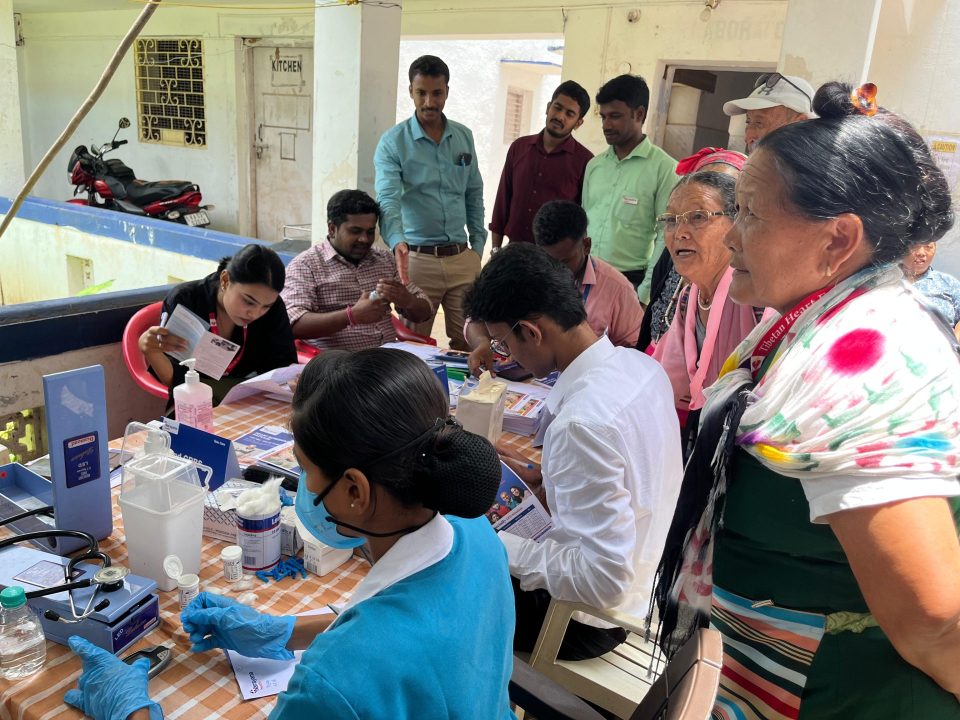
Tibetan Heart Foundation’s free medical camp.
Tibetan Heart Foundation (THF), based in New Delhi, India, is an NGO dedicated to supporting the underserved Tibetan settlements across both northern and southern India.
The foundation’s core mission is to raise awareness about heart-related health issues and provide access to life-saving cardiac care. Through its free medical camps and patient support services, THF ensures that vulnerable individuals receive timely diagnosis, treatment, and follow-up care. The foundation also plays a vital role in guiding patients to top-tier hospitals, offering translation and logistical support, and easing the burden of medical journeys for those facing language and financial barriers.
In 2025, THF is organizing free medical health camps in key Tibetan settlements including Bylakuppe, Kollegal, Hunsur, Mundgod, and Mainpat in the south, and Ladakh, Manali, Dehradun, Odisha, and Bandra in the north. These camps will offer a wide range of services such as cardiovascular screenings (including BP monitoring and ECGs), eye and dental check-ups, gynecological and prenatal care, diabetes and ENT screenings, orthopedic and oncology consultations, and general health check-ups. Essential medicines and preventive healthcare kits will also be distributed free of cost.
The Social Services Fund offered a grant in 2025 to support their mission.
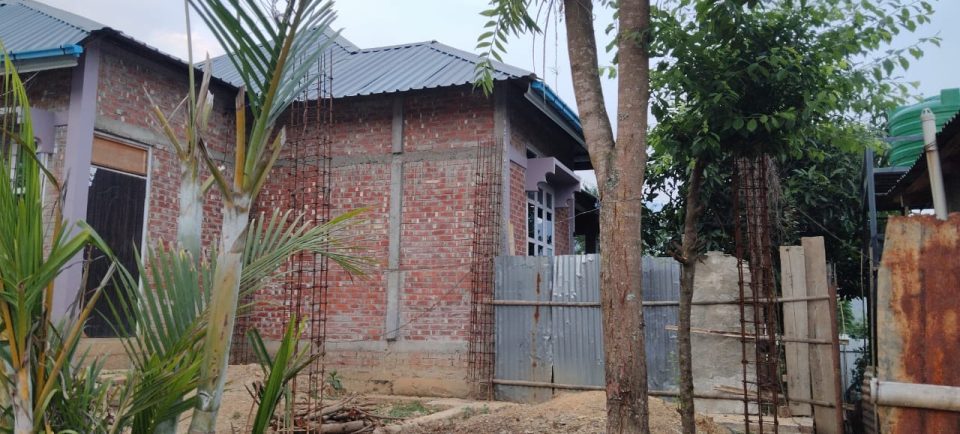
Nearly finished construction of the orphanage in Manipur.
Integrated Indigenous Tribal Children’s Ministry of India (IITCMI) is an NGO based in Manipur, India, dedicated to supporting orphaned and homeless children from indigenous and tribal communities. The organization’s mission is to provide a safe, nurturing environment where children can access shelter, education, healthcare, and emotional support.
One of IITCMI’s most impactful initiatives is the construction of a permanent orphanage facility, which began in 2019. This project has been made possible through the major contribution from Lama Zopa Rinpoche via the Social Services Fund.
In 2025, the project received an additional grant to support the final phase of construction.
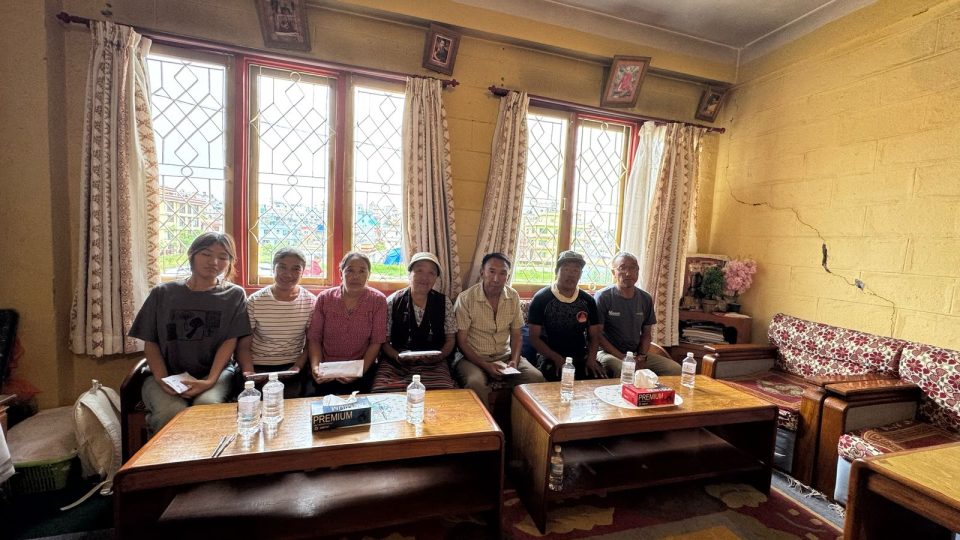
Seven families received essential aid after their houses were destroyed by the Thame floods.
On August 16, 2024, Thame, which is the birthplace of our kind guru Kyabje Lama Zopa Rinpoche and is situated at an altitude of 12,450 feet (3,800 meters) and has a population of 300 Sherpas, suffered immense devastation. The flood destroyed half the village, including houses, hotels, the school and health clinic plus essential infrastructure. Through the Thame Support Fund we were able to quickly raise funds and offer direct support to 55 families from Thame, who were profoundly affected by the catastrophic floods.
On June 16, 2025, through the Social Services Fund we were able to offer US$7156 to seven families who had lost everything in the floods. Many of the families from Thame are still in Kathmandu, so the disbursement was carried out at Khachoe Ghakyil Nunnery.
Thank you!
Thank you to everyone who contributed during this most desperate time to support the families of Thame, especially Yeshe Norbu Association, that has offered an incredible amount of support over the years to important projects benefiting Tibetan refugees.
Please join us in rejoicing in the many ways the FPMT Social Services Fund is offering direct support to those most in need in India, Nepal and Mongolia. To all our generous sponsors and supporters – thank you! Your compassion and commitment have made this impact possible. Every contribution has helped bring healing and hope to the most vulnerable among us.
If you would like to be part of this meaningful work, please consider supporting the FPMT Social Services Fund. Together, we can continue to extend our reach and uplift even more lives in the years to come.
The Social Services Fund, established to support Lama Zopa Rinpoche’s Vast Visions for the FPMT organization, focuses efforts primarily in India, Nepal, Tibet and Mongolia. Funds help children, the elderly, sick, and very poor.
- Tagged: integrated indigenous tribal children ministry of india, lamp of the path, maitri charitable trust, patient care trust, shakyamuni buddha health care center, thame, thame support fund, tibetan heart foundation
22
Lama Zopa Rinpoche’s Vast Visions for the FPMT organization include supporting practice and realizations, including sponsoring 100 Million OM MANI PADME HUM mantra retreats, sponsoring individuals to complete 1,000 Nyung Nä retreats, and encouraging the recitation of the Golden Light Sutra as much as possible in as many places as possible around the world to create the causes for peace.
This page reports the current count of completed 100 Million OM MANI PADME HUM retreats, 1,000 Nyung Na retreats, and Golden Light Sutra recitations around the world to track the fulfillment of Rinpoche’s Vast Visions and for rejoicing!
100 Million Mani Retreats | 1,000 Nyung Nä Retreats | Golden Light Sutra Recitations
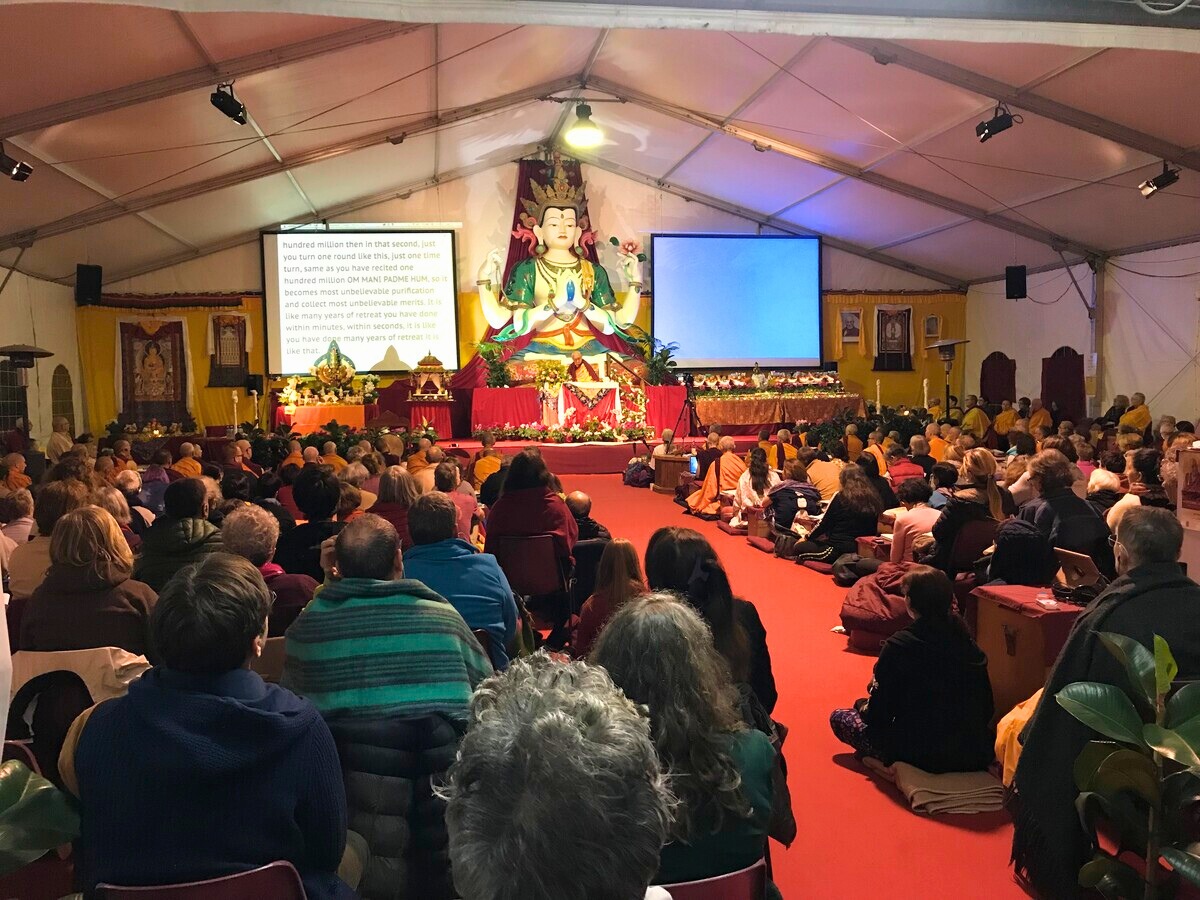
Lama Zopa Rinpoche teaching during the 100 Million Mani Retreat, ILTK, Italy, October 5, 2017. Photo by Ven. Roger Kunsang.
100 Million OM MANI PADME HUM Retreats
[I would like] for the organization to establish 100,000 recitations of 100 million OM MANI PADME HUM mantras. This can be retreats of 100 million recitations, so 100,000 different retreats in different parts of the world and where it is happening, then for it to happen regularly, each year.
—Lama Zopa Rinpoche
Below tracks the progress of Rinpoche’s Vast Vision to sponsor 100,000 retreats of 100 million OM MANI PADME HUM mantras, in different parts of the world, each year.
There are two ways to count this, one way is once it is established for it to happen regularly each year. Or it can happen in different places, one time and you count like that, maybe they are unable to do regularly but able to do one time or a few times…So to establish this in different parts of the world such as Mongolia, Tibet, Nepal, Australia, China, etc.
—Lama Zopa Rinpoche
Total worldwide count of 100 Million OM MANI PADME HUM retreats: 42
Last updated July 2025
Places that have offered 100 Million OM MANI PADME HUM retreats
These retreats accumulated at least 100 million mani recitations among the participants.
- 24 retreats offered by the nuns of Tashi Chime Gatsal Kagyu Nunnery in Nepal, as well as supporting a geshe to teach lamrim to the nuns.
- 1 retreat offered by Institut Vajra Yogini, France.
- 1 retreat offered by Instituto Lama Tzong Khapa
- 12 retreats offered by Ganden Do Ngag Shedrup Ling, FPMT center in Mongolia and this is now an annual event.
- 2 retreats at Potawa Nunnery, Tibet.
- 1 retreat, Tsum, Nepal at Rachen Nunnery.
- 1 retreat, Rabagayling Tibetan Settlement in Hunsur in the community hall that was sponsored by Lama Zopa Rinpoche.
Other Mani Retreats
Smaller mani retreats that accumulated millions of recitations among the participants.
- 500-600 people held a one week mani retreat in Tsum in honor of His Holiness the Dalai Lama’s 80th birthday and recited 30,587,000 mani mantras.
- Since 2008 Rinchen Jangsem Ling has held an annual mani retreat, averaging about 35 million mantras each year.
Help Us Offer Grants
The Practice and Retreat Fund offers grants toward the successful completion of 100 Million Mani Retreats. If you would like to contribute to Rinpoche’s Vast Vision, you may contribute any amount to this fund below.
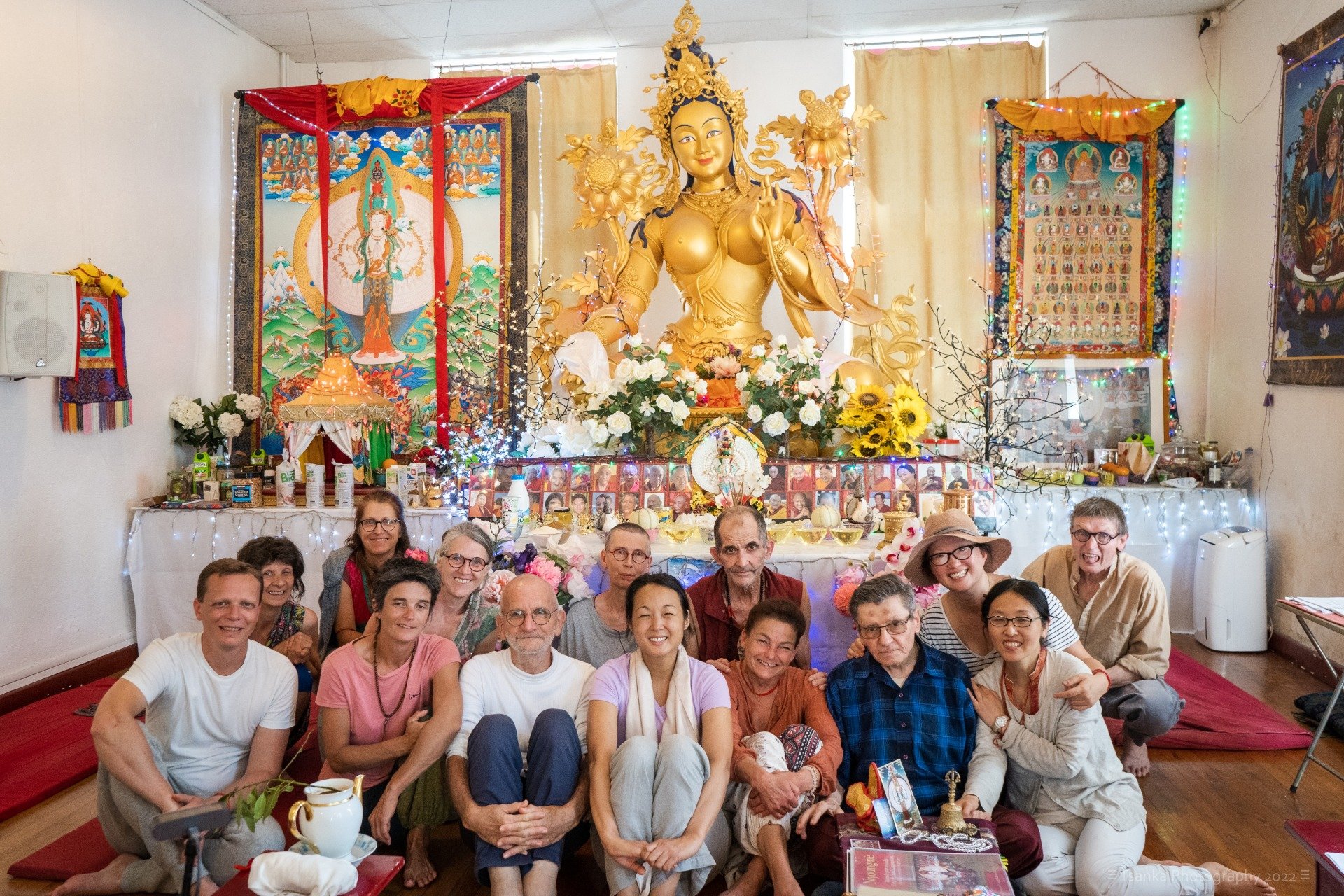
Participants of the 108 Nyung na retreats being held at Institut Vajra Yogini, France, June 2022.
1,000 Nyung Nä Retreats
Nyung Nä does not just purify many eons of negative karma, especially developing compassion, which means bodhicitta, it makes us so much closer to enlightenment, so close to being able to enlighten all sentient beings, which is our ultimate goal in life. It also brings you closer to the Guru-Compassion Buddha.
—Lama Zopa Rinpoche
Below find Nyung Nä retreats sponsored by the FPMT organization in fulfilling Rinpoche's Vast Vision to sponsor individuals to complete 1,000 Nyung Nä retreats in their lifetime.
Nyung Näs take such a short time, but bring strong purification. So many eons can be purified in this life; it makes it so easy to have attainments.
—Lama Zopa Rinpoche

Lama Zopa Rinpoche with Ven. Charles and Ven. Namdrol, who both have completed over 1,000 Nyung Na retreats, Istituto Lama Tsong Khapa, Italy, October 2017.
Rejoice! Individuals who have completed more than 1,000 Nyung Näs
A few individuals thus far in the FPMT mandala have completed more than 1,000 Nyung Nä retreats in fulfillment of Rinpoche’s wishes. They are Ven. Kalsang Chodron, Ven. Charles Trebaol, Ven. Tenzin Namdrol, and Valentino Giacomin. Please take a moment to rejoice in their incredible efforts and devotion.
Sponsored 108 Nyung Nä Retreats
Institut Vajra Yogini (IVY) in France offers annual 108 Nyung Nä retreats.
As of 2025, 14 series of 108 Nyung Nä retreats have been completed at IVY.
The Practice and Retreat Fund offers 10,000 Euro each year towards the annual 108 Nyung Nä retreats at IVY, in accordance with Rinpoche’s Vast Visions.
Help Us Sponsor Nyung Nä Retreats
Make an offering to the Practice and Retreat Fund below:
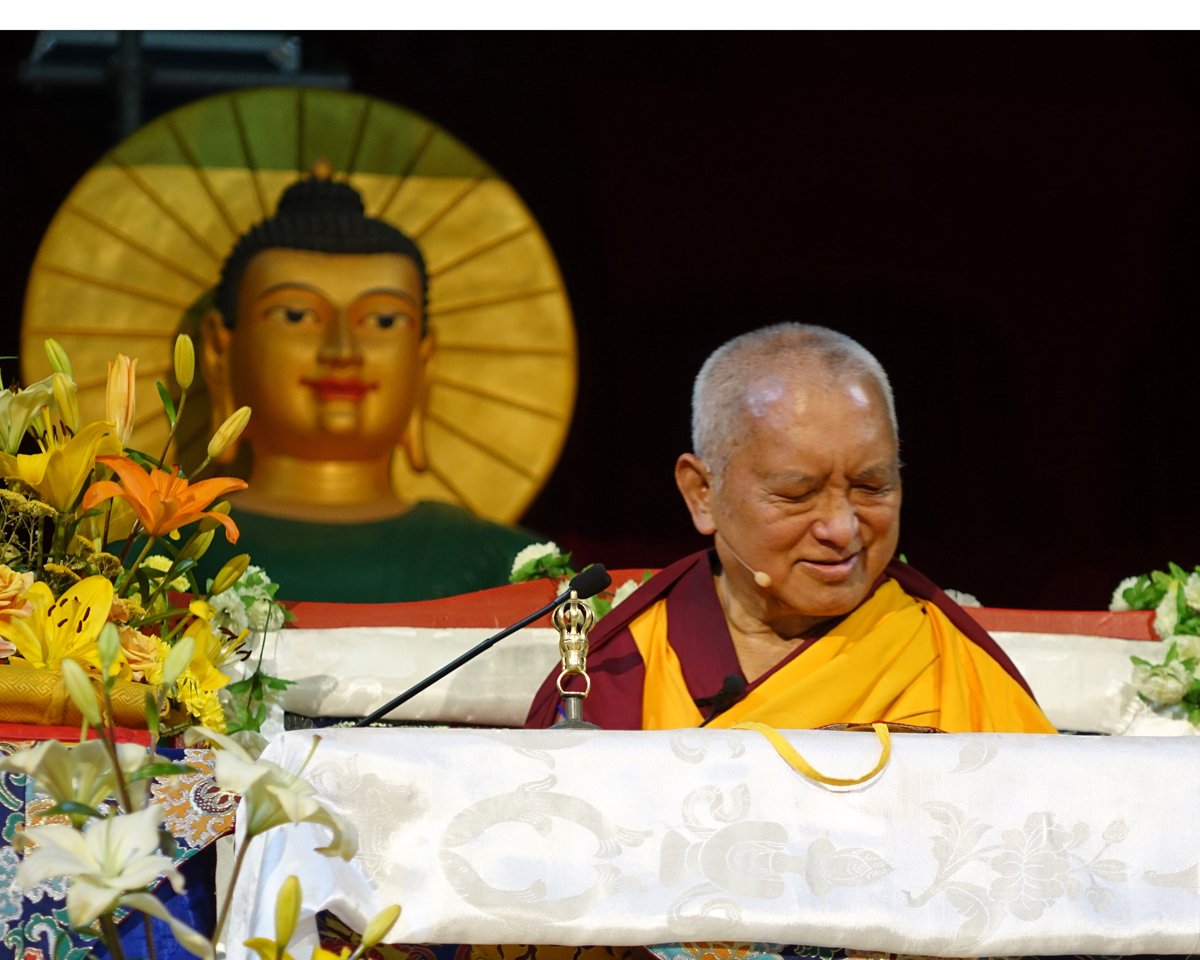
Lama Zopa Rinpoche offering an oral transmission of the Sutra of Golden Light, Great Stupa of Universal Compassion, Bendigo, Australia, October 2014. Photo by Ven. Roger Kunsang.
Reciting the Golden Light Sutra
“The most beneficial thing to have peace and to stop the wars is recitation of the Golden Light Sutra. This is the most beneficial thing to bring peace, everyone should try to do this, no matter how busy they are, even to recite one or two pages, even a few lines.
—Lama Zopa Rinpoche
Below find the total count of recitations reported around the world since 2008! You can also visit the Golden Light Sutra Homepage for detailed information and resources, receiving the oral transmission of the sutra from Lama Zopa Rinpoche, and reporting your recitations.
I would like to make this request with my two palms together, to please recite the Sutra of Golden Light for world peace as much as you can.
—Lama Zopa Rinpoche
Latest Count (updated Dec 31, 2024)
Complete sutra recitations: 58,887
Recited in more than 90 countries
Recent Recitations by Country
Between 2008-2017 there were 45,095 complete recitations of the Golden Light Sutra reported. We began tracking the counts by country in 2018.
Recitation Totals in Previous Years
Note: reporting did not tally specific counts by country until March 2018. Below are the total numbers of complete recitations worldwide per year.
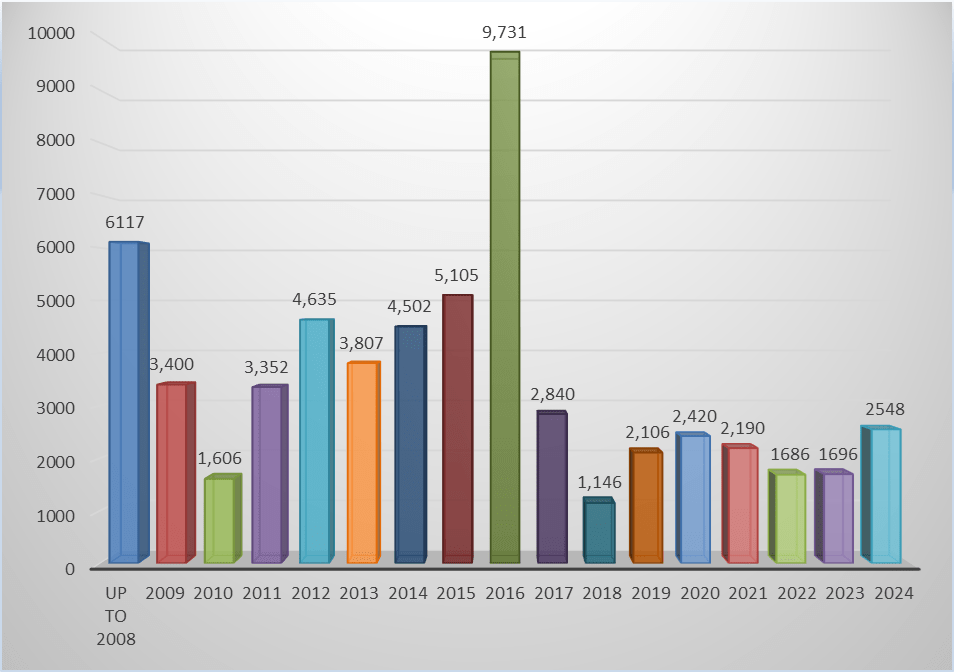
Countries Where Recitations Have Been Completed
“[The Sutra of Golden Light is] extremely powerful for world peace, for your own protection and for the protection of the country and the world. Also it has great healing power for people in the country.
—Lama Zopa Rinpoche
Below is a list of every country where Golden Light Sutra recitations were completed:
Albania, Antarctica, Argentina, Aruba, Australia, Austria, Azerbaijan, Belgium, Belorus, Bhutan, Bosnia, Brazil, Bulgaria, Republic of Buryatia, Cambodia, Canada, Chile, Colombia, Costa Rica, Curaçao, Cyprus, Denmark, Ecuador, Egypt, England, Estonia, Ethiopia, Finland, France, French Polynesia, Germany, Greece, Hong Kong, Hungary, India, Indonesia, Ireland, Israel, Italy, Japan, Latvia, Lebanon, Lithuania, Luxembourg, Macedonia, Malaysia, Malta, Mauritius, Mexico, Mongolia, Montenegro, Morocco, Myanmar, Nepal, Netherlands, New Zealand, Commonwealth of Northern Mariana, Norway, Oman, Panama, P. R. China, Palestine, Panama, Philippines, Poland, Portugal, Puerto Rico, Romania, Russia, Saudi Arabia, Scotland, Serbia, Singapore, Slovenia, South Africa, South Georgia Island, South Korea, Spain, Sri Lanka, Sweden, Switzerland, Taiwan, Thailand, Turkey, Uganda, United Arab Emirates, Ukraine, United States, Vietnam, Wales
Please take a moment to rejoice!
- Tagged: 100 million mani retreat, golden light sutra, nyung nä, nyung na retreat, sutra of golden light, vast visions
11
Lama Zopa Rinpoche’s Vast Visions for the FPMT organization including building many beautiful holy objects around the world.
This page reports the current count of holy objects built in fulfillment of Rinpoche’s Vast Visions, including stupas, prayer wheels, Maitreya statues, Padmasambhava statues, and large thangkas to be displayed around the world at FPMT centers on special occasions—to track the fulfillment of Rinpoche’s Vast Visions and for rejoicing.
100,000 Stupas | 100,000 Prayer Wheels | 1,000 Maitreya Statues | Padmasambhava Statues | Large Thangkas
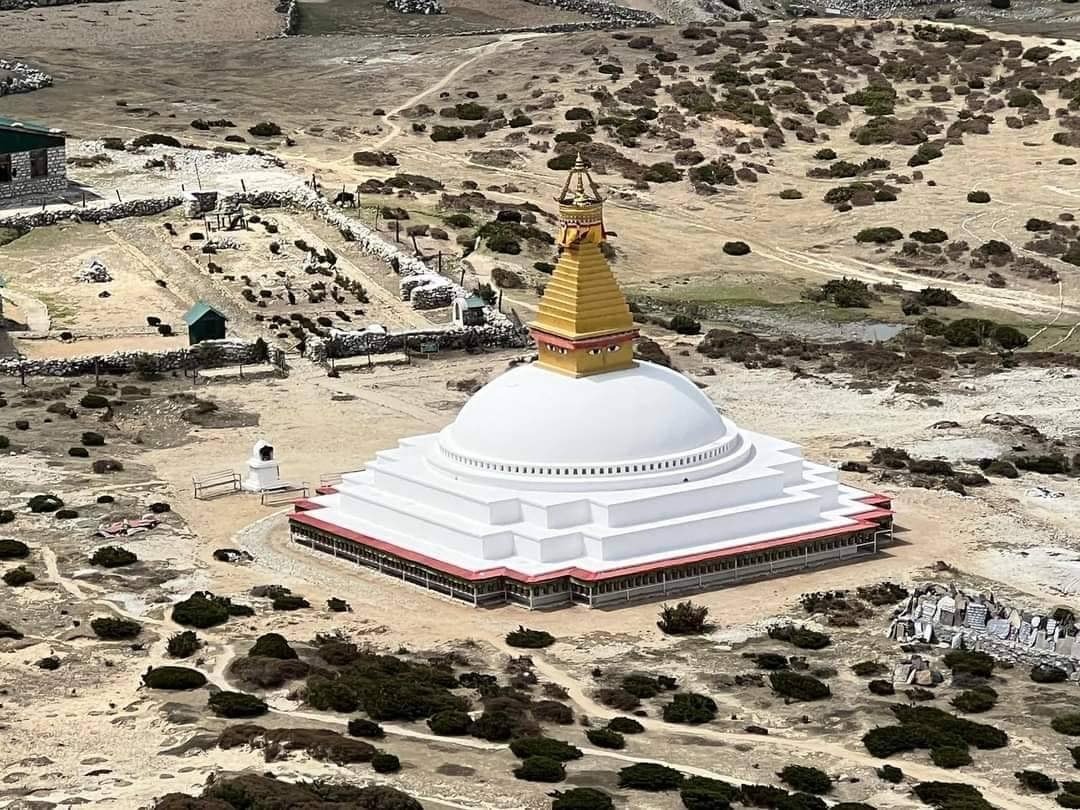
The magnificent Thame stupa, Nepal.
100,000 Stupas Around the World
Since there is unbelievable benefit such as liberating sentient beings, then I thought that the whole organization could aim to build 100,000 stupas (minimum size of one story up to the distance from the earth to the moon) in different parts of the world and for FPMT to do this as a whole.
—Lama Zopa Rinpoche
Below find a list of stupas that have been completed or are in progress, which meet the criteria for Rinpoche’s Vast Visions. Also please enjoy a short photo gallery of completed stupas.
Building stupas helps develop so much peace and happiness for numberless sentient beings. As a result, wars, disease, and desire will all be pacified. Instead of feeling hopeless, people will gain courage.
—Lama Zopa Rinpoche
To date, 55 stupas, a minimum of one story high (10 feet/3 meters), have been completed or are in progress, at FPMT centers and by FPMT students, toward this goal of 100,000 stupas around the world. Please see the worldwide list below. Stupas marked by a ♦ meet the minimum size requested by Lama Zopa Rinpoche.
North America
- 3m/10ft – Kadampa Stupa at Kachoe Dechen Ling, California, US ♦
- 2m/6ft – Lama Yeshe Cremation Stupa at Vajrapani Institute, California, US
- 5m/16ft – Lama Yeshe’s Enlightenment Stupa at Vajrapani Institute, California, US ♦
- 2m/6ft – Kadampa Stupa at Land of Medicine Buddha, California, US
- 11.8m/39ft – Mahabodhi Stupa, at LMB, California, US ♦
- 4.5m/15ft – Kalachakra Stupa at Kurukulla Center, Massachusetts, US ♦
- 5.5 m/18ft – Kadampa Stupa at Kadampa Center, North Carolina, US ♦
- 4.2m/14ft – Auspicious Stupa of Many Doors at Milarepa Center, Vermont, US ♦
- 4.9m/16ft – Enlightenment Stupa at Pamtingpa Center, Tonasket, Washington, US ♦
- 2.7m/9ft – Enlightenment Stupa at Gendun Drubpa, Canada
- 4.9m/16ft – Enlightenment Stupa, Vancouver Island, Canada ♦
- 3m/10ft – Kadampa Stupa, Khamlungpa Center, Mexico ♦
- 6m/20ft – Turning of the Dharma Stupa, Mexico ♦
- Kalachakra Stupa for World Peace at Serlingpa Retreat Center, Mexico
- 3m/10ft – Descent from Tushita Stupa, containing approximately 15 relics, many of 26 different mantras, including the Four Dharmakaya Relic mantras, Cozumel, Mexico. ♦
Europe
- Kadampa Stupa built for Lama Yeshe and International Year of Tibet (1991) at Institut Vajra Yogini, France ♦
- 4m/13ft – Enlightenment Stupa at Nalanda Monastery, France ♦
- 4m/13ft – Kadampa Stupa at Kalachakra Centre, France ♦
- Descent from Tushita Stupa at Kopavogur, Iceland
- 1 Enlightenment Stupa built for Lama Yeshe, Geshe Rabten, Geshe Yeshe Tobden, and Gomo Tulku, at ILTK, Italy
- 1 Reconciliation Stupa built for Lama Yeshe, Geshe Rabten, Geshe Yeshe Tobden, and Gomo Tulku, at ILTK, Italy
- 2m/6.5ft – Enlightenment Stupa at Centro Lama Tzong Khapa Treviso, Italy
- Kadampa Stupa at Kushi Ling Retreat Centre, Italy
- Lama Yeshe Enlightenment Stupa at Jamyang Buddhist Centre, London, UK (Built in 1988, contains, Lama Yeshe’s bone relic, and was consecrated by Lama Zopa Rinpoche)
- 1.5m/5ft Kadampa Stupa with Geshe Thubten Tsering’s ashes at Centro Nagarjuna Valencia, Spain
- Enlightenment Stupa built for Lama Yeshe at Osel Ling, Spain
- Eight stupas at Centro Muni Gyana, Palermo, Italy.
Pacific Region
- 50m/164ft – The Great Stupa of Universal Compassion, Atisha Center, Victoria, Australia, in progress ♦
- 6.7m/22ft – Kadampa Stupa, Atisha Centre, Victoria, Australia ♦
- 9m/29.5ft – Enlightenment Stupa at De Tong Ling Retreat Centre, Kangaroo Island, Australia ♦
- 3.6m/12ft – Stupa at Kunsang Yeshe Retreat Centre, New South Wales, Australia ♦
- 4m/13ft – Stupa of Complete Victory at Thubten Shedrup Ling Monastery, Victoria, Australia ♦
- Victory Stupa at Vajrayana Institute, New South Wales, Australia
- Garden of Enlightenment Stupa at Chenrezig Institute, Queensland, Australia
- Victory Stupa at Chenrezig Institute, Queensland, Australia
- 8m/26ft – Auspicious Stupa with Many Doors at Dorje Chang Institute, Auckland, New Zealand ♦
- 5.2m/17ft – Long Life Stupa at Chandrakirti Buddhist Meditation Centre, Nelson, New Zealand ♦
- Enlightenment Stupa at Mahamudra Center, New Zealand
Asia
- 6m/19.6ft – Enlightenment Stupa built for Lama Yeshe at Tushita Meditation Centre, Dharamsala, India ♦
- Auspicious Stupa of Many Doors built for Geshe Rabten at Tushita Meditation Centre, Dharamsala, India
- Parinirvana Stupa built for Geshe Wongdu at Tushita Meditation Centre, Dharamsala, India
- 1m/3ft – Marble Stupa at IMI House in Sera Je Monastery, India
- 5m/16.4ft – Reconciliation Stupa at IMI House in Sera Je Monastery, India ♦
- 2.5m/8.2ft – 7 Kadampa Stupas at IMI House in Sera Je Monastery, India ♦
- 6.4m/21ft – Kadampa Stupa (8 smaller stupas) at Root Institute in progress ♦
- 6m/20ft – Enlightenment Stupa built for Lama Zopa Rinpoche’s mother, located between Lawudo and Namche Bazaar in a village called Samshing, Nepal ♦
- 11.5m/38ft – Enlightenment Stupa at Lawudo, Nepal ♦
- 8.5m/28ft – Victory Stupa at Lawudo, Nepal ♦
- 3m/10ft – Stupa for Lama Zopa Rinpoche’s mother’s incarnation, Nawang Zhimay, located below Lawudo in a village called Teshok ♦
- Eight Stupas at Kopan Monastery, Nepal
- 10.7m/35ft – Geshe Lama Konchog’s Dharmachakra Stupa at Kopan Monastery, Nepal ♦
- Thousand Buddha Relics Stupa for Geshe Lama Konchog’s relics, a row of 8 stupas and a golden stupa for Lama Yeshe’s relics, at Kopan Monastery, Nepal
- 7.6m/25ft – Lama Lhundrup’s Stupa, Kopan Monastery, Nepal ♦
- Lama Lhundrup’s Stupa at Kopan Nunnery ♦
- Lama Yeshe’s Stupa at Kopan Monastery, Nepal
- 3m/9.8ft – Enlightenment Stupa in Boudhanath, Nepal at one student’s house
- Namgyalma Stupa, Losang Drakpa Center, Malaysia
- 4.5m/14.8ft – Victory Stupa at Golden Light Sutra Center, Mongolia ♦
- Enlightenment Stupa at Shakyamuni Buddhist Center, Taiwan
- 6m/20ft – Geshe Sengye’s stupa in Tibet ♦
- 5.5/18ft – Enlightenment Stupa, Taplejung District, Nepal (built by Losang Namgyal Rinpoche) ♦
- 5.5/18ft – Enlightenment Stupa, Okhaldunga District, Nepal (built by Losang Namgyal Rinpoche) ♦
- 6.4/21ft – Enlightenment Stupa, Lalitpure District, Nepal (built by Losang Namgyal Rinpoche) ♦
- 5.5m/18ft – Stupa, Okhaldunga District, Nepal (built by Losang Namgyal Rinpoche) ♦
- 5.5m/18ft – Nirvana Stupa, Rasuwa District, Nepal (built by Losang Namgyal Rinpoche) ♦
- 5.5/18ft – Pepung Stupa (Lotus Stupa), Nuwakot District, Nepal (built by Losang Namgyal Rinpoche) ♦
- 5.5m/18ft – Stupa in Rasuwa District, Nepal (built by Losang Namgyal Rinpoche) ♦
- 7.5m/24.5ft – Namgyalma Stupa in Rinchen Jansem Ling, Malaysia. ♦
Offerings Made to Build Stupas
- 32m/105ft – Chogyey Trichen Rinpoche’s Stupa (with a 16.5m/54ft diameter dome), Nepal, US$7,700 offered.
Further Resources
- FPMT’s Holy Objects Resources Page
Offer Your Support
The Stupa Fund provides the resources needed for building 100,000 stupas around the world. This is part of Lama Zopa Rinpoche’s Vast Visions for FPMT.
Please enjoy this photo gallery of stupas at FPMT centers around the world, inspired by Lama Zopa Rinpoche’s Vast Vision to build 100,000 stupas. Some of the stupas pictured have received sponsorship from the FPMT Stupa Fund.
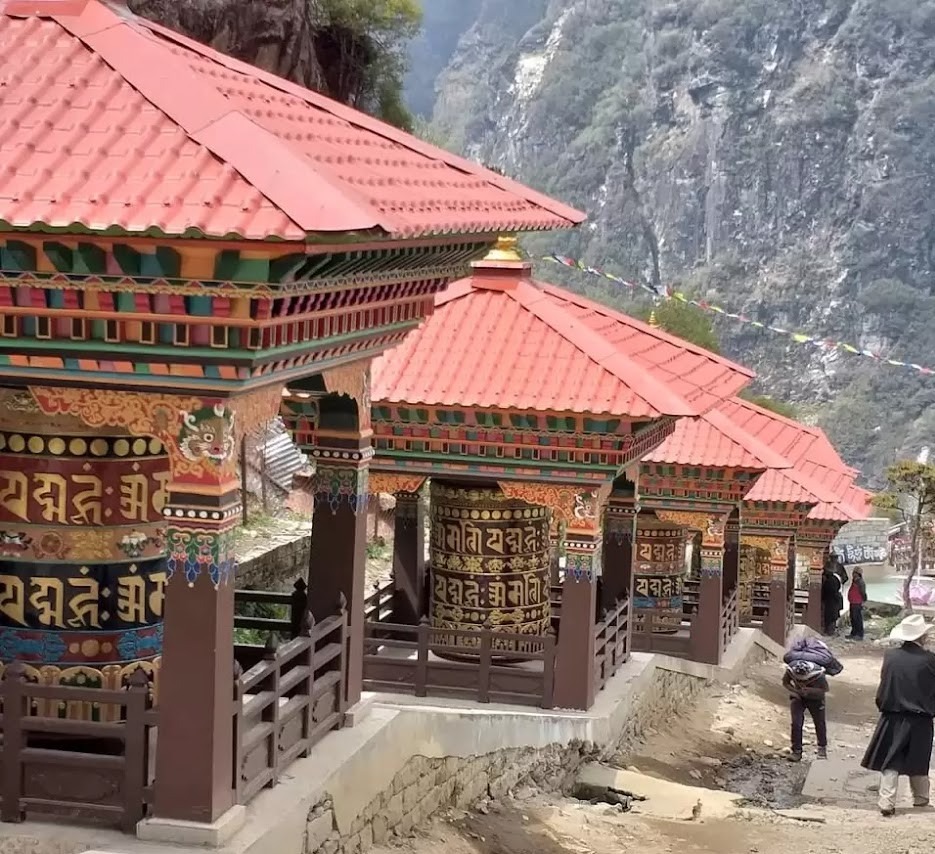
Giant prayer wheels at the Namche Stupa and Mani Park, Namche Bazaar, Nepal.
100,000 Prayers Wheels Around the World
“[I would like] for the whole organization to build 100,000 prayer wheels in different parts of the world, [including prayer wheels under the ocean], a minimum height of six feet. Prayer wheels are a great blessing for each country.
—Lama Zopa Rinpoche
Below find a list of large prayer wheels that have been completed or are in progress, which meet the criteria for Rinpoche's Vast Visions, as well as a photo gallery of prayer wheels.
“The reason why I’d like to build as many as possible is because in the texts it says: If you do prayers as a group, then it is a hundred times more powerful than doing it alone in the room…If we do it as the whole organization, as a project, then if everybody offers $10 or $5 or even smaller thinking that you are contributing to building a stupa, then in this way it becomes everyone’s project. In this way the karma is very powerful if we do it with many people, all together.
—Lama Zopa Rinpoche
Prayer Wheels Completed/In Progress
To date, approximately 20 large prayer wheels and many smaller prayer wheels have been built. Please rejoice!
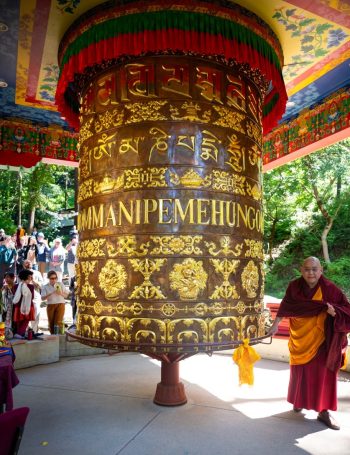
H.E. Ling Rinpoche after the consecration for the prayer wheel at Vajrapani Institute, USA, June 2024.
Northern & Central America
- Prayer wheel containing over 170 billion mantras as well as many sets of texts, Land of Medicine Buddha, CA, USA
- Prayer wheel containing 12 billion mantras, Land of Medicine Buddha, CA, USA
- Pagoda prayer wheel containing 64 billion mantras, Land of Medicine Buddha, CA, USA
- Prayer wheel containing over 3 quadrillion mantras, Vajrapani Institute, CA, USA.
Europe
- 1.7m x 3m/5.56ft x 9.94ft – Prayer wheel containing 24,660,651,040 mantras on paper and more on microfilm, at Maitreya Institute, The Netherlands.
- 2.5m x 2m/8.2ft x 6.5ft – Prayer wheel containing millions of mani mantras, and other mantras advised by Lama Zopa Rinpoche, as well as a set of the Kangyur and the collection of Lama Tsongkhapa’s writings, at Kushi Ling Retreat Center, Italy.
- 2.5m x 1.2m/8.2ft x 3.9ft – Prayer wheel containing 108 billion MANI mantras, at Institut Vajra Yogini, France.
- 3-4m/10-13ft – Large prayer wheel and prayer wheel house at Osel Ling Retreat Center, Spain.
Pacific Region
- 3m/10ft- Prayer wheel containing 111 billion OM MANI PADME HUM mantras, over 500 Buddhist texts (2 Kangyur, 1 Tengyur, 2 Je Sungbum and others), as well as 5 million other prayers and mantras including Guru Rinpoche prayer and mantra, Five Powerful Deities Purifying Mantras and Vajrasattva and Medicine Buddha mantras as advised by Kyabje Lama Zopa Rinpoche, at Dorje Chang Institute, New Zealand.
- Prayer wheel at Chenrezig Institute, Australia
- 3m x 2.1m/10ft x 7ft – Prayer wheel containing over ten billion mantras at Chandrakirti Meditation Center, New Zealand.
- Large prayer wheel at Mahamudra Centre, New Zealand.
- 2.8m x 2.8m/9ft x 9ft – Prayer wheel containing approximately 250,000,000 mantras including copies of the Dharmakaya Relic Mantras; also inside the wheel is the complete set of kangyur and half of the tengyur, at Thubten Shedrup Ling Monastery, Australia.
- 3m/10ft – Prayer wheel at Atisha Centre, Bendigo, NSW, Australia
Asia
- Large prayer wheel and surrounding smaller wheels – the large prayer wheels contains 100,000,000 OM MANI PADME HUM mantras and nearly 400,000 are included in the smaller prayer wheels, at Dickey Larsoe Tibetan Settlement, a Tibetan settlement in Bylakuppe, South India.
- Gigantic prayer wheel containing the Kangyur, one set of Lama Tsongkhapa’s teachings, Sutra of Long Life; Chenrezig longest mantra, Kurukulla mantra, Padmasambhava mantra; five powerful deity mantras, at Root Institute, Bodhgaya, India.
- 2.1m/7ft – Prayer wheel containing 10 trillion mantras at Lawudo Gompa, Nepal.
- Large Prayer wheel with approximately 210 million mantras at Kopan Monastery, Nepal.
- 4.3m/14ft – Prayer wheel with over 100 million mantras, built by Losang Namgyal Rinpoche, at Hetauda, Makwanpure District, Nepal
- IN PROGRESS: 4.8m x 3.6m/15ft x 12ft – Prayer wheel at Rinchen Jansem Ling, Malaysia.
- 3.5m/11.4ft – Prayer wheel containing 152 billion mantras at Amitabha Buddhist Centre, Singapore.
Prayer Wheels inspired by Lama Zopa Rinpoche
- 32 – 0.3m/1ft – Prayer wheels surrounding the Ksitigarbha Statue at Land of Medicine Buddha, CA, USA.
- 10 – 14 inch x 10 inch prayer wheels, at Milarepa Center, VT, USA
- 22 – 0.6m x 0.5m/2ft x 1.5ft – Prayer wheels, containing about 12,000,000 mantras in each wheel, at the Garden of Enlightenment, Australia.
- 10 prayer wheels (10 more ordered from Nepal) 0.5m x 0.3m/1.5ft x 1ft at the Garden of Enlightenment, Australia.
- 200 – 0.6m x 0.3m/2ft x 1ft – Prayer wheels mounted directly onto the walls of The Great Stupa, Australia. In progress.
- 7 – 0.6m x 0.58m/2.1ft x 1.9ft – Prayer wheels at Hayagriva Buddhist Centre, Australia.
- 1.2m x 0.3m/4ft x 1ft – Prayer wheel filled with microfilm at Nagarjuna Valencia Center, Spain
- 1.5m x 1m/5ft x 3.5ft – Universal Peace Wheel houses billions of traditional mantras and thousands of handwritten peace statements in Elko, Nevada.
Further Resources
- FPMT’s Holy Objects Resources Page
Offer Your Support
The Prayer Wheel Fund provides the resources needed for building 100,000 prayer wheels around the world. This is part of Lama Zopa Rinpoche’s Vast Visions for FPMT.
Please enjoy this photo gallery of prayer wheels sponsored by the Prayer Wheel Fund.
Also, please enjoy this short video below by Land of Medicine Buddha, “Turning the Great Prayer Wheel”
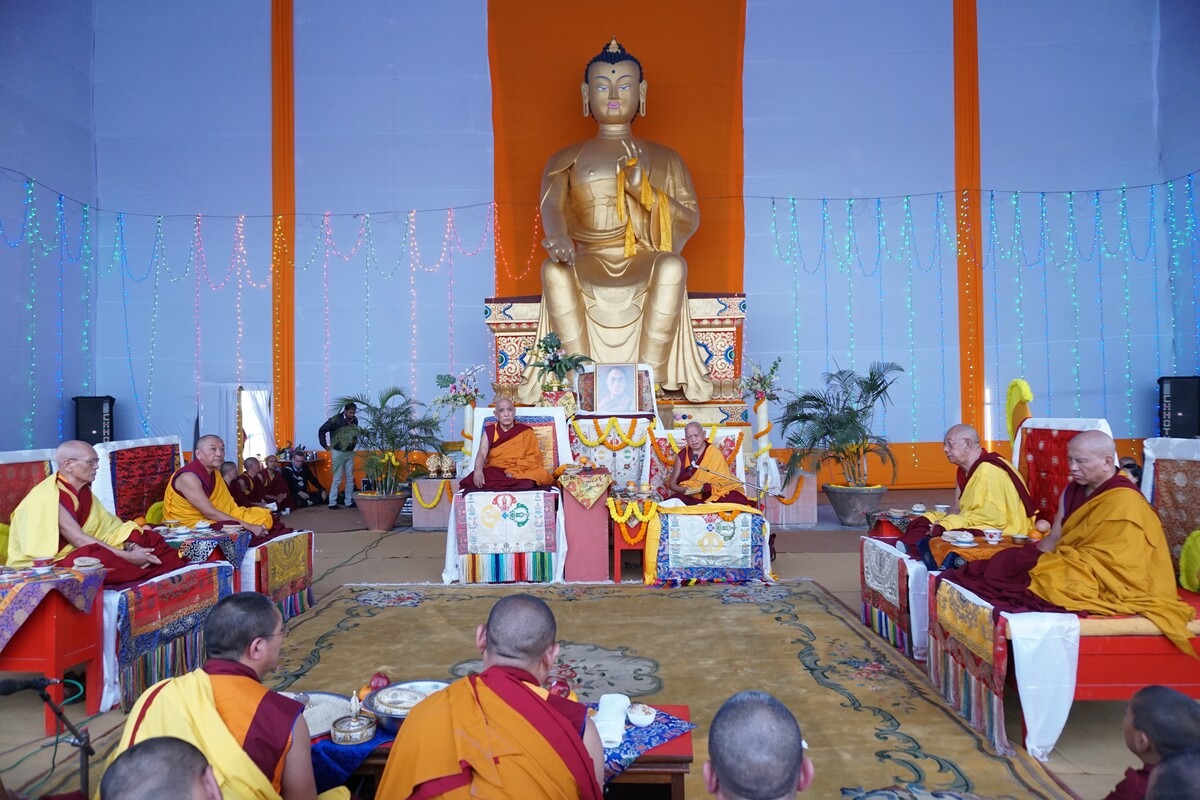
Long Life puja offered to Lama Zopa Rinpoche by Sera Je Monastery in front of the Maitreya Statute, Bodhgaya, January 2017. Photo by Ven. Lobsang Sherab.
1,000 Maitreya Statues
A special thing about contributing to Maitreya, whether it be money or time or energy, is that it makes a connection with Maitreya Buddha, and the result is that one becomes a direct disciple of Maitreya Buddha when Maitreya returns to manifest enlightenment as Shakyamuni Buddha did.
—Lama Zopa Rinpoche
Below find a list of Maitreya statues that have been completed or are in progress, which meet the criteria for Rinpoche's Vast Visions.
Maitreya Buddha is the embodiment of each buddha’s loving kindness, and the symbol of all the bodhisattvas’ loving kindness for all sentient beings.
—Lama Zopa Rinpoche
-
100 life-sized statues from Maitreya Project (26 have been offered to FPMT centers by Lama Zopa Rinpoche)
- Two 24-foot (7.3 m) statues from Maitreya Project (one is at Land of Medicine Buddha in California, the other is on Maitreya Project land in Kushinagar)
- Two-story statue built in a Monastery in Asia
- One-story statue built in a Nunnery in Asia
Offer Your Support
Make a tax-deductible donation to the Holy Objects Fund below:
Please enjoy this gallery of Maitreya statues at FPMT centers.
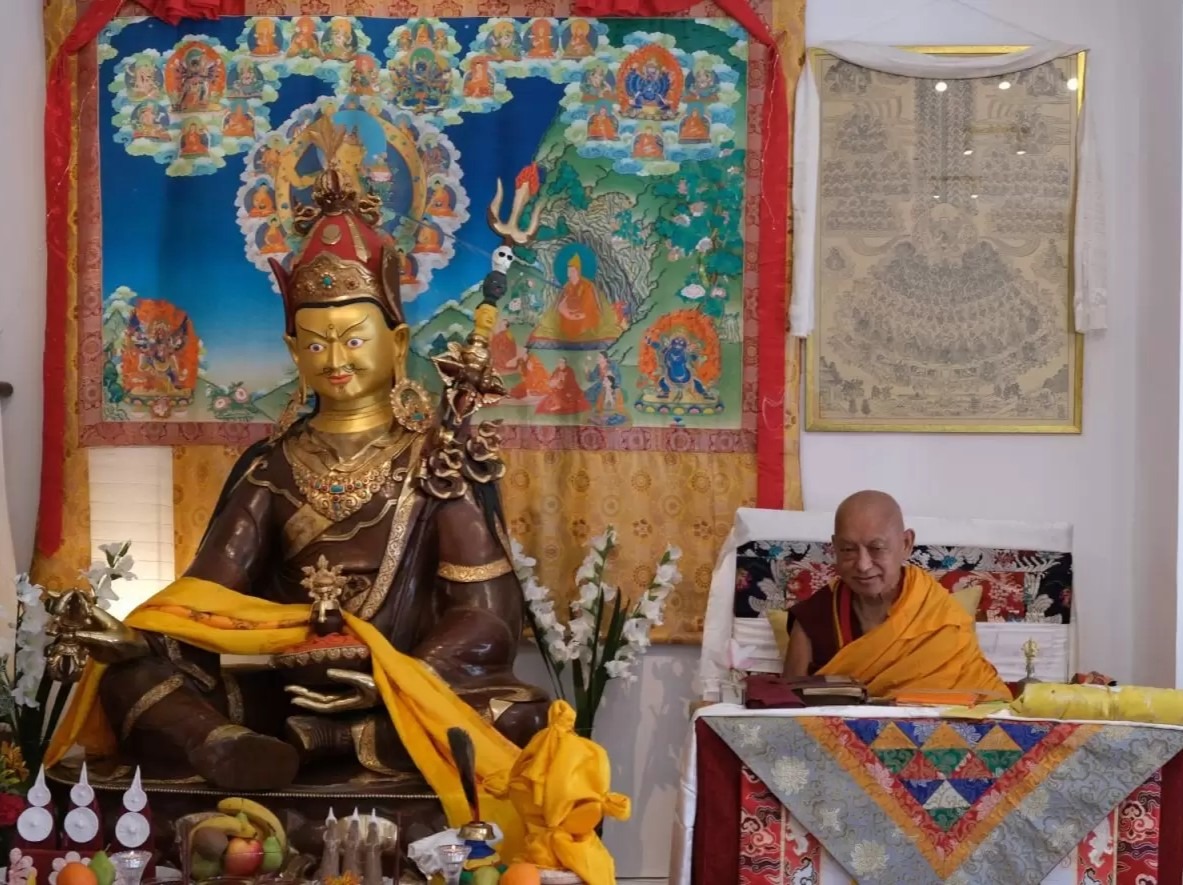
Lama Zopa Rinpoche teaching next to the 6.5 foot Padmasambhava statue at Osel Ling Retreat Center, Spain, May 2019. Photo by Ven. Roger Kunsang.
Padmasambhava Statues for Peace
Building Guru Rinpoche statues will bring immeasurable benefit, peace, happiness, and freedom to the world. They will have immeasurable impact.
—Lama Zopa Rinpoche
Below find a list of statues that have been completed or are in progress, which meet the criteria for Rinpoche's Vast Visions.
Padmasambhava has said that when he no longer abides in Tibet, that his statues will become like lights that dispel the darkness of ignorance. Lama Zopa Rinpoche has compiled the many benefits of building and making offerings to Padmasambhava statues such as The Benefits of Building Padmasambhava Statues and Benefits of Guru Padmasambhava Statues
Statues Completed So Far
To date, 32 statues have been completed with support from the Padmasambhava Project for Peace Fund:
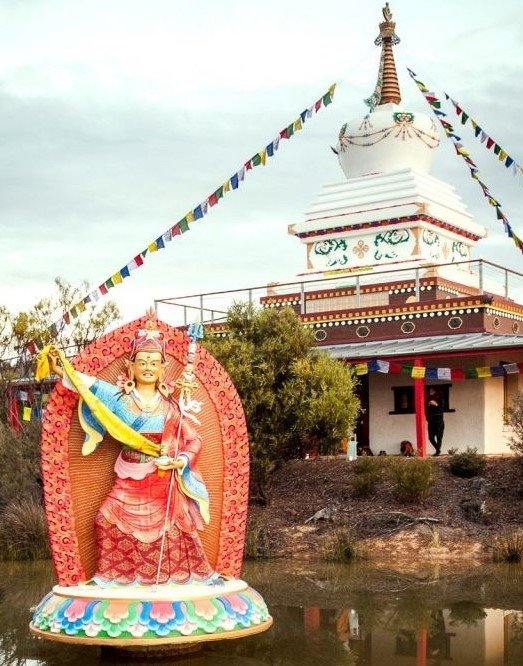
Padmasambhava statue and stupa with reflections on a very still pond at De-Tong Ling retreat center in Australia. Photo by George Manos.
- Large statue at a Sakya Monastery in Asia.
- 5m/16.4ft – Statue at the Great Stupa of Universal Compassion near Bendigo, Australia.
- Life-sized statue at Milarepa Center in Vermont, USA.
- (11 total) One 4.1m/13.5 ft – Statue, three other large statues, and statues of the seven aspects of Guru Rinpoche in Lawudo, Nepal
- (9 total) 21.3m/70ft – Statue with two consorts, each 25 ft; also includes Eight Aspects of Padmasambhava, each over 2m/6ft in Asia
- 2.1m/7ft – Statue at Chandrakirti Tibetan Buddhist Meditation Centre, New Zealand.
- 2.7m/9ft – Statue at De-Tong Ling Retreat Centre, Kangaroo Island, Australia.
- 1m/3ft – Statue in Nepal which will go inside a large stupa in India.
- 3m/9.8ft – Statue at Osel Ling, Spain.
- 1.4m/4.5 ft – Statue at Chag-tong Chen-tong Tibetan Buddhist Meditation Centre, Tasmania, Australia.
- 2m/6.5ft – Statue in semi-wrathful aspect at Nagarjuna Madrid, Spain.
- Life-sized statue in seated aspect at Nalanda Monastery, France.
- 1.5m/5ft – Statue at Kalachakra Centre, France.
- 2.1m/7ft – Statue in Guru Namse aspect at Kopan Monastery, Nepal.
- 2.1m/7ft – Statue at Centro Yamantaka, Colombia
Statue Project in Pokhara
The Project Guru Rinpoche, is currently being undertaken in the beautiful locations of Pokhara, Nepal.
The comprehensive cost of this remarkable project encompasses both land procurement expenses and the construction of a grand monument. The price of acquiring the land amounts to US$2,000,000 while the construction work itself totals US$993,217.84. Situated alongside the esteemed Annapurna Cable Car, the Guru Rinpoche statue, to be erected in Pokhara, will seamlessly blend with the surrounding natural landscape, creating a serene and captivating environment.
Covering a total site area of 3226.38 sq.m (34,728.46 sq.ft), the project includes various features such as a meditation hall capable of accommodating 100 individuals, additional rooms and a prayer hall, a mantra wall, vast green areas, and a magnificent 15-meter-tall statue that gracefully rises 1556.47 meters above sea level. The estimated cost for the statue itself is approximately US$298,625.54.
Following the successful acquisition of the land, the endeavor to secure water for the Pokhara Project commenced on July 24, 2023 following soil testing performed on July 7, 2023. By August 10, 2023 a reliable water source was successfully secured for the Pokhara Project.
Offer Your Support
Make a tax-deductible donation to the Padmasambhava Project for Peace:
Please enjoy this short photo gallery of completed Padmasambhava statues.
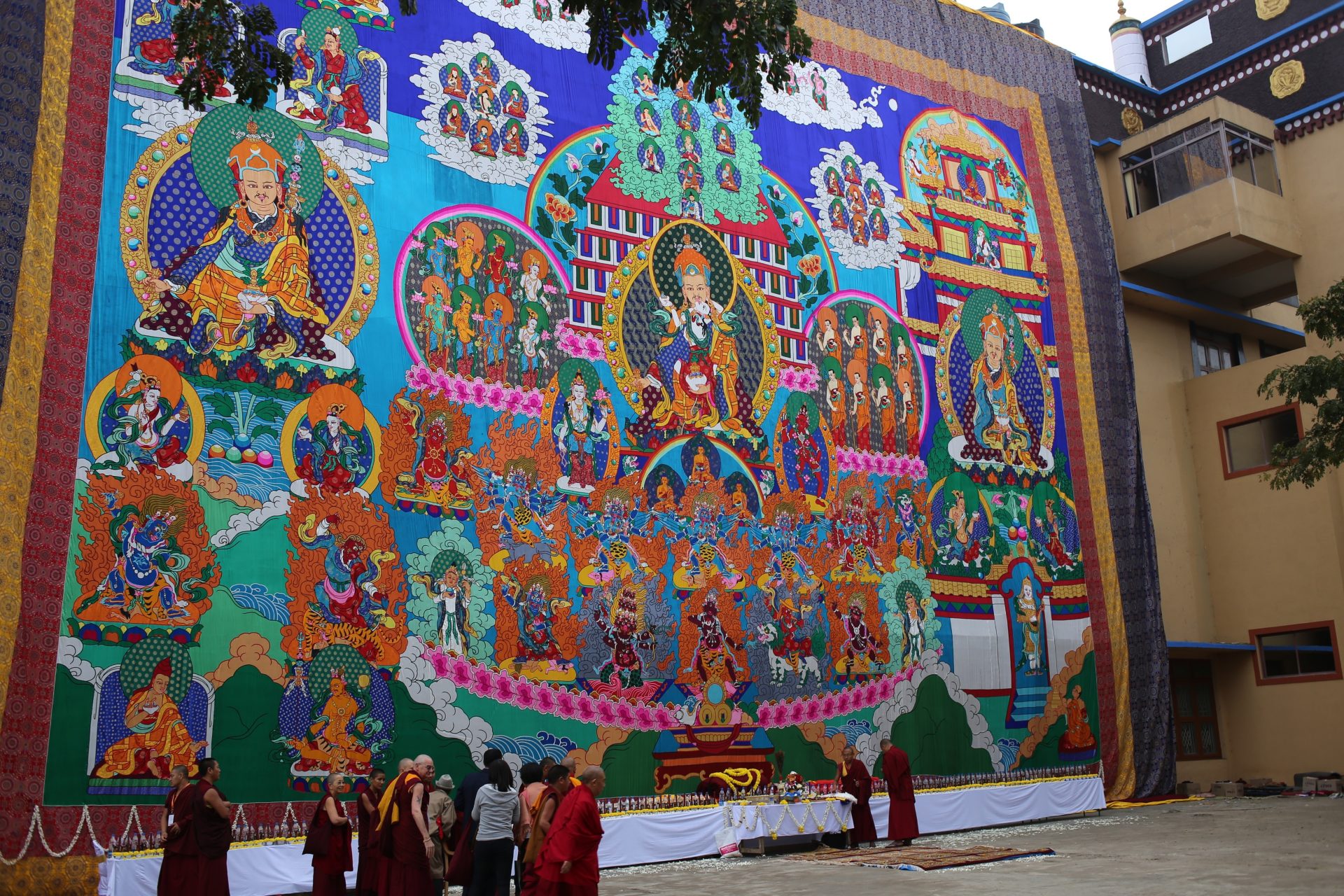
Large thangka of Guru Rinpoche at Kopan. Photo by Ven. Thubten Kunsang.
Large Thangkas Around the World
My wish is for the big centers in FPMT to have these large thangkas." Rinpoche explained. "This is a way to leave imprints for all these people [who see them], for enlightenment.
—Lama Zopa Rinpoche
One of Lama Zopa Rinpoche’s Vast Visions for FPMT is for FPMT centers to display large thangkas and host festival days where these thangkas can be enjoyed. Below find a list of thangkas that have been completed and displayed.
You may think that a statue or thangka is just a statue or thangka, but it is the transcendental wisdom of dharmakaya, which understands and directly sees absolute truth, as well as conventional truth.
—Lama Zopa Rinpoche
Large Thangkas and Festivals Around the World
-
12.2m x 16.7m/55ft x 40ft – Huge stitched appliquéd thangka of Guru Rinpoche, commissioned by Lama Zopa Rinpoche from 2011-2014, through the Lama Zopa Rinpoche Bodhichitta Fund. It is displayed annually at Kopan Nunnery on Lama Zopa Rinpoche’s birthday (December 3) for 100,000 tsog offerings to Guru Rinpoche (Guru Bumtsog).
Amitabha Buddha thangka at Amitabha Buddhist Centre, Singapore.
- Large 1,000-arm Chenrezig thangka at Chenrezig Institute, Australia, displayed at the Festival of Tibet each year and seen by over 5,000 people and is the backdrop to political discussions, meditations, concerts, and dharma talks.
- Large Maitreya thangka at Istituto Lama Tzong Khapa, Italy, displayed during Buddha multiplying days (weather permitting) and during any great occasions at the center.
- 7.3m/24ft – Large Medicine Buddha thangka, painted by Peter Iseli, at Land of Medicine Buddha, CA, USA, is displayed during their Medicine Buddha Festival Day.
- 2.9m/9.5ft – Large Ksitigarbha thangka at Land of Medicine Buddha, CA, USA, displayed during their Ksitigarbha Festival Day.
- 3.5m/11.5ft – Large Vajrasattva and consort thangka at Land of Medicine Buddha, CA, USA. Painted by Peter Iseli.
- 2.1m x 2.7m/7ft x 9ft – Large Tara thangka at Pamtingpa Center, Washington, USA, displayed for their 21 Tara dance offering during the annual Amitabha Buddha Festival at Amitabha Buddha Pure Land, Washington, USA.
- Large Medicine Buddha thangka at Losang Dragpa Centre (LDC), Malaysia, is featured in an annual festival and offerings event.
- 14m x 9m/46ft x 30ft – 21 Tara thangka at Institute Vajrayogini, France.
- Large 35 Buddhas thangka, at Kopan Monastery, Nepal painted by Peter Iseli. Several smaller copies of Peter’s are also used for display at Kopan.
- 2.1m/7ft – Thangka of Chenrezig at Kopan Monastery, Nepal, displayed during Nyung na retreats.
- Large Shakyamuni Buddha thangka at Kopan Monastery, displayed during the Monlam prayer festival.
- 15.2m x 9.4m/50ft x 31ft – Large thangka of Amitabha Buddha in his pure land accompanied by the eight great bodhisattvas, at Amitabha Buddhist Centre, Singapore. Sewn entirely by hand by Tibetan artists in south India. Displayed annually for Vesak Day celebration with extensive light offerings.
- Five-story high 21 Taras thangka, Tara Institute, Melbourne, Australia. Painted by Peter Iseli.
- 2.5m/8ft – Shakyamuni Buddha thangka at Nagarjuna Madrid, Spain, displayed during special events.
- 7.6m x 6m/25ft x 20ft – 21 Taras thangka at displayed with 100,000 light offerings annually at Rinchen Jangsem Ling, Malaysia.
- 5.8m x 19ft – Large Medicine Buddha thangka permanently displayed at Buddha House, Adelaide, Australia.
Offer Your Support
Make a tax-deductible donation to the Holy Objects Fund below:
Please enjoy a photo gallery of many of these large thangkas being created around the world.
- Tagged: large thangka, large thangkas, maitreya, padmasambhava project for peace, padmasambhava statue, prayer wheel fund, prayer wheels, stupa fund, stupas, vast visions
5
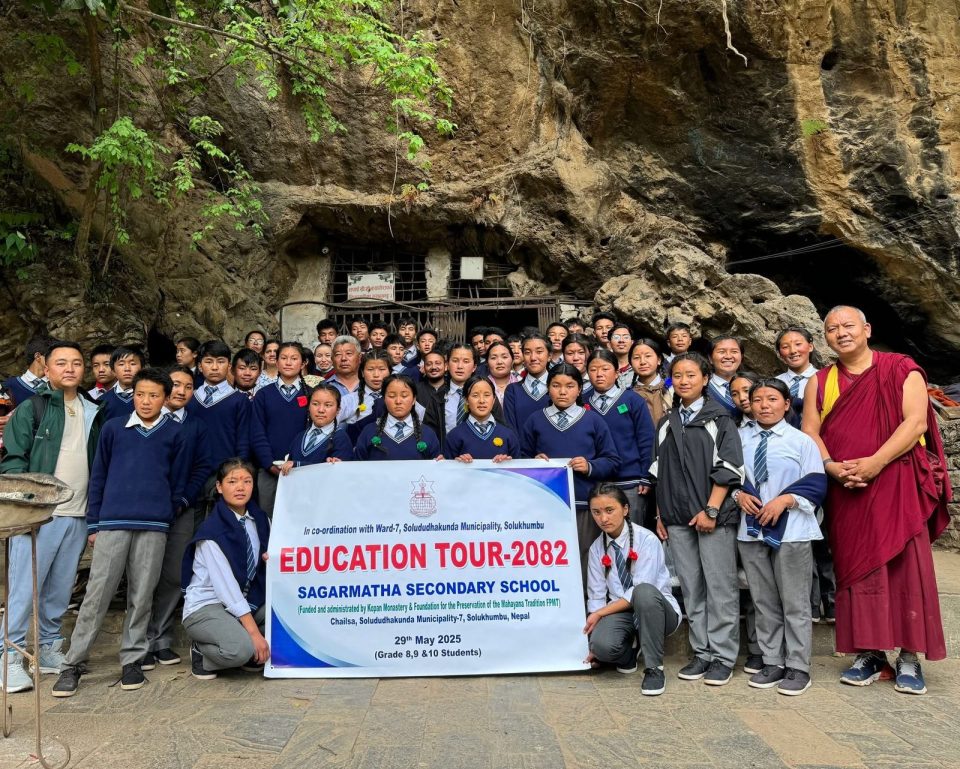
Sagarmatha School children on an educational tour to Maratika Cave, May 2025.
In the remote valleys and small local communities of India and Nepal, education is more than a classroom experience – it is a lifeline to opportunity, cultural preservation, and spiritual growth. FPMT’s Social Services Fund (SSF) continues to play an important role in this journey, offering consistent support to schools that serve children and young monks from Tibetan, Nepali, Sherpa, and Indian backgrounds. By the end of 2025, the SSF will have disbursed a total of US$226,563 across eight schools, reaching over 1,400 students. These grants helped cover essential needs such as nutritious meals, teacher salaries, classroom materials, and cultural activities. Through this support, the SSF not only strengthens access to quality education but also nurtures the values of compassion, wisdom, gratitude, and resilience in the next generation. Please learn below about the schools we are currently supporting, and how the grants were utilized this year.
Sagarmatha Secondary School | Sambhota Tibetan School CVP | Ngari Institute of Buddhist Dialectics | Maitreya School | Rolwaling Sangag Choling Monastery School | Shree Sangka Dechholing Gonpa School | Gaden Jangtse Monastic College |
Tashol Tengyur School | How to Help
Sagarmatha Secondary School, situated in Chailsa, Solukhumbu, Nepal, remains a shining example of holistic education for children from remote Himalayan communities. The school provides free education, uniforms, books, hostel accommodations, and nutritious meals to all students. The Social Services Fund has been supporting the school since 2015. In 2025, a grant was offered to sustain its educational and welfare programs. Currently, the school serves 275 students and is supported by 16 teachers and 2 staff members.
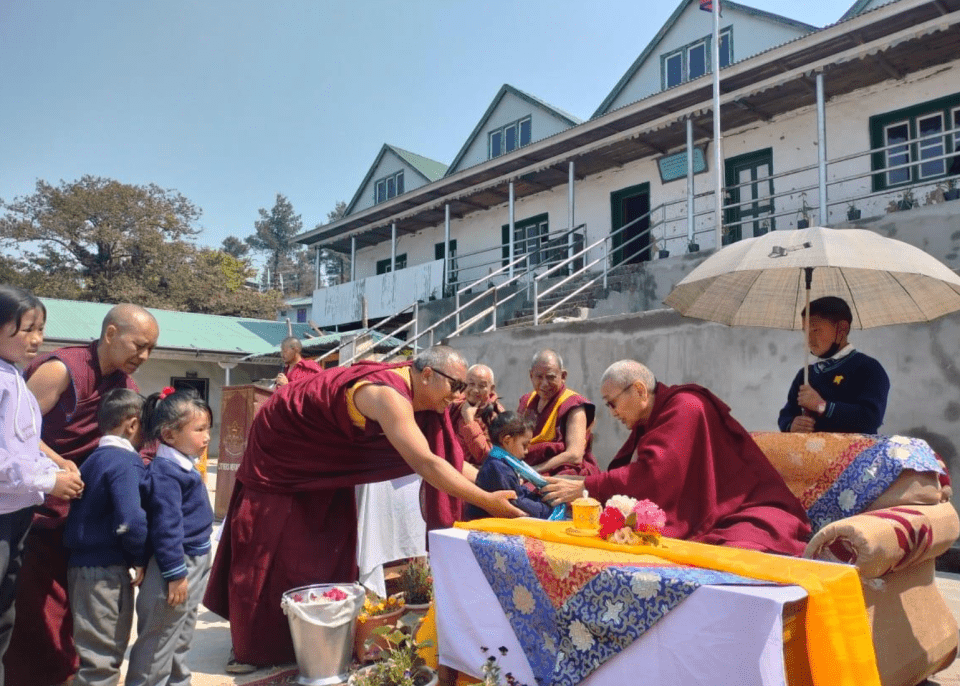
Sagarmatha School children receive blessings from Khenrinpoche Geshe Thubten Chonyi,
the Abbot of Kopan Monastery.
On April 23, 2024, the school hosted guests from Kopan Monastery and Singapore, including Khenrinpoche Geshe Thubten Chonyi, who offered blessings and shared profound insights on the importance of ethical education. Uniforms and books were distributed to students, continuing the tradition of removing financial barriers to learning.
Among other highlights was an educational tour to Maratika Cave (the place where Guru Padmasambhava achieved immortality through meditation and blessings from Amitayus). This pilgrimage offered students a chance to deepen their spiritual understanding and personal growth. A short prayer session was held during the visit, where students expressed heartfelt wishes for the swift return of Lama Zopa Rinpoche.
On July 6, 2025, the school joyfully celebrated the 90th birthday of His Holiness the Dalai Lama. The day began with a traditional Sang-Sol incense offering puja (purification puja), followed by a formal ceremony in the prayer hall. The event brought together geshes, students, teachers, and members of the Chailsa Tibetan settlement. Students showcased their cultural heritage through vibrant performances, reinforcing the school’s commitment to preserving Tibetan identity and values.
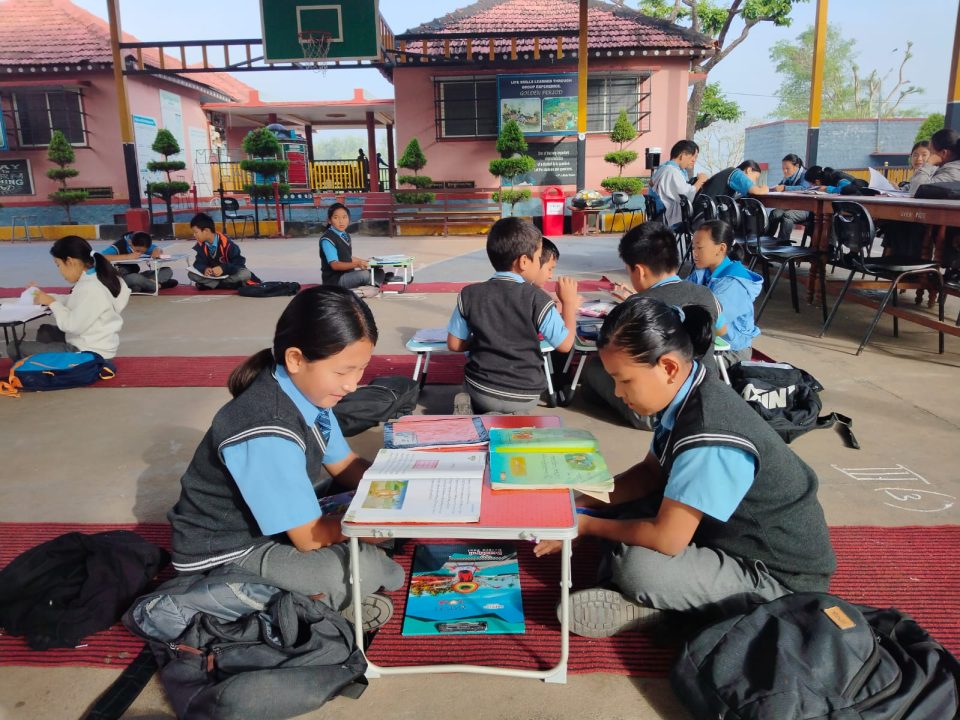
Children at Sambhota School studying together.
The Sambhota Tibetan School CVP Bylakuppe, located in the Tibetan Dickey Larsoe Settlement in Karnataka. Established in 1971, the school currently educates 132 students from classes 1 to 10. Tibetan is the medium of instruction at the primary level, transitioning to English from class six onward. The school is supported by a committed team of 25 teaching and non-teaching staff.
Since 2015, the Social Services Fund has been supporting the school’s vegetarian midday meal program. This initiative has significantly contributed to students’ health, concentration, and academic engagement. In 2025, the SSF again offered a grant to continue this essential program, ensuring that students receive the nourishment they need to thrive academically and personally.
In a letter dated January 2025, Settlement Officer Chime Dorjee expressed deep gratitude for the continued support of the midday meal program, emphasizing its role in enhancing student well-being and learning outcomes.
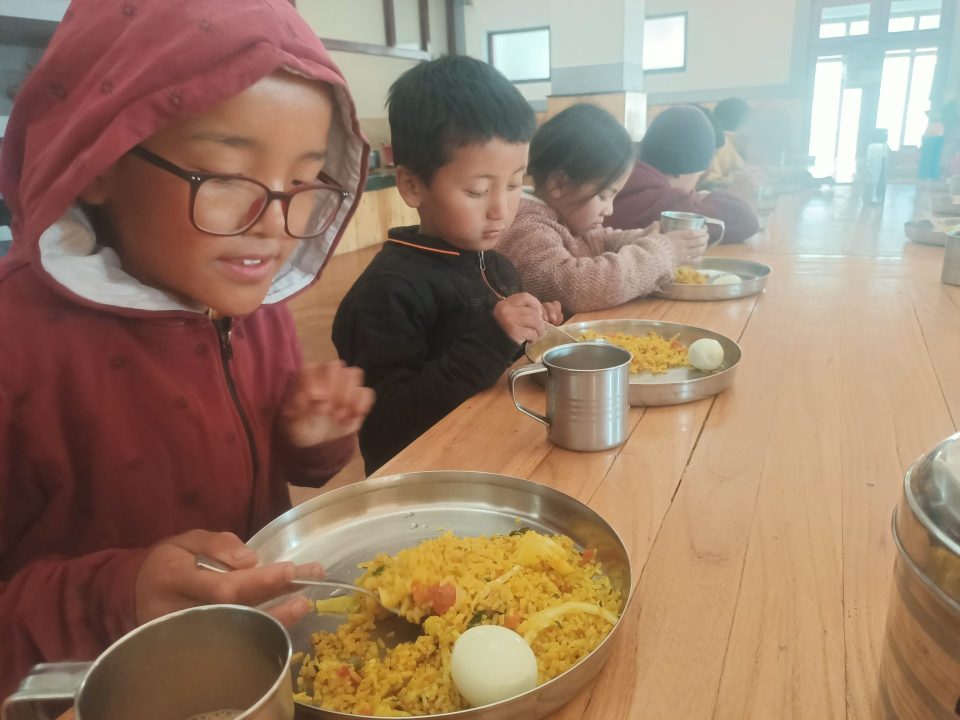
Ngari Institute’s children enjoying a meal.
The Ngari Institute of Buddhist Dialectics, located in Saboo-Do Village, Ladakh, was founded in 2010 under the leadership of Geshe Tsewang Dorje, a Lharampa Geshe graduate from Sera Je Monastery. The institute was established with the vision of preserving the Tibetan Buddhist Nalanda tradition, Tibetan culture, and the unique way of life of the Himalayan people – especially at a time when such traditions face immense challenges inside Tibet.
The institute offers a unique blend of modern education and traditional monastic training, including debate classes, which are rare in Ladakh. Students receive regular schooling during the day and attend additional tuition and monastic classes in the mornings and evenings. This dual approach ensures both academic and spiritual development.
As of 2025, the institute supports 73 students and 22 dedicated staff members, with a long-term goal to serve 200 children. The institute has seen remarkable progress. Students have consistently performed well in government board exams, and alumni have gone on to pursue higher education at institutions like the Dalai Lama Institute for Higher Education. Infrastructure projects are underway, including a Buddha Relics Temple, Girls Hostel Extension, retreat rooms, and an ambitious tree plantation project to green the dry Ladakhi landscape.
Since 2013, the Social Services Fund has been a steadfast supporter of the institute, particularly in funding the daily meal program. This program has been vital in ensuring the health and well-being of both students and staff. For the year 2025, a grant was given to cover the full cost of meals for all students and teachers.
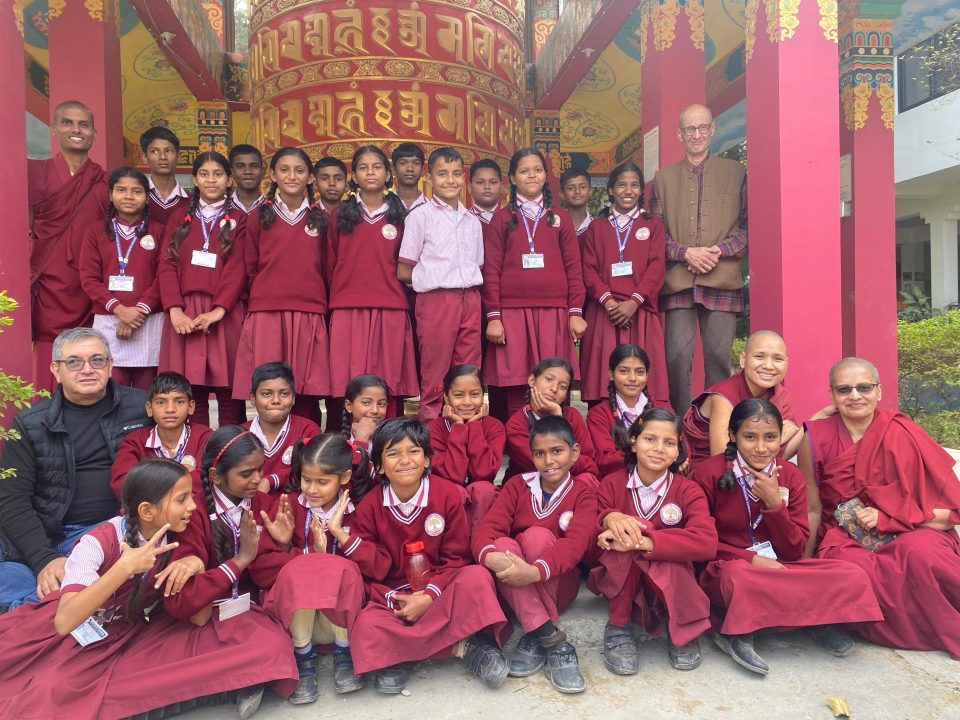
Maitreya School children visiting the Root Institute for Wisdom Culture.
The Maitreya School in Bodhgaya, Bihar, India, continues to serve as an educational sanctuary for children from some of the most underserved communities in the region. Rooted in the compassionate vision of Lama Zopa Rinpoche, the school’s mission transcends conventional academics. It aims to nurture children who are not only intellectually capable but also spiritually grounded and socially responsible.
In 2024–25, the school organized a wide range of enriching activities, including:
- Creative writing, quiz, and speech competitions in Hindi and English, with over 300 participants.
- A pilgrimage to Rajgir, Nalanda, and Pawapuri, where students recited the Heart Sutra alongside international pilgrims.
- A visit to Root Institute for Wisdom Culture, where Class 5 students had an opportunity to explore Buddhist teachings and practice meditation.
The school has also begun meditation classes, introduced group discussions based on the 16 Guidelines for Life (practical methods to incorporate wisdom and compassion into every facet of our daily lives), and is actively transforming its infrastructure. Six new rooms are being renovated for music, dance, drama, yoga, and arts, and plans are underway to develop the rooftop and garden into creative and permaculture-based learning spaces. The library, revitalized by dedicated volunteers, has become a hub of literacy and imagination, where students are learning to read, write, and care for books.
Despite its many successes, the school faced significant challenges. Bihar remains one of India’s most economically disadvantaged states, where poverty, malnutrition, and limited access to quality education are widespread. Many students arrived at school hungry, which severely impacts their ability to learn and thrive. To address this, the school urgently sought support to provide nutritious, protein-rich morning snacks for all students. Additionally, the school plans to offer afternoon tuition support for struggling students. This initiative will be led by three to four additional teachers or alumni, providing both academic help and a small income for former students.
In 2025, the school received a grant from the Social Services Fund that will support its ongoing efforts to provide free, value-based education to 277 children from Lower Kindergarten through Class 8.
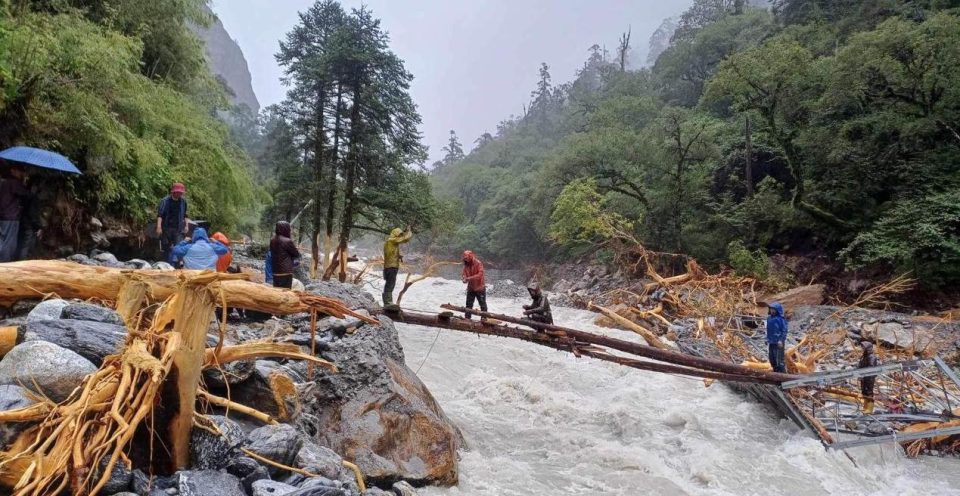
Rolwaling School: Trail repair work in progress.
The Rolwaling Sangag Choling Monastery School, nestled in the Himalayan valley of Rolwaling, Nepal, continues to provide holistic education to 36 students, rooted in Buddhist values, cultural preservation, and compassionate service.
By 2025, the school successfully completed the construction of two winter hostel buildings and a temporary kitchen-dining facility in Lamabagar, enabling year-round education despite the harsh climate. The academic year began in February with the arrival of students and staff, including the enrollment of eight new children from nearby villages. In April, the school community returned to Beding village, where classes will continue through November. Two senior students completed their primary education and traveled to Namdroling Monastery in South India for further studies. The school also organized vocational training in hospitality, bakery, and barista skills for fifteen local women, empowering them with practical livelihood skills. Throughout the year, students actively participated in traditional ceremonies, preserving the spiritual and cultural heritage of the Rolwaling valley.
Among their many impactful initiatives, two stand out:
Protection of Yaks in Rolwaling
In alignment with the vision of Kyabje Lama Zopa Rinpoche, the school continues to support the protection and care of over 108 rescued yaks. These animals were originally saved from slaughter in Solukhumbu and brought to Rolwaling by crossing the Yalung La Pass. Today, they roam freely in the valley, where the local Sherpa community strictly forbids the killing or selling of animals. The school founder, Ngawang Labsum Rinpoche, along with students, regularly visits the grazing areas and ensure their well-being. A dedicated herder has been employed to protect the yaks from mountain wolves, reinforcing the school’s commitment to animal liberation and environmental stewardship.
Trail Maintenance and Emergency Relief
On July 5, 2024, a devastating flash flood struck the Rolwaling valley, destroying over 10 kilometers (6 miles) of trail, sweeping away four bridges. In response, the school and monastery mobilized immediate relief efforts. They led the reopening of trails, provided emergency support to affected families, and constructed temporary shelters for travelers.
In 2025, the school received a grant from the Social Services Fund for the school operations and for classroom furniture and beds for the winter school in Lamabagar.
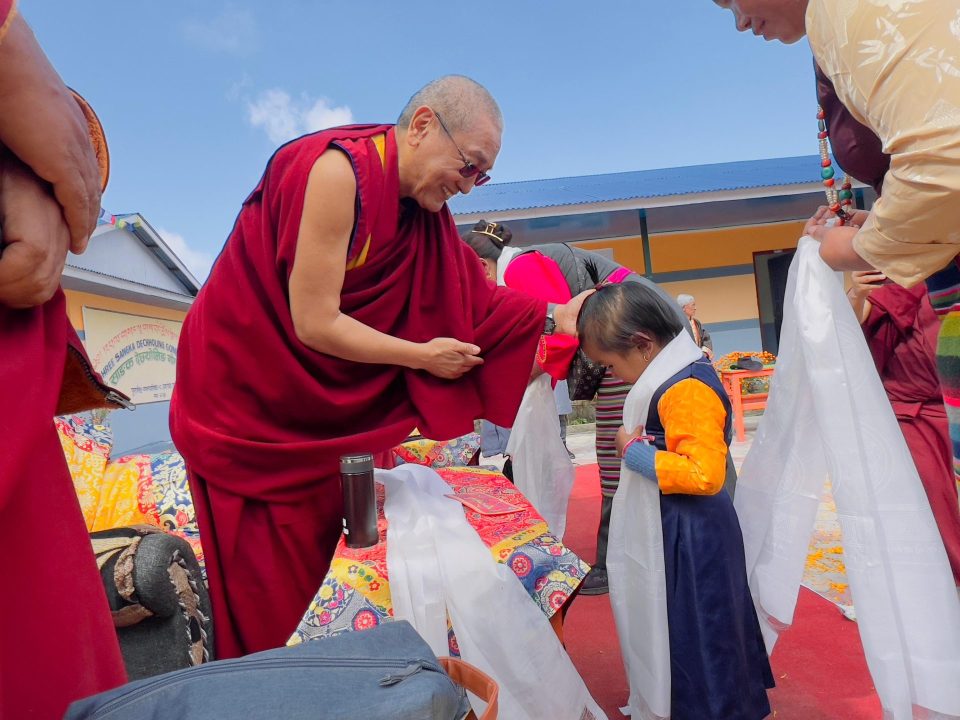
Shree Sangka Dechholing Gonpa School children receive blessings from Khenrinpoche Geshe Thubten Chonyi, the Abbot of Kopan Monastery.
The Shree Sangka Dechholing Gonpa School, situated in Taplejung, Nepal, is making significant progress in offering comprehensive education to children in the area. Established in 2007 and affiliated with the National Examination Board (NEB), the school currently serves 171 students with the support of 16 dedicated teachers.
The school’s core vision is to integrate modern academic instruction with moral and spiritual education under the guidance of Kopan Monastery. This approach aims to nurture students into not only academically capable individuals but also responsible and compassionate people.
In 2024, the school achieved praiseworthy academic results, with students excelling in Mathematics, Science, and Social Studies. Beyond academics, the school has placed strong emphasis on extracurricular development such as the inter-school football competition and cultural dance, quiz competitions, reflecting children’s diverse talents and enthusiasm.
Infrastructure-wise, the school comprises four buildings with 18 classrooms, a stupa, a prayer wheel, six washrooms, a dining and kitchen facility, and a large playground that supports inter-school sports events. These facilities create a well-rounded environment for both academic and personal growth. Additionally, the school’s commitment to its staff is evident in its structured salary system, which includes a 13-month pay scale and government-aligned compensation. This ensures stability and motivation among the teaching and administrative team.
In 2025, the grant given supported its ongoing educational mission.
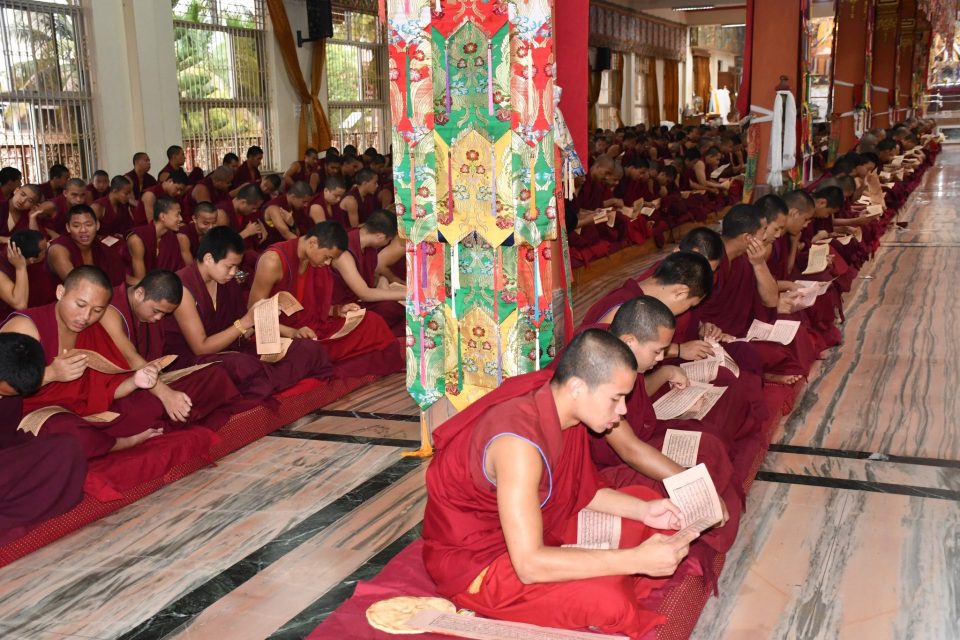
Gaden Jangtse Monastery (source: Gaden Jangtse Monastery Facebook page).
The Gaden Jangtse Monastic College, re-established in 1969 in Mundgod, South India, is a renowned institution within the Gelug lineage of Tibetan Buddhism, dedicated to the preservation and transmission of Buddhist philosophy, scripture, debate, and meditation. As part of its broader educational mission, the Gaden Jangtse School serves as a vital platform for educating young monks, ensuring they receive both traditional monastic training and formal academic education.
The school currently supports approximately 500 monk students and employs 13 salaried teachers, with additional support from senior monks who volunteer as tutors. These teachers play a crucial role in shaping the intellectual and spiritual development of the next generation of Buddhist scholars and practitioners.
In 2025, the grant provided supported the annual salaries of the school’s teachers. This funding is essential to maintain the quality and continuity of education at the school, especially as it aligns with the guidance of His Holiness the 14th Dalai Lama, who has encouraged the integration of monastic education with the Indian secondary school system. This allows monk students to receive recognized academic qualifications alongside their spiritual training.
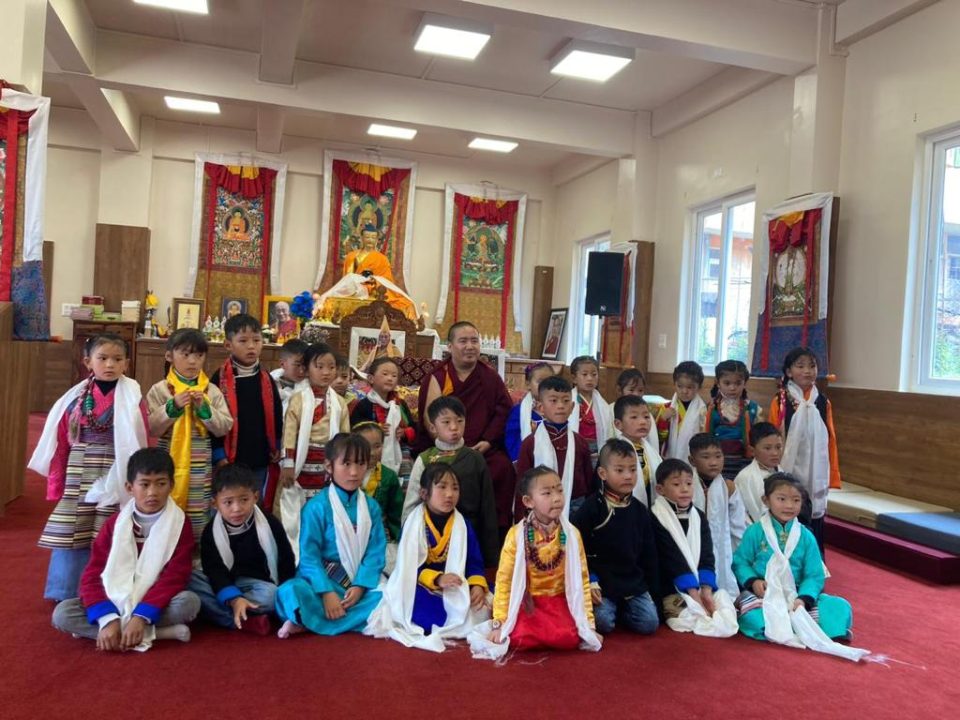
Tashol Tengyur School children with Tenzin Gyurmey Rinpoche.
The Thubten Shedrubling Foundation, a Gelug Buddhist Center founded in 2014 by Tenzin Gyurmey Rinpoche in Tawang, Arunachal Pradesh, is dedicated to preserving and promoting Tibetan Buddhism and culture through education. The Foundation’s vision aligns with the aspirations of Lama Zopa Rinpoche and Lama Yeshe to spread the Dharma and expand Universal Education Programs.
Over the years, the Foundation has offered free courses in English, computer literacy, Tibetan language, and Buddhism to both adults and children, benefiting over 600 individuals. It has also hosted workshops on secular ethics and teachings by Tibetan lamas, building a vibrant community of around 100 active members.
In 2023, the Foundation launched the Tashol Tengyur School, a Buddhist primary school that admitted 30 first-grade students and provided a well-rounded curriculum including Tibetan and English languages, mathematics, physical education, and morning prayers. Despite its success and positive feedback from parents, the school had to close due to challenges in retaining qualified teachers in the remote and climatically harsh region of Tawang.
In 2025, a grant from the SSF was given for the first time, The Foundation plans to resume its educational programs with renewed focus. The funding will support salaries and operational costs for a two-year initiative that includes:
- For children: Out-of-school and weekend classes in Tibetan language, Buddhism, and Social Emotional Ethical Learning (SEEL), each offered three times a week.
- For adults: Introductory and intermediate Buddhism classes held six times a week, Tibetan language classes three times a week, and regular pujas on holy days.
The Social Services Fund remains a source of hope and opportunity for children and monastic students in some of the most isolated and under-served areas of India and Nepal. Thank you so much to all our kind donors, as well as Yeshe Norbu Association and Unione Buddhista Italiana (U.B.I.), who make these grants possible and provide these young learners with not just an academic education but also spiritual guidance and emotional support based on Buddhist principles. This support has a profound impact, empowering future generations to become compassionate, capable, and culturally aware individuals.
All are welcome to offer toward the Social Services Fund, to support the education of those who are truly vulnerable and in need in India and Nepal.
The Social Services Fund, established to support Lama Zopa Rinpoche’s Vast Visions for the FPMT organization, focuses efforts primarily in India, Nepal, Tibet and Mongolia. Funds help children, the elderly, sick, and very poor.
- Tagged: 16 guidelines, gaden jangtse monastic college, maitreya school, ngari institute of buddhist dialectics, rolwaling sangag choling monastery school, sagarmatha secondary school, Sambhota Tibetan School CVP Bylakuppe, schools, shree sangka dhechholing gonpa school, tashol tengyur school, thubten shedrupling foundation
- Home
- News/Media
- Study & Practice
- About FPMT Education Services
- Latest News
- Programs
- New to Buddhism?
- Buddhist Mind Science: Activating Your Potential
- Heart Advice for Death and Dying
- Discovering Buddhism
- Living in the Path
- Exploring Buddhism
- FPMT Basic Program
- FPMT Masters Program
- FPMT In-Depth Meditation Training
- Maitripa College
- Lotsawa Rinchen Zangpo Translator Program
- Universal Education for Compassion & Wisdom
- Online Learning Center
- Prayers & Practice Materials
- Overview of Prayers & Practices
- Full Catalogue of Prayers & Practice Materials
- Explore Popular Topics
- Benefiting Animals
- Chenrezig Resources
- Death & Dying Resources
- Lama Chopa (Guru Puja)
- Lama Zopa Rinpoche: Compendium of Precious Instructions
- Lama Zopa Rinpoche: Life Practice Advice
- Lama Zopa Rinpoche Practice Series
- Lamrim Resources
- Mantras
- Prayer Book Updates
- Purification Practices
- Sutras
- Thought Transformation (Lojong)
- Audio Materials
- Dharma Dates – Tibetan Calendar
- Translation Services
- Publishing Services
- Teachings and Advice
- Find Teachings and Advice
- Lama Zopa Rinpoche Advice Page
- Lama Zopa Rinpoche: Compendium of Precious Instructions
- Lama Zopa Rinpoche Video Teachings
- ༧སྐྱབས་རྗེ་བཟོད་པ་རིན་པོ་ཆེ་མཆོག་ནས་སྩལ་བའི་བཀའ་སློབ་བརྙན་འཕྲིན།
- Podcasts
- Lama Yeshe Wisdom Archive
- Buddhism FAQ
- Dharma for Young People
- Resources on Holy Objects
- Ways to Offer Support
- Centers
- Affiliates Area
- Teachers
- Projects
- Charitable Projects
- Make a Donation
- Applying for Grants
- News about Projects
- Other Projects within FPMT
- Support International Office
- Projects Photo Galleries
- Give Where Most Needed
- FPMT
- Shop
Translate*
*powered by Google TranslateTranslation of pages on fpmt.org is performed by Google Translate, a third party service which FPMT has no control over. The service provides automated computer translations that are only an approximation of the websites' original content. The translations should not be considered exact and only used as a rough guide.True religion should be the pursuit of self-realization, not an exercise in the accumulation of facts.







